Cataclismo was provided by Hooded Horse for review. Thank you!
A LCD Steam Deck was used for this review. OLED testing will follow.
Cataclismo is in early access, so performance and content is subject to changes.
Indie publisher Hooded Horse shows no signs of slowing down, and their most recent acquisition, Digital Sun, has released a brand new title with them. From the makers of Moonlighter, Cataclismo is a fascinating little title that offers a lot. While I found Moonlighter a little stale at times, I loved the creative design that went into it. Combining a dungeon crawler with running a little shop was a fantastic idea, and Digital Sun brought that same creativity into their new game.
When I first learned about Cataclismo during Summer Game Fest, its setting and unique mechanics caught my interest immediately. Still, the base-building RTS set in a dark, apocalyptic hellscape with Lego-esque building mechanics makes it more complex than many rivals, and even though it is in early access, it boasts polish and content with 11 campaign missions, skirmish and free build mode, and even Steam Workshop support. After spending time with the different modes available, I can happily recommend it, and apart from some minor annoying issues, it is enjoyable on the Steam Deck.
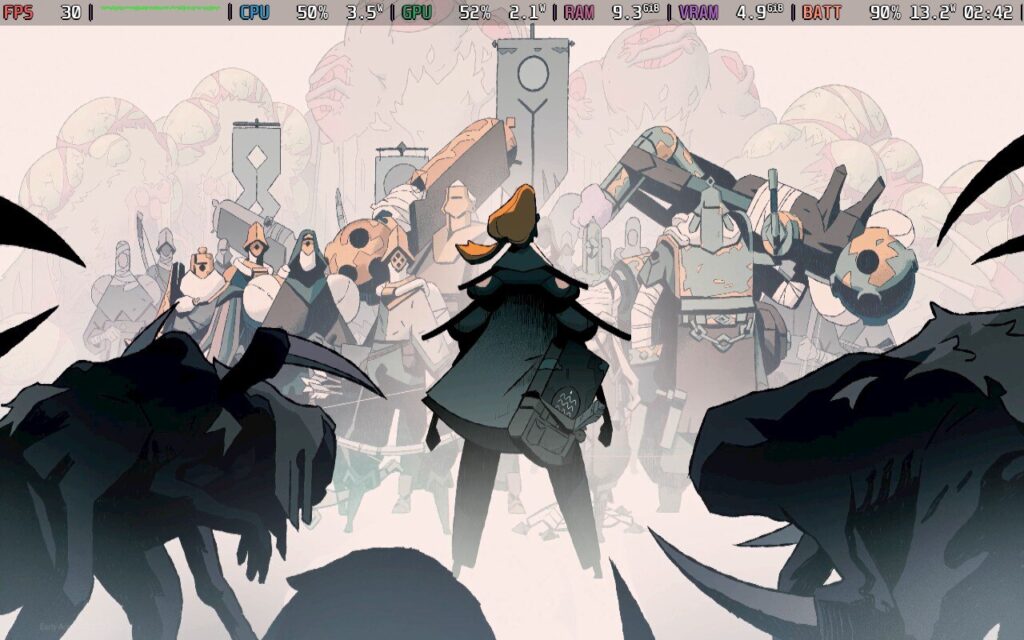
In this post-apocalyptic world, mankind is barely clinging to life after the realm is engulfed by a cataclysm known as Cataclismo, a demonic fog that covers the land. With hordes of terrifying horrors hunting down humanity, the fragile survivors hold out in small citadels, desperately trying to survive. It is a great example of a story told through game design. Everything from character movement to building a citadel makes sense in the world’s lore, and the voice acting breathes life into the tale.
Currently, I consider Cataclismo’s campaign an extended tutorial alongside the story. As much as I enjoy this approach, I would appreciate a separate mode to learn the game. I usually avoid incomplete story games in Early Access because a lot can change during development. Still, I will say that the cutscenes in the campaign are incredibly well done. Despite it being incomplete, I recommend playing through what’s currently available. You will learn to play the game better and enjoy a decent narrative.
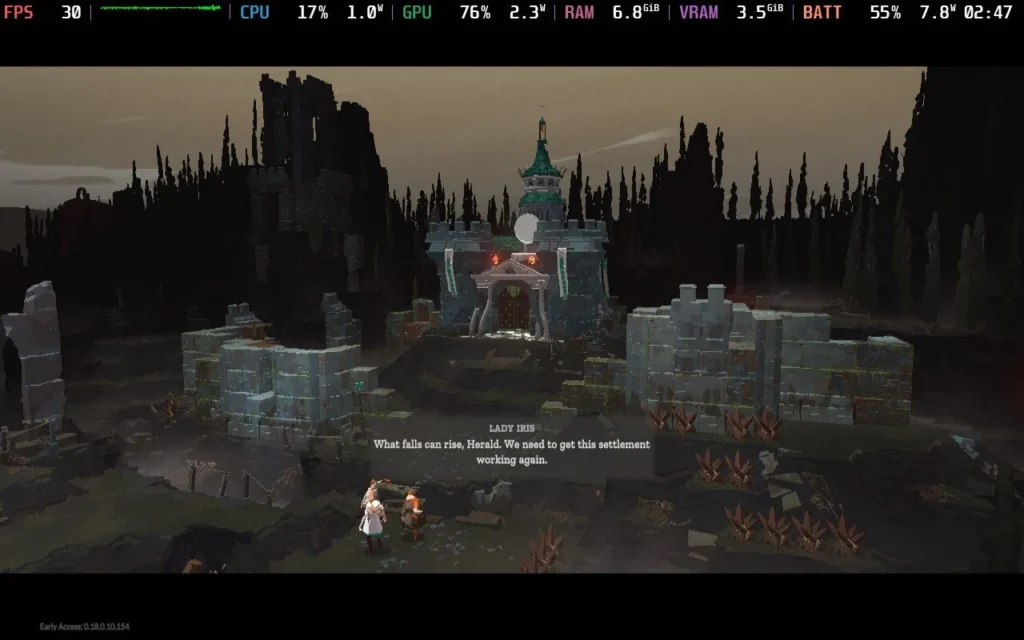
Real challenges exist as a real-time strategy game that combines freeform building with tower defense combat. While you do not need to micromanage workers to collect resources, buildings must be built so workers can always access them. Logistics matters in this game, and if you’re like me, you need to be careful what pathways you build. When I built a quarry, I was caught out a few times and wondered why my workers weren’t mining stone. I discovered they could not get up the cliff: the path I had made for them was wrong! When I fixed it, a swarm of horrors attacked my Citadel, forcing me to retry. Oops.
Oh, and that demonic fog I mentioned? It impacts gameplay, too. Your surviving colony needs clean air, and building air filters to reach the clean air is essential. All the freeform building blocks available to the player come into play as you need to make platforms and elevations for everything from defenses to cleaner air filtering. Weather conditions will impact your survival later, so planning will be very important.
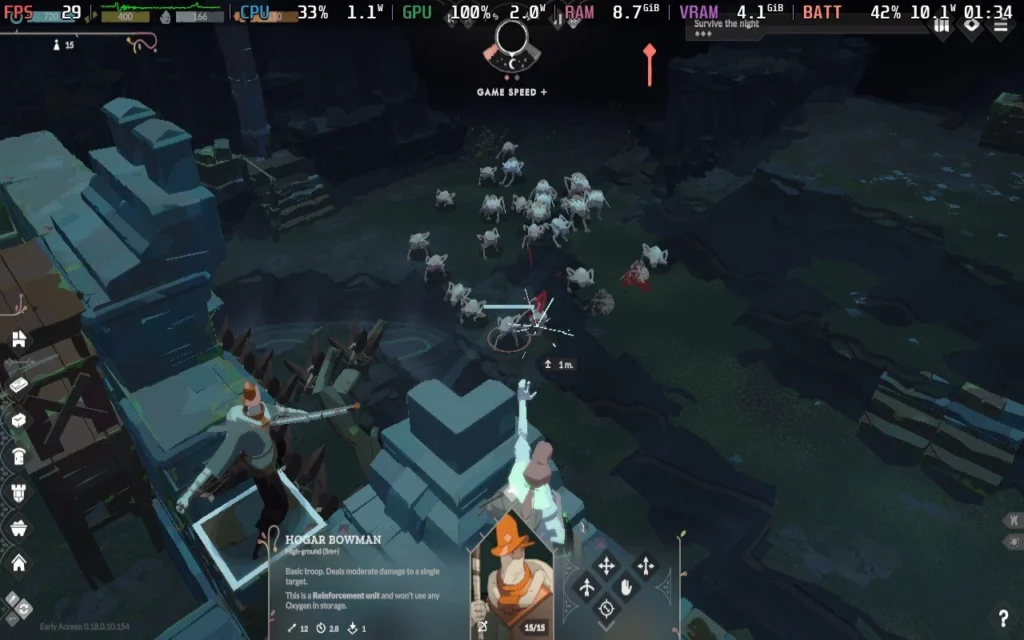
Then, we have the combat, where the tower defense comes in. While you build defensive positions and train units, the enemy throws themselves at you in increasing numbers. Fortifying walls, setting up chokepoints, arming traps, and using your soldiers effectively are all vital for survival. These enemies bring down unfortified walls quickly, and I found the frantic defense of my Citadel deeply engaging. It’s not easy, but the gameplay is balanced between challenging and frustrating. I must also mention the sound design because the ominous music and ghoulish sounds help set the scene.
One of Cataclismo’s biggest strengths for Early Access is the map editor. Access to this is one of the most important features in the genre, so I’m delighted we’re able to make our maps already. I played a little with it on PC and the Deck and had fun! You can create skirmish maps and endless modes with a fair amount of customization:
On the technical side, I encountered a couple of bugs. Occasionally, my units got snagged on parts of the terrain, and I had one nasty crash on Mission 4 that erased all my progress. While the save was salvaged on my laptop, it would not register on the Steam Deck despite the cloud saves. I wasn’t able to replicate the crash, and it did not take me too long to get back to where I was, but I expect a couple of teething issues.
I’m also not a fan of the lack of manual saving, but the auto-saving feature feels robust, and you can rewind days if something goes wrong.
Cataclismo’s performance on the Steam Deck is somewhat of a mixed bag, although not in the way you might think. As usual, I began with an unmodified Deck setup. With 60hz, unlocked TDP, a native 1280x800 resolution, and graphics on Low, I achieved a steady 60FPS across the board. With the unlocked TDP, Cataclismo is fairly kind on the Steam Deck’s hardware, but I switched to a 40hz refresh rate fairly quickly to improve battery life. You can tweak a few settings in-game, including environmental detail, shadows, anti-aliasing, and v-sync. With the Steam Deck’s screen, I found little visual benefit in turning graphical settings above Medium at most.
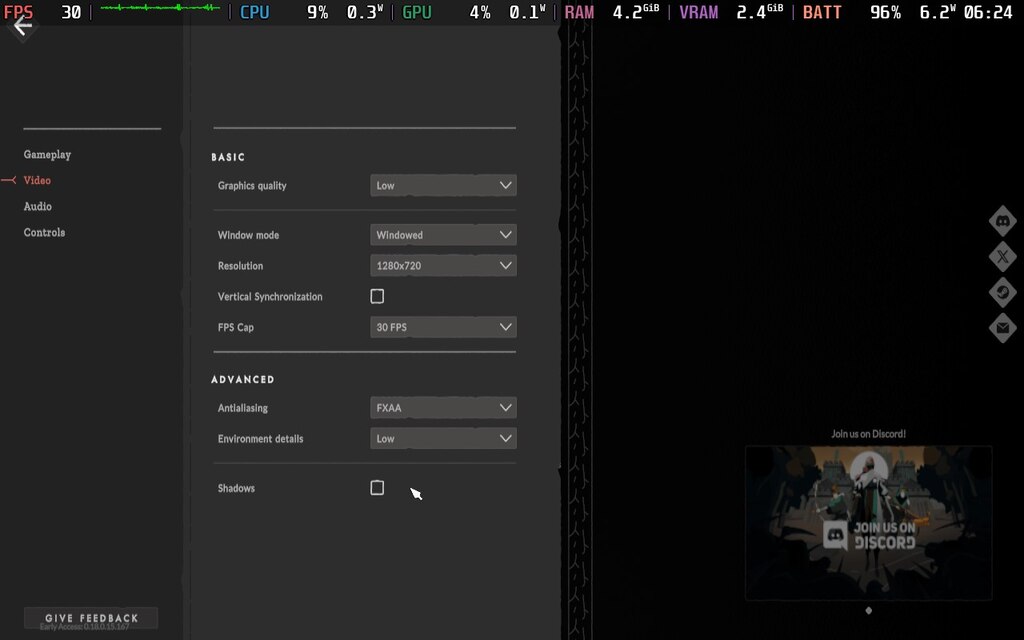
As someone who loves squeezing as much battery life as possible, I began tinkering with settings. Unlike many other games I’ve tested, Cataclismo does not benefit much from a lower TDP. By turning off shadows and bringing all the settings to their minimum, I could reduce the TDP limit to 5 and maintain a reasonable 30FPS with the in-built frame limiter set to 30 (Vsync off). With that, I found an average power draw of 10 watts. The battery savings were helpful, but I don’t see much of an advantage in limiting TDP to that. For science, I tried 3w TDP but found it unplayable. Either keep it at 5 or just leave the TDP untouched, which is my recommendation. This is Early Access, so optimizations might improve performance down the line.
Despite running at an unlocked TDP, Cataclismo is not too harsh on the battery life. With the standard settings and a 40hz refresh rate, it managed an average power draw of 11 watts, with occasional spikes to 12 and 13w during intense attacks by dozens of horrors. Overall, it's not bad! This translated to an estimated 3.5 hours of battery life for the LCD Steam Deck I own. I expect a modest improvement in battery life for the OLED model. This ended up being my preferred way to play for the extra smoothness.
There is no controller support for Cataclismo. The controls are functional with the Mouse and WASD controller profile, although you might want to tweak mouse sensitivity. Trying to navigate narrow pathways for your economy took some getting used to. I also recommend setting the Q/E keys to the back buttons on your Steam Deck to enable camera panning.
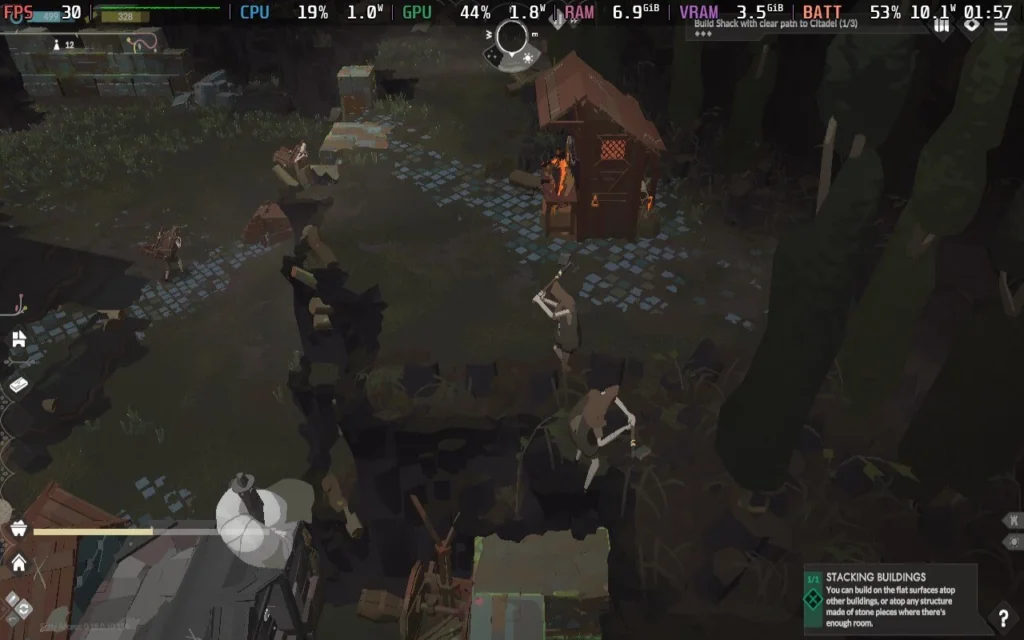
I found reading dialogue and text difficult on the Steam Deck, and there was no way to change the interface size or font. While this is a problem, I would not go as far as to call it unplayable. I could still play the game reasonably well, but it is something to mention. Between that and the lack of built-in controller support, Cataclismo requires a little maintenance to work.
Cataclismo is playable in English, French, German, Spanish, Japanese, Korean, Russian, Portuguese, Traditional Chinese, and Simplified Chinese.
You can change screen resolution, invert the X and Y axis, and change the cursor sensitivity. The recycle mode activation can also be toggled on or off, and an automatic pause can be turned on for a building’s requirements. The camera has a wide range of control in general settings as well.
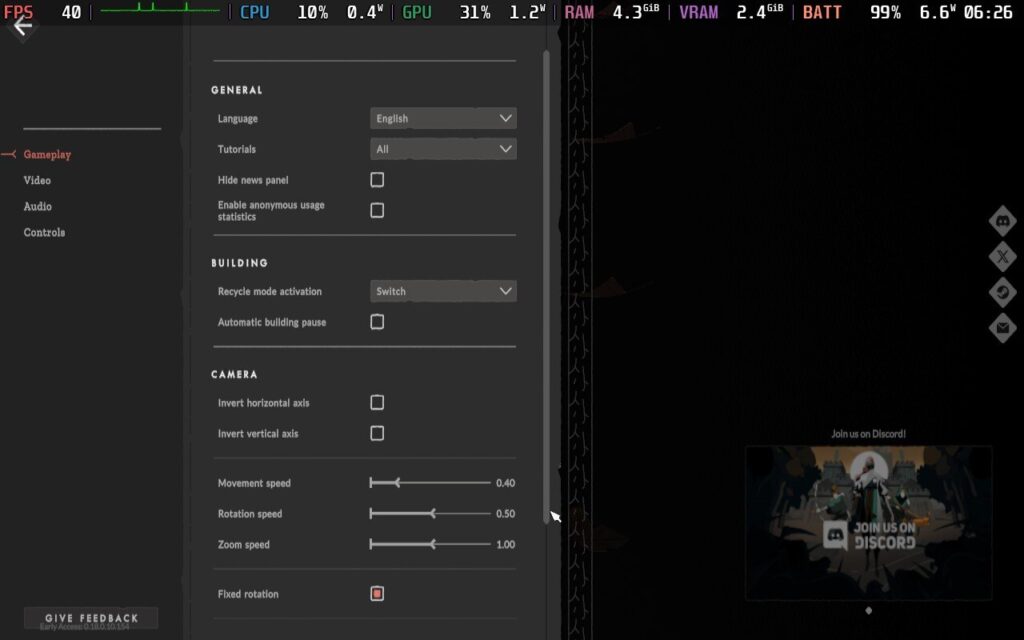
There are no options for colorblind support, and the interface cannot be changed.
Overall, Cataclismo makes an impressive package. With solid worldbuilding through gameplay, the modular way you can build fortresses, and a fair amount of starting content, Digital Sun has come out of the gates swinging with Cataclismo, and I am looking forward to seeing where development will head. Despite some small text frustrations and the lack of controller support, I would still recommend Cataclismo for the Steam Deck with the caveats mentioned. Even with the lack of controller support, I could navigate the game fairly well. With Hooded Horse backing them, I have high hopes for Cataclismo and Digital Sun.
Our review is based on the PC version of this game.
If you enjoyed this review, be sure to check out the rest of the content on SteamDeckHQ! We have a wide variety of game reviews and news that are sure to help your gaming experience. Whether you're looking for news, tips and tutorials, game settings and reviews, or just want to stay up-to-date on the latest trends, we've got your back.
Norland was provided by Hooded Horse for review. Thank you!
This review used an LCD Steam Deck. OLED details will be coming later.
Norland may look like one of the many games following the line of Rimworld to get a chance of success, but it's one of the most unique games you'll find right now. With a heavy focus on diplomacy and management ahead of individual citizens, Norland bridges the gap between Rimworld and a full-on city-builder, and I'm here for it.
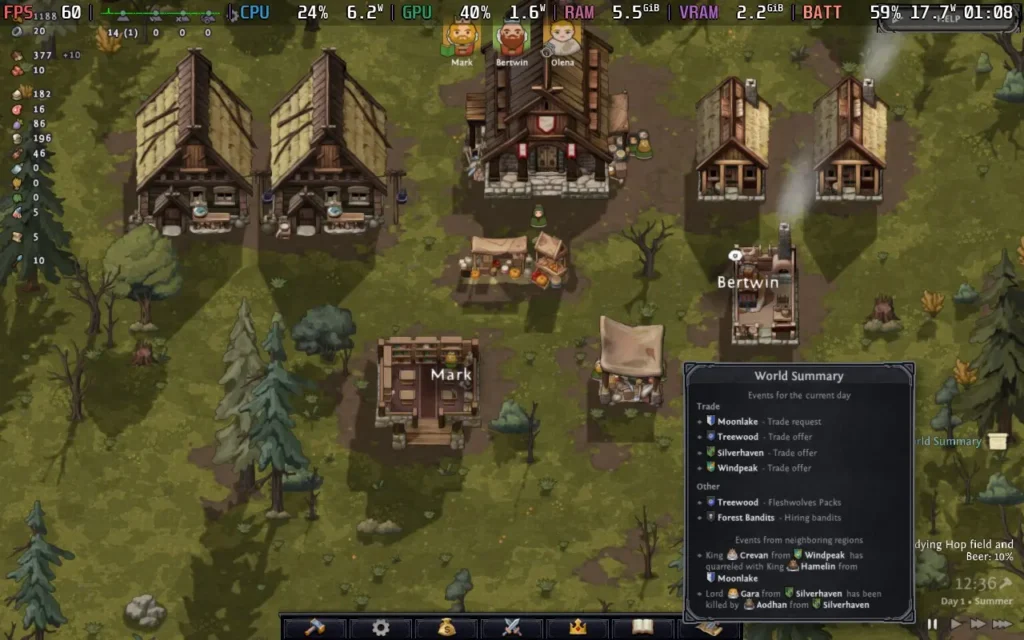
Norland puts you in the role of a King, overseeing his... well, kingdom. Unlike Rimworld, only certain individuals in the settlement, known as "Lords," are under your control. The general populace, whether peasants, slaves, or warriors, are not controlled directly by you but will follow the direction of your Lords. So, if you place a Lord in charge of a logging camp, they will direct peasants to work there.
This is one of Norland's many balancing acts it asks you to perform: choosing Lords who are skilled at management but not overworking them. Workplaces need to be given regular instruction, but there are only so many hours in the day, so you need to balance your Lord's workload so that they can get everything done. But even the Lords are somewhat semi-autonomous. If their mood is low or they have multiple tasks to complete, it's mostly up to them what order they choose to do their tasks or if they even do them.
There's always the worry in autonomous games like this that the AI won't behave how you want it to, or a glitch such as a peasant or Lord forgetting to eat/drink causes you to lose. While, at times, Norland's AI seems to prioritize the wrong things, leaving urgent matters unattended for a short while, it always rectifies itself in the end. I never lost or had a serious issue due to the AI not working properly. If I had food and alcohol, the characters would eventually eat, even if their hunger was at a dangerous level.
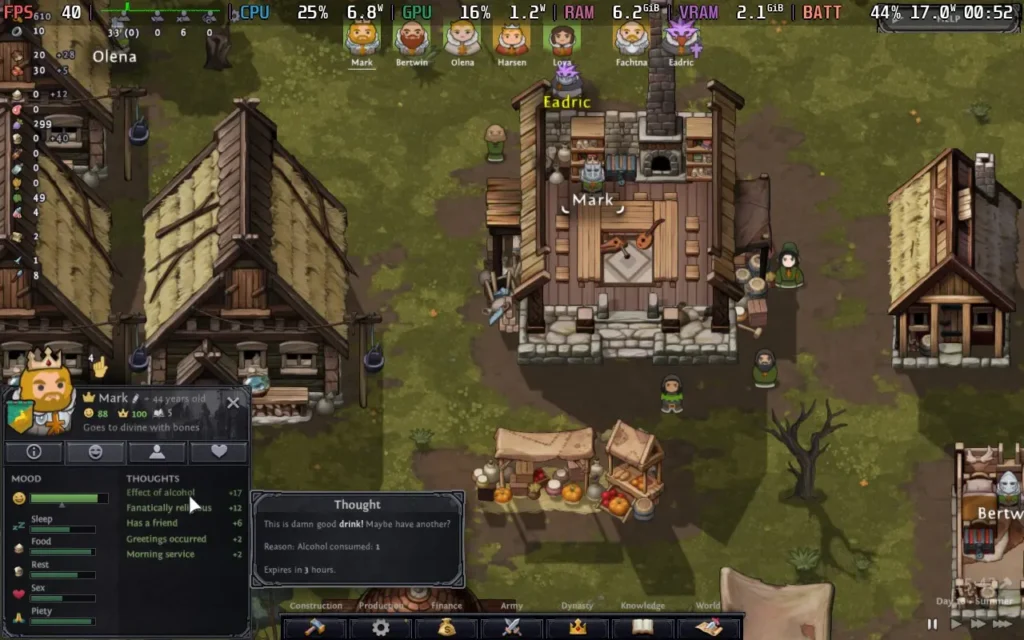
Progression is largely determined by the size of your population and the "knowledge" that your Lords acquire. Buying books from the trader who visits every couple of days will let you teach your Lords new building schematics. But if that Lord dies, any knowledge they had will be lost, so you won't be able to build that building anymore, so it's a good idea to teach a few Lords the schematics so you don't lose access to buildings. And of course, you'll need the workforce to man all these workplaces, so encouraging migrants from nearby villages to have enough housing and an appealing settlement is important too.
A lot of your time in Norland will be spent juggling your settlement's economy and your peasant's mood. Peasants want a variety of food and alcohol available to them. And they have to pay for their food and alcohol at the town's market using the wages you give them. This means it's on you to balance the cost of food and drink in your settlement and the worker's wages. You can pay them more so they can have everything they want if you can afford it. Or give them meager wages, just enough to live on, but you might risk a rebel uprising if their mood falls too far.
You also have to make sure your production chains are up to the task of feeding your population. Alcohol, for example, requires a hop farm, a brewery, and finally, a Tavern to distribute the ale. You'll need to make sure you're producing enough alcohol to satisfy your population, or else you'll have trouble on your hands. Your citizens have other needs, too, such as piety, requiring you to build a temple, hold sermons, and rest, so don't work your populace too hard. All the characters also have sexual needs, but that's mostly automated.
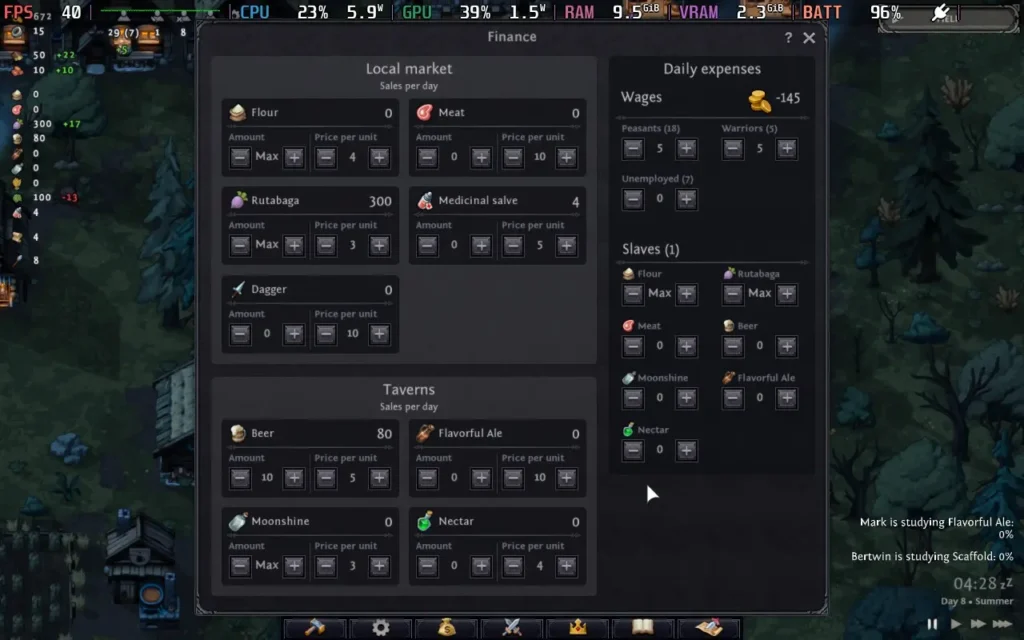
Besides internal troubles that may arise among your peasants, such as a religious uprising, slave uprising, peasant rebellion, peasants turning into criminals, assassinations, you know, the usual good stuff, you might also have to compete with challenges presented by your neighboring kingdoms.
If you have a weak army, neighboring kingdoms may demand that you pay gold to support the region's security, and they may even demand that you become their vassal, meaning you have to pay a tax to them every few days. Of course, the opposite is also true. If you are the strongest kingdom in the region, you can start demanding things from those around you. I mainly managed to stay afloat and ignored demands for tribute, instead, I checked on neighboring kingdoms and ensured my army was a similar size so I wouldn't be at risk of invasion.
Trade opportunities also occur regularly, with the chance to buy or sell goods to and from neighboring kingdoms to keep your peasants appeased or earn extra gold. Neighboring kingdoms may also send their Lords to visit your settlement, during which time you can make friends, or foes, with them, which may affect your kingdom's overall relationship with each other. Your Lords might even form a marriage alliance with another kingdom. Just be careful that they don't persuade your Lords to join them and leave you. Every Lord has a loyalty value, including other kingdom's Lords, so you can lose and gain Lords through Norland's loyalty system.
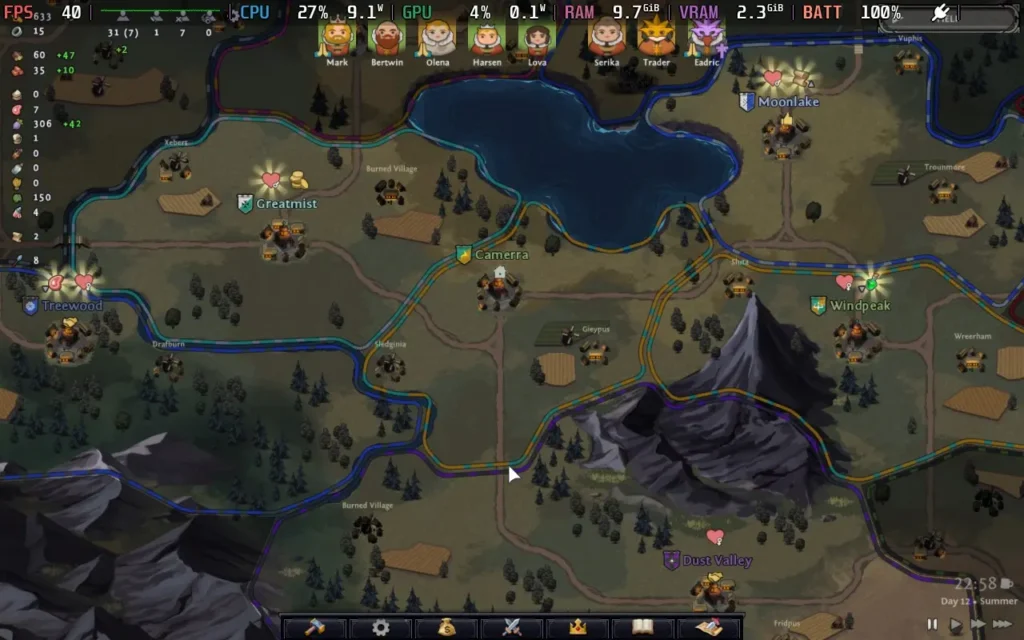
Norland doesn't hold back when it comes to its game world. While it has a somewhat cutesy presentation, the world in which the game takes place is brutal. Mothers and babies can die in childbirth, and criminals can be executed, enslaved, or just blinded to give them a lifelong debuff. Lords can pay to have sex with the peasants. And let's not forget the religious cult that's gradually destroying kingdom after kingdom, and it's heading in your direction, requiring you to build up an army before it reaches you.
The combat in the game is pretty basic, and like most other things, it's mostly autonomous. You can create an army of either peasants or mercenaries, equip them with weapons of your choice, assign one of your Lords to be the commander of the army, and then move them on the world map to other locations to initiate a battle, at this point, the AI mostly takes over, you can give rough directions as to which group the army should attack, but beyond that, they'll mostly fight themselves.
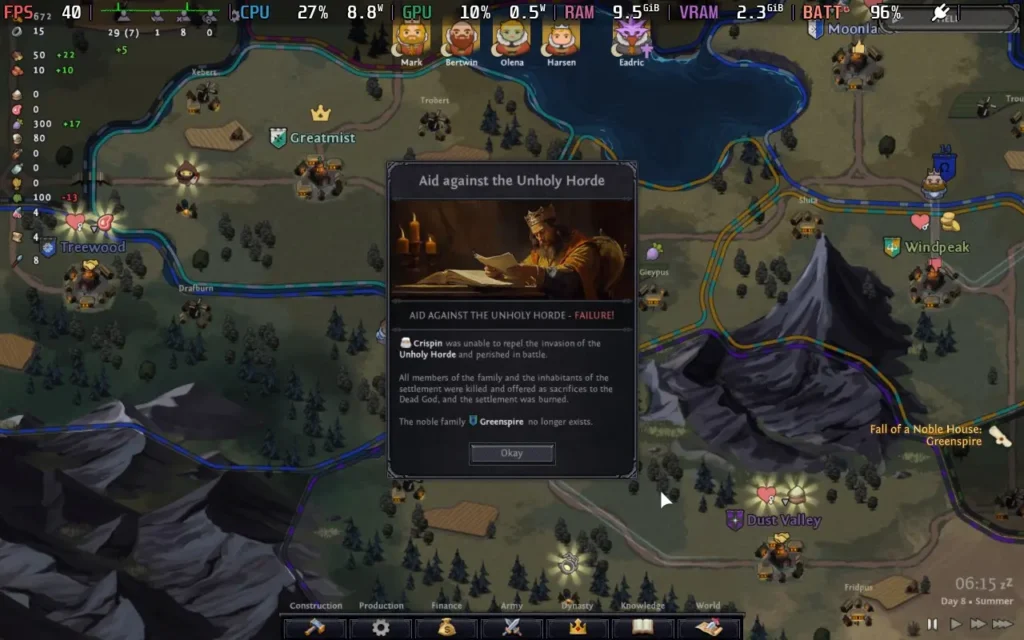
You only control 1 settlement. While you can gain authority over other kingdoms by making them your vassals, you don't take control of them directly; they will merely pay tribute to you regularly. The map of your 1 settlement isn't huge, but it can probably get as big as you would realistically want to manage, and it will take you many hours to reach the size of settlement possible in the game.
As I said at the start, Norland is a pretty unique game. It perhaps doesn't delve as deeply into the personal lives of your citizens as Rimworld does, but it adds the extra layers of a wider economy, political intrigue, and management. You are responsible for balancing all these things, ensuring unnecessary conflict doesn't erupt, managing wages and prices for goods, punishing peasants who break the law, and ensuring you have an heir to carry on your lineage when your Lords inevitably die. Fortunately, the AI systems in place seem to handle it all pretty well, and Norland is a pretty smooth simulation of a small medieval kingdom.
Norland supports 1280x800 as a resolution, so we do get full use of the Steam Deck's display, but as far as graphical options go, they're pretty much non-existent in Norland. Aside from the ability to toggle FXAA and VSync on and off, there are no other options you can change. The game has no gamepad support, so it does need to use a mouse/keyboard layout, but it works perfectly fine for this kind of game.
Because of that, I'm only offering 1 preset for Norland.
In your SteamOS settings, set an FPS Limit of 40 FPS / 40Hz and remove any TDP limit.
As we don't have many graphical settings to change, just set your FXAA to On and your VSync to Off.
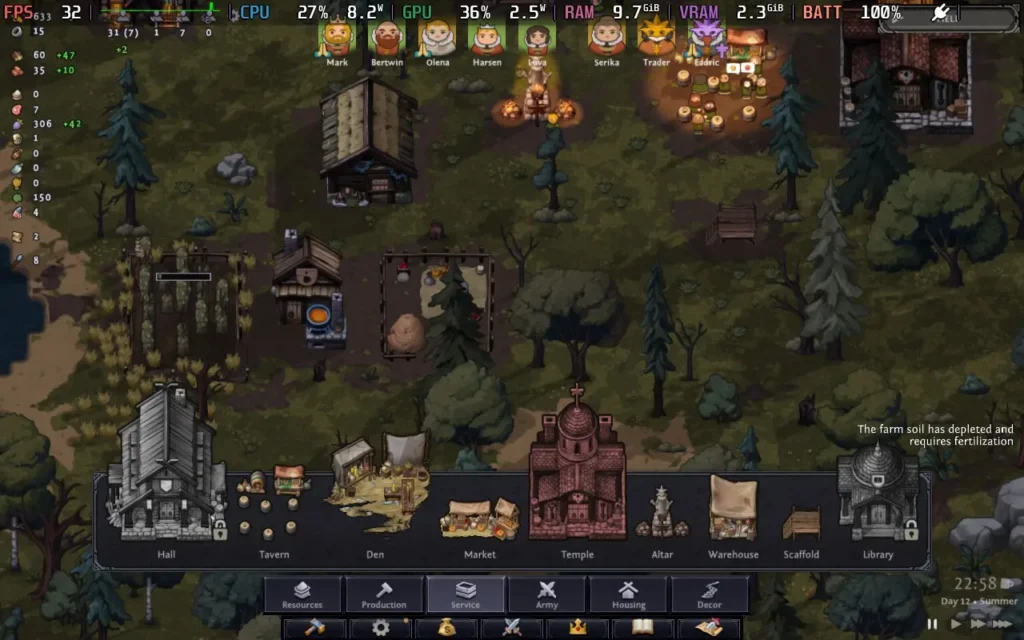
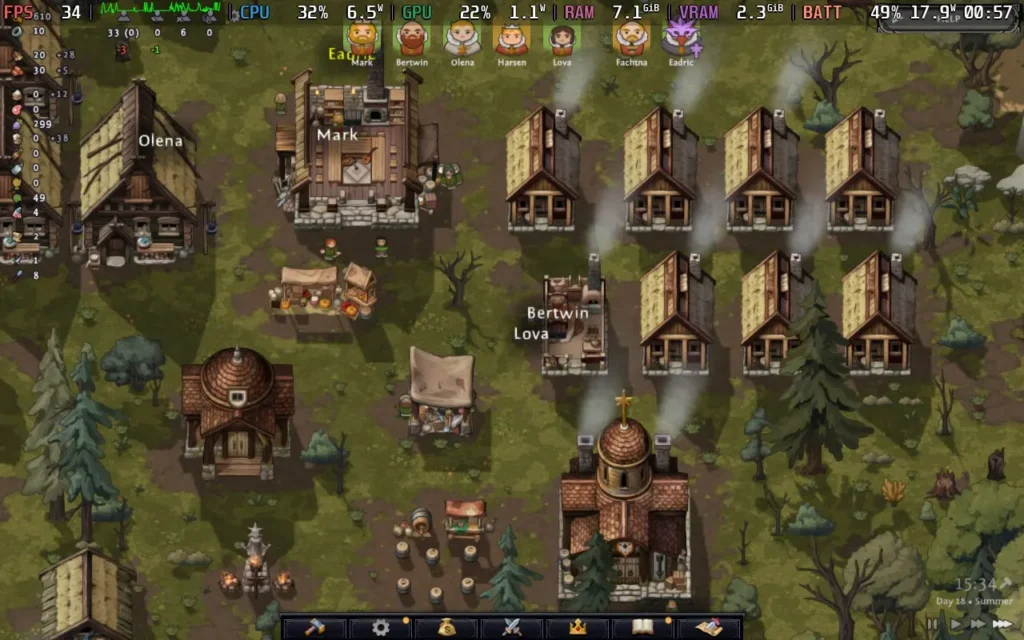
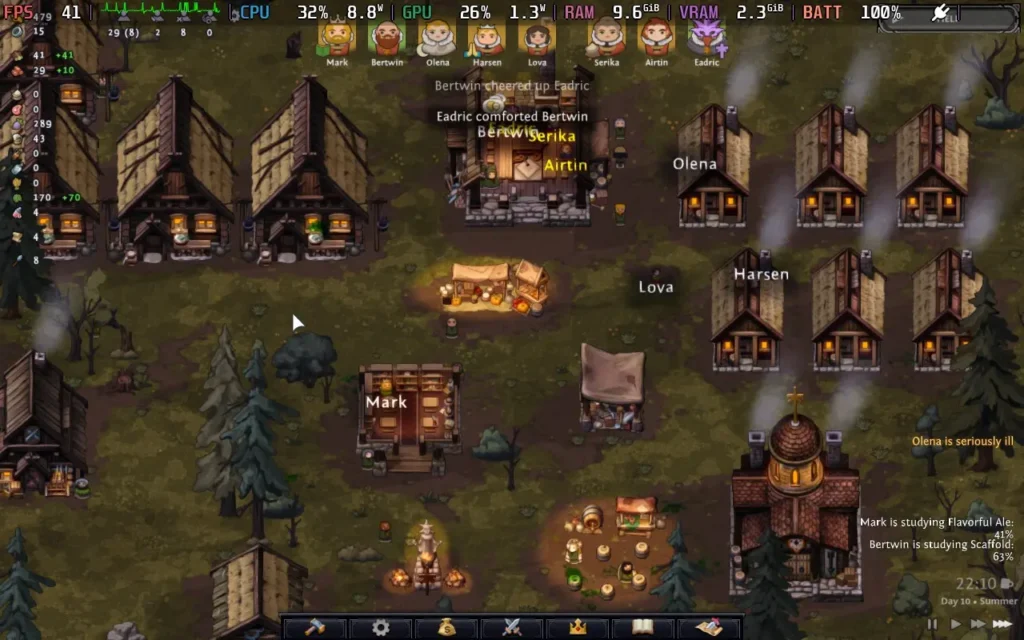
With the settings we've selected, you should mostly get 40 FPS, but Norland suffers from almost constant stutter, especially if you are fast-forwarding. It's a CPU-intensive game, and we can do nothing about that. But given the fairly slow-paced nature of the game, I found the stutters didn't cause major issues, and you can always pause to issue commands or assess a situation.
I also couldn't test up to the maximum colony size, as you can supposedly have more than 250 citizens and armies go against each other with over 200 units in total. My settlement peaked at around 50 citizens after about 10 hours of gameplay, which gave me the results above. However, if you do manage to reach that 250 number, you might need to lower the FPS limit to 30, as the number of citizens impacts performance. When I had 5 citizens, for example, the game can run at 60 FPS, but it can no longer do that with 50 citizens.
The power draw hovered around 16-18W, and it never really changed regardless of what you're doing, even when paused. So expect around 2 hours of battery life on a Steam Deck LCD and 2.5 hours on the Steam Deck OLED.
The GPU's temperature rarely exceeds 70C, but the CPU's will hover around 75-80C. There will be noticeable fan noise on the LCD Steam Deck.
Norland has no accessibility options. There is a UI Scale; however, it is locked to 80% on the Steam Deck. While some text is a little hard to see, it's still legible.
Norland manages to do exactly what it set out to do: create an intriguing and functional medieval kingdom manager. The AI systems in place do a good job of keeping everything flowing smoothly. The game is deep but not overwhelming to new players. Expanding your settlement and unlocking new buildings as you progress is satisfying and helps you feel like you're going places. The addition of managing diplomacy and the personal relationships of your Lords with each other and the Lords of neighboring kingdoms make Norland a game with plenty going on. I can vouch that minutes will easily become hours when you play this game.
As far as Norland's performance on Steam Deck goes, it's not perfect, but it's definitely in the realm of playability. The stutters are annoying, but in a slow-paced management game that can pause whenever, they will hardly cause issues when playing. The controls also work fine because of the ability to pause, even though there is no native gamepad support. I couldn't test the game to its absolute limit, as it would take tens of hours to reach that point, but from what I was able to test, the Steam Deck should be fine.
Our review is based on the PC version of this game.
If you enjoyed this review, be sure to check out the rest of the content on SteamDeckHQ! We have a wide variety of game reviews and news that are sure to help your gaming experience. Whether you're looking for news, tips and tutorials, game settings and reviews, or just want to stay up-to-date on the latest trends, we've got your back.
Bulwark: Falconeer Chronicles was provided by Wired Productions for review. Thank you!
This review used an LCD Steam Deck. OLED details will be coming later.
Bulwark: Falconeer Chronicles is a strange one. It gives me all the vibes of a game that should have an "Early Access" label on the Steam store page, but it doesn't. When you boot the game, you're told it is a "development build," there seems to be quite a lack of variety in things to do, yet it's released as a full-release game.
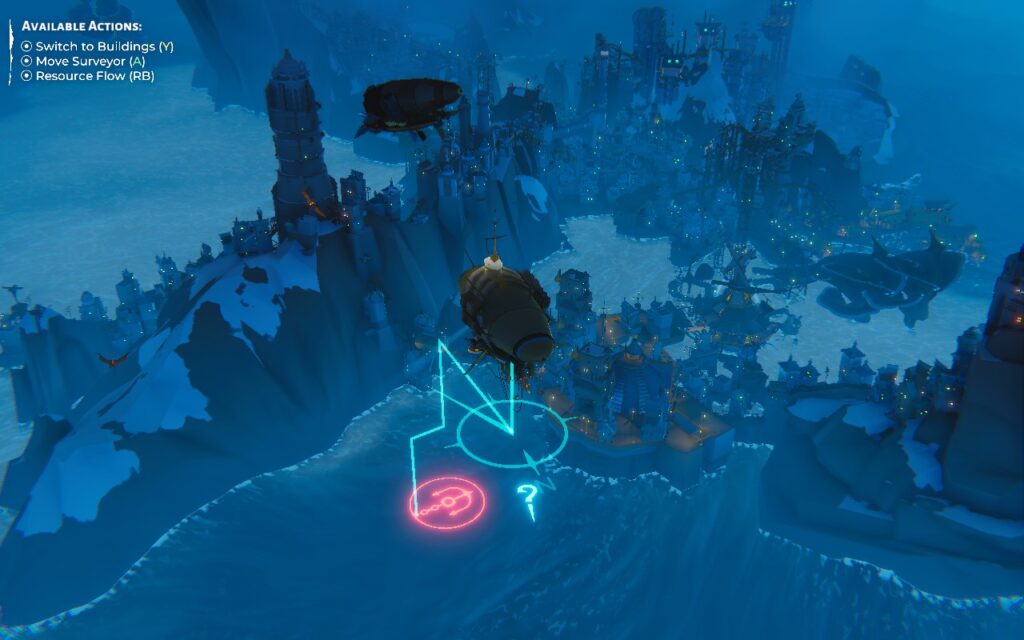
In short, the game is a sandbox where you command an airship and can construct outposts and settlements on a water-filled planet to gain resources and, well... construct more outposts and settlements.
This is my issue with Bulwark: Falconeer Chronicles. It's billed as a "Creative Sandbox," where the game has no actual objectives other than expanding but building and expanding your base wasn't very satisfying. There's a limited selection of buildings, and the game decides where to place them to some degree. Most of the world is water and can't be built on, and the whole thing feels rather empty and directionless.
You start the game by placing an outpost. You then place walkways from this outpost, leading to "towers" or checkpoints. There are a few resource points around your outpost where you can build extractors, and you have to hook the outpost up to these extractors via walkways to generate resources.
Sadly, I think the issue is that you're just placing "roads" in a space. A lot of the satisfaction of building roads and logistics is working around or with the landscape and designing efficient systems and pathways. There's none of that here. You will always be building straight walkways; there's never a reason not to build as the crow flies other than aesthetics.
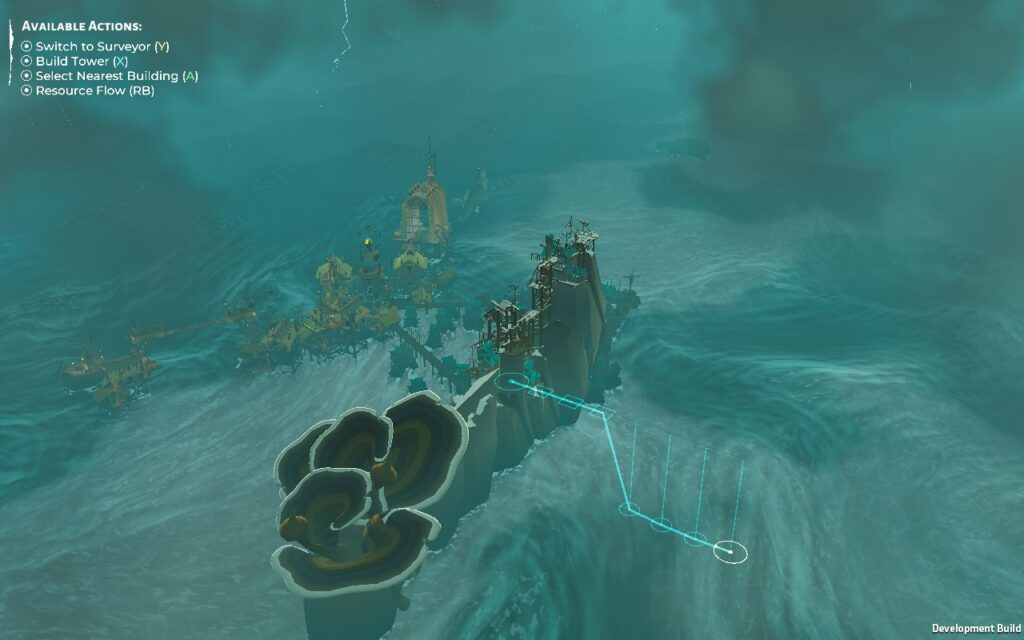
Even when starting a game, there is a severe lack of content. On a new game, you are given the choice of 3 "Scenarios," which function as save slots. You can select your starting faction, position, and a few things to make the game harder or easier, such as disabling hostiles or starting with more resources.
There's a "free build" mode on the main menu, which is even more sandbox-y than the game's normal mode, with no limitations applied to what you can do. But you can't save in this mode, so anything you build is lost once you leave the game and re-enter. For a game about "designing" and building your fortress, it seems crazy that the mode focused on doing exactly what you want is intentionally ham-stringed by the inability to save.
There's also only 1 pre-made map in the game with no random generation. It's 90% water, with the odd island here and there and about 7 NPC settlements that essentially will do nothing unless you interact with them to trade or declare war.
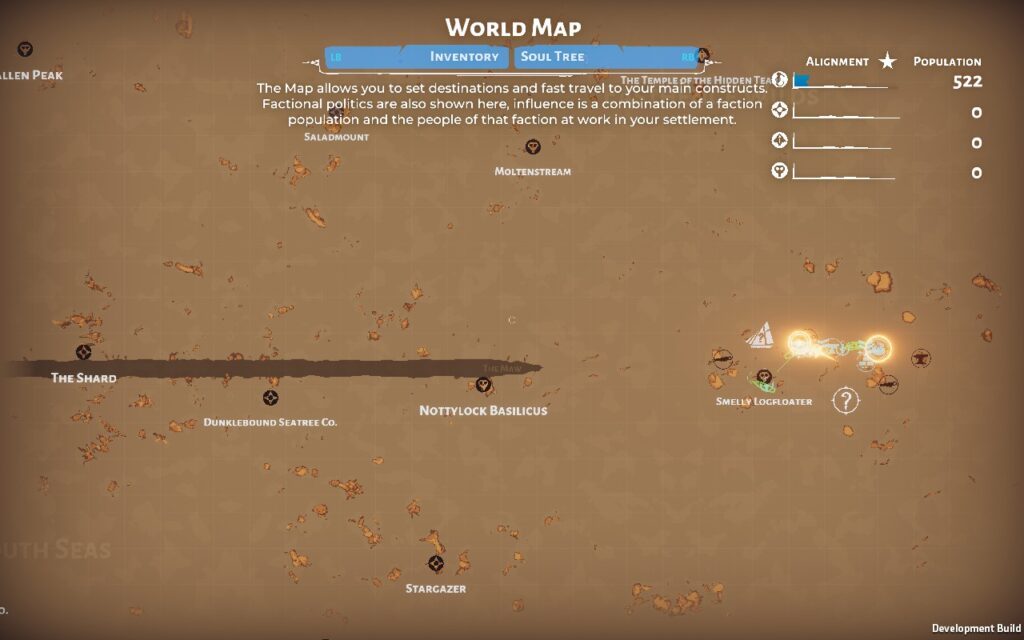
Random events happen but are triggered by the player as and when they want them. These can range from a new ship to conduct trade or war, a new faction joining your settlement, or hostiles that attack. The game purposefully does not force any way of playing upon you, meaning you can decide when and if you ever want to engage in combat or trade.
Combat is also pretty basic: once, or if, you declare war on a settlement, your units will automatically fire at any enemy units within range, likewise for the enemy. A bar goes across the top of the screen when you're in combat, which details the health of your fleet versus the enemy fleet.
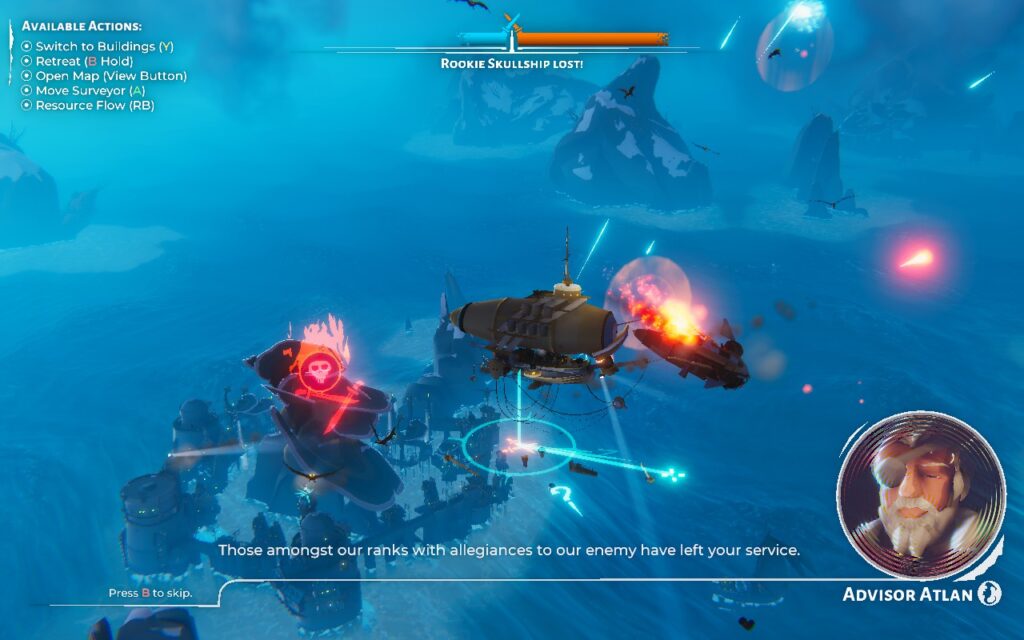
Bulwark: Falconeer Chronicles is a decent-looking game. The clouds and fog look nice, especially when you're at the sunrise/sunset time of day. Although it's a bit dreary and rainy often, this is an apocalyptic world. The water also looks pretty decent. The islands themselves and the buildings aren't quite as pretty as the rest of the game, mostly made up of fairly low-poly assets.
Progression is achieved by gaining population in various factions, with higher populations unlocking new tiers, allowing you to recruit more captains and expand further. Still, it's all the same, and the progression doesn't unlock any new gameplay mechanics.
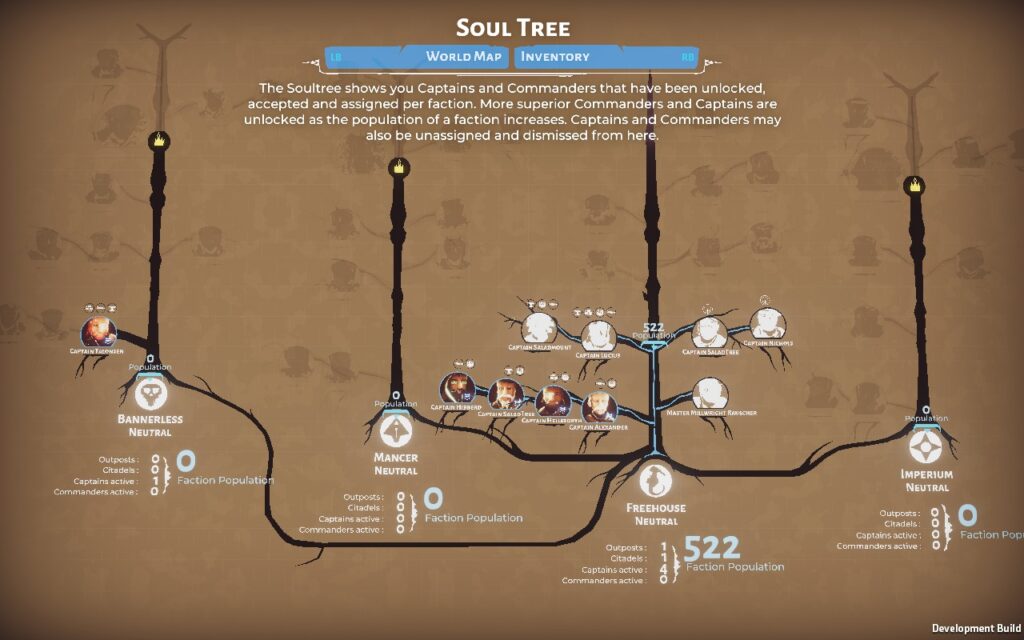
Bulwark: Falconeer Chronicles is a purposefully aimless game. There's no reason to do pretty much anything in it. You design a base for the sake of designing a base, not to protect yourself, not to earn more resources, not to climb a leaderboard, just because it can look impressive at the end of the day. You can build a base in 5 minutes that will, from a gameplay perspective at least, perform just as well as one you've spent hours on.
That isn't really why I play games, especially single-player ones where I can't share my creations with friends, but if you are into that, this might be the game for you. It's certainly a unique approach.
Let's start by saying that Bulwark: Falconeer Chronicles does a pretty good job of working well on the Steam Deck. It has 1280x800 resolution support, so there are no black bars around the edges of the screen, and the controller support is good, too, with different control schemes depending on your preference. You can't fault how Bulwark: Falconeer Chronicles handles itself on the Steam Deck.
I'm offering two presets today: one for visual quality and framerate and the other for saving battery life.
In your SteamOS settings, set an FPS Limit of 60 FPS / 60Hz. We won't be setting a TDP Limit here.
Bulwark: Falconeer Chronicles has fairly simplified graphics settings, so for this preset, you'll simply want to set Visual Quality at around 90%, disable Anti-Aliasing, set Post-Processing to Max, set Shadows to High Quality, and keep your resolution at 1280x800.
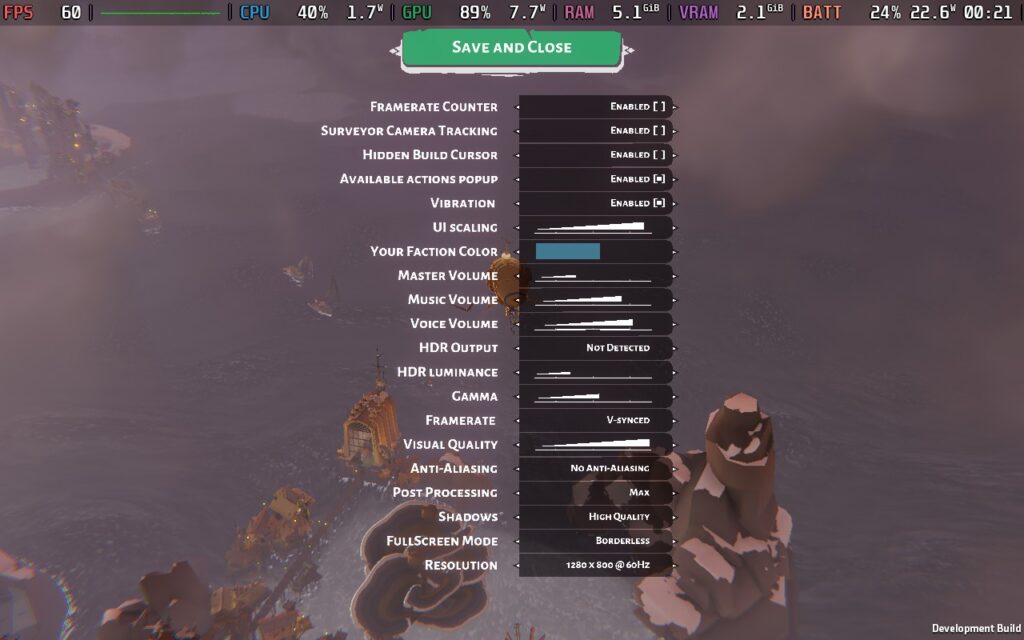
The game always held 60 FPS for me on these settings, with occasional dips to 58 or 59, depending on the weather. Expanding my settlement seemed to have little effect on performance, so you're probably safe to keep these settings. I didn't expand to a "mega-fortress" such as the ones shown in the game's trailers, but expanding my own and visiting large NPC settlements didn't drop the framerate from 60, so you should be safe unless you go crazy with your fortress.
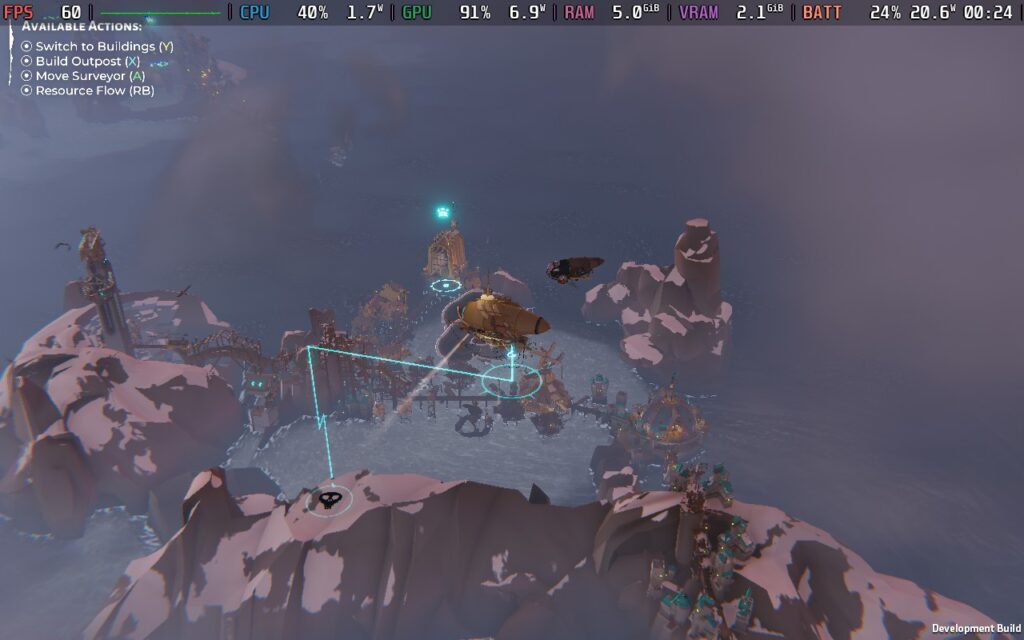
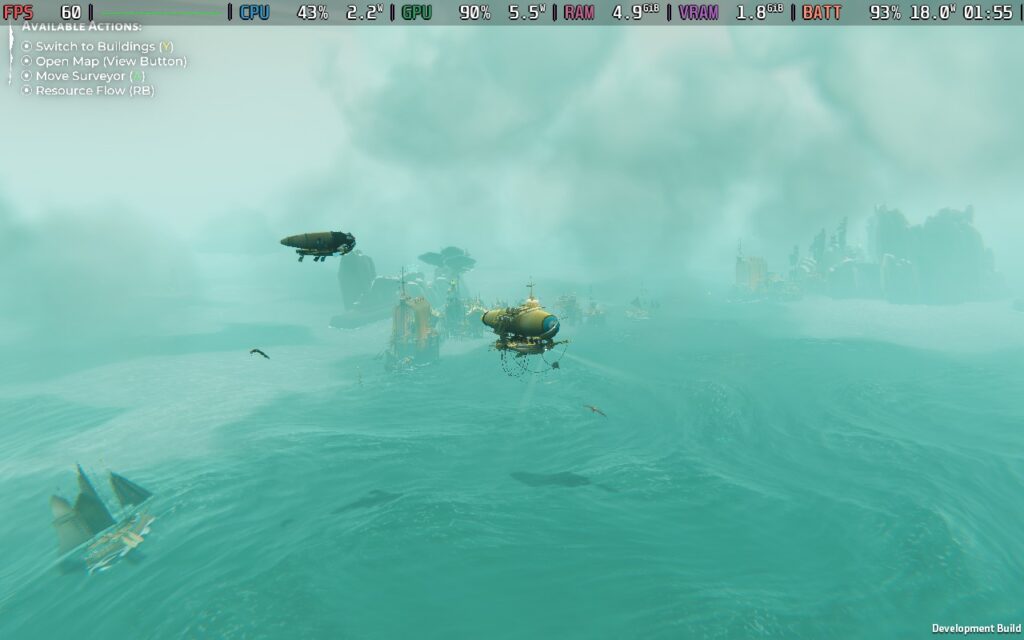
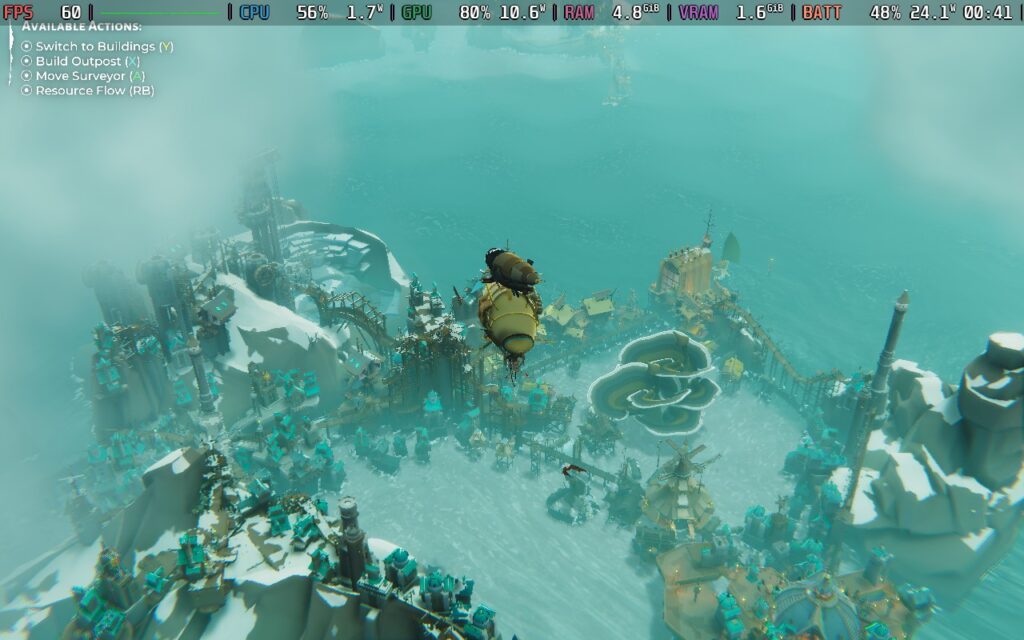
This preset draws a lot of power, though. You should expect anywhere between 18W and 24W from the battery, meaning Steam Deck LCD owners can expect around 1.5 hours of battery life from this preset, and Steam Deck OLED users just above 2 hours.
Temperatures are high, around 80-85C, so expect some fan noise, and your Steam Deck will be hot to the touch.
I once noticed that the frame rate dropped considerably on the Quality preset when the sun was rising or setting, causing an orange glow to light up the clouds or fog. This seemed to cause considerable stress on the Steam Deck's GPU, making the frame rate drop into the 40s. Lowering Post-Processing to the "Low" setting fixes these drops, but they don't occur often.
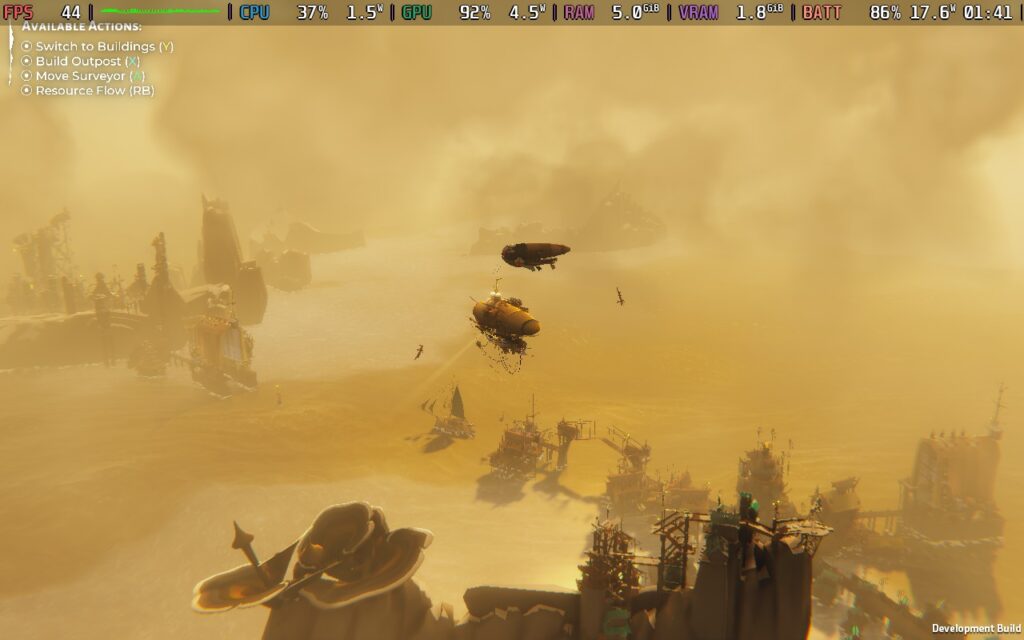
If you want more battery life and less heat, this preset might be your favorite.
We're locking the framerate to 40 FPS in the SteamOS settings and then applying a TDP Limit of just 6W.
For the graphics, lower the visual quality to its lowest, disable anti-aliasing, put post-processing to minimal, and no shadows. We keep our resolution at 1280x800.
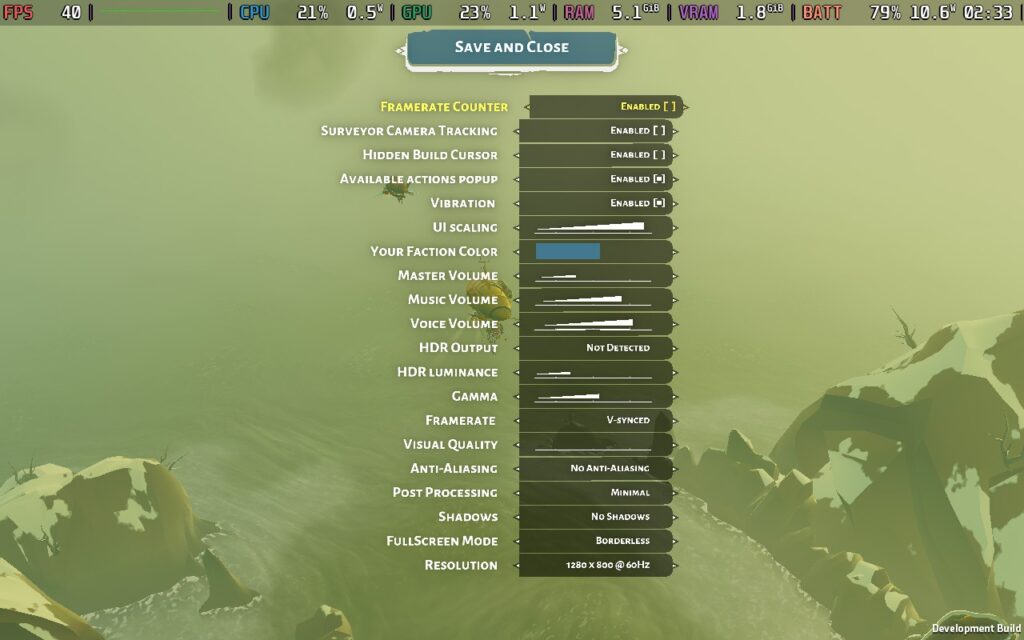
With these settings, we can hold 40 FPS. Even with the lower visual settings, the game still looks decent on a handheld. The low-poly nature of the game helps it hold up without as much shading. However, we sacrifice some nice post-processing effects on things like fog, clouds, and lighting.
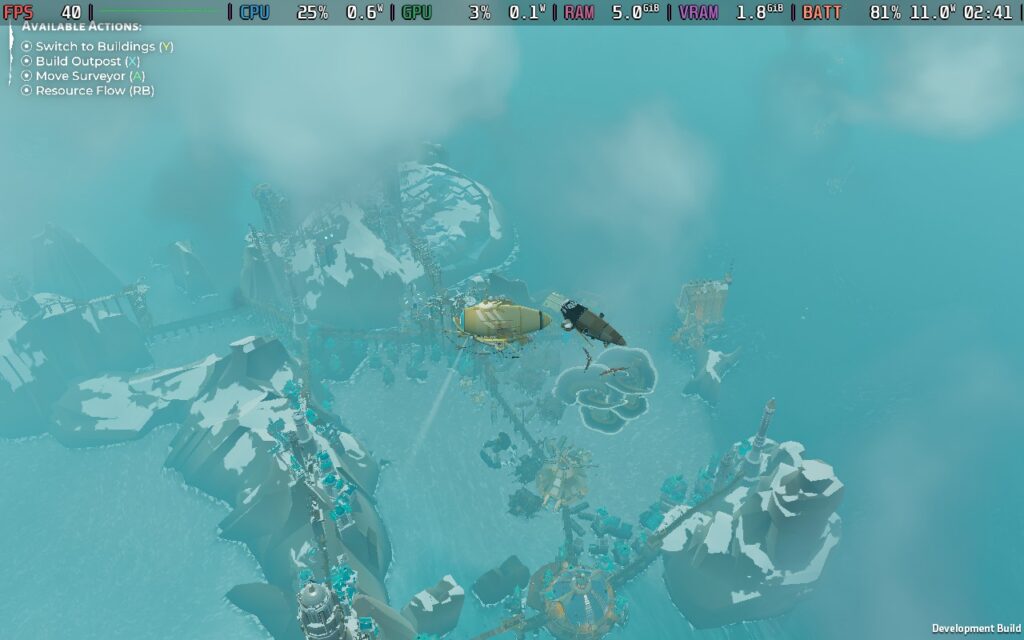

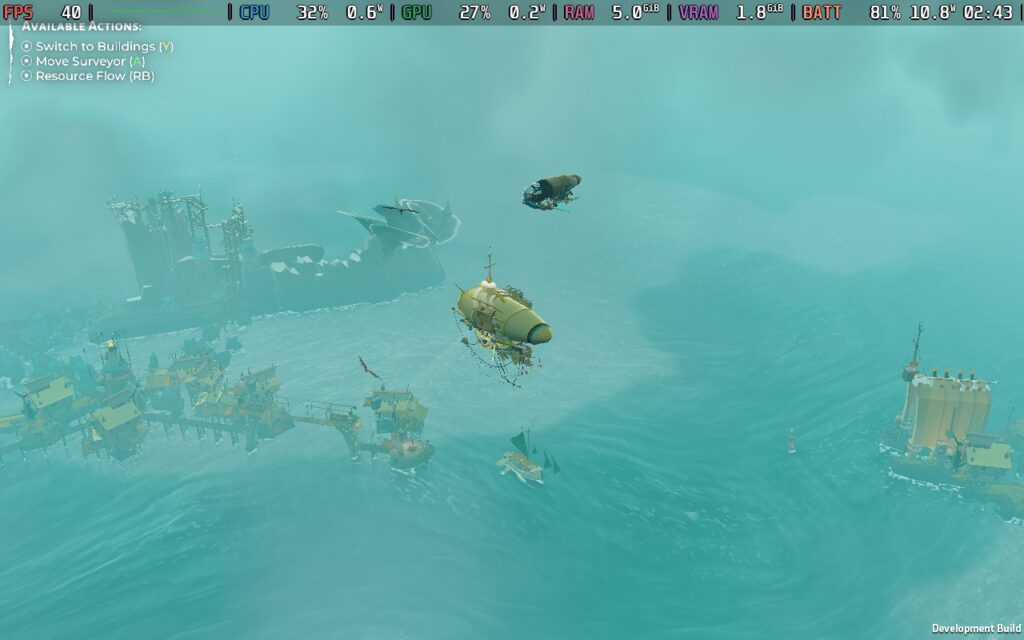
By making these sacrifices, we see the power draw at just 10-11W, meaning we can easily get 3-3.5 hours from a Steam Deck LCD battery and a good 4-4.5 hours from the OLED model.
Temperatures were also much cooler, hovering around 65C during testing. This meant there was minimal fan noise, and the Steam Deck stayed comfortable to hold.
The framerate drop experienced on the Quality preset doesn't apply here, as our Post-Processing is low enough already.
Bulwark: Falconeer Chronicles isn't very accessible, but all voice lines are subtitled, and the UI can be scaled, although I found that it is scaled quite well by default. There are also adjustable controls and camera sensitivity options.
I'll be honest: Bulwark: Falconeer Chronicles wasn't my type of game. The whole purpose of the game is to design an aesthetically pleasing fortress. Still, the gameplay is very shallow, and there's not much to do but continuously place walkways for your citizens to build along. The closest thing I can compare it to would be Cities Skylines or SimCity, but if all the zoning and placement of buildings was done for you, and you just had to build the roads.
It's a unique game; I'll give it that. And if you are looking for something like this game, it's probably your only choice, as I'm unaware of any other game that focuses purely on designing a town/fortress and nothing else. The closest game I can think of might be Townscaper, which, funnily enough, was in the "Games like this" recommendations at the bottom of the game's Steam page.
Having said all that, the Bulwark: Falconeer Chronicles does run well on the Steam Deck, both in terms of performance and controls. There's enough flexibility in settings to get the game just how you want it, whether with visual quality or a long battery life. I went with the visual quality preset because the game is about aesthetics.
Our review is based on the PC version of this game.
If you enjoyed this review, be sure to check out the rest of the content on SteamDeckHQ! We have a wide variety of game reviews and news that are sure to help your gaming experience. Whether you're looking for news, tips and tutorials, game settings and reviews, or just want to stay up-to-date on the latest trends, we've got your back.
Men of War 2 was provided by Fulqrum Publishing for review. Thank You!
I was pretty excited to get my hands on Men of War II. I had played the original games a long time ago and remember that I enjoyed my time with them before games like Company of Heroes (CoH) tended to take over the WW2 strategy era. But now that Men of War is back after a long absence, how does it stack up against the competition?
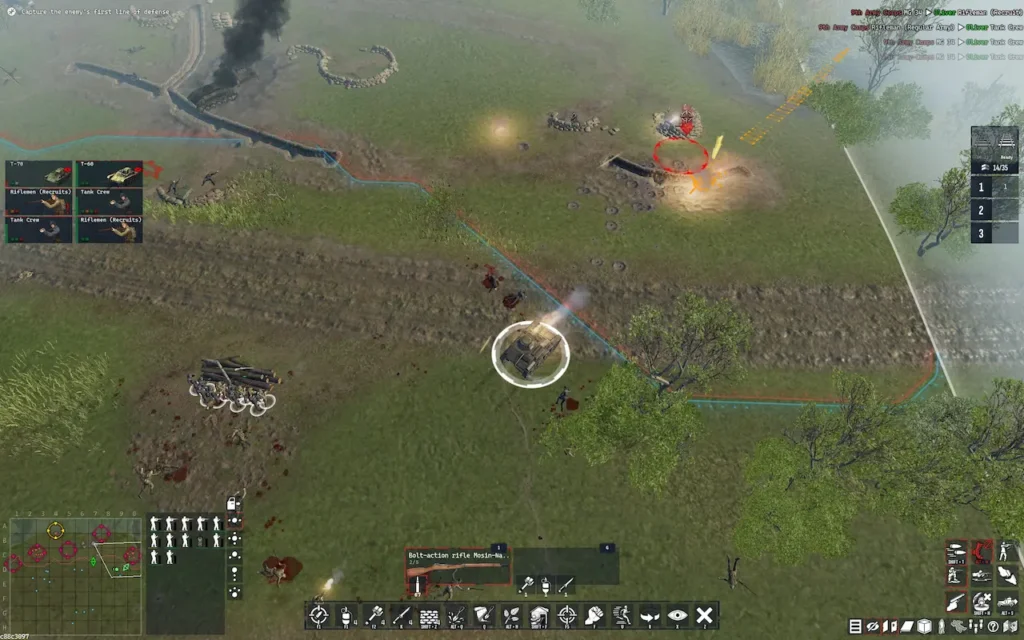
Well, Men of War II plays a little differently. Whereas CoH plays somewhat similarly to Age of Empires, where you build a base and produce units, Men of War II adopts an approach far more centered on individual units and managing them well to preserve and make the best use. Rather than producing units in a barracks or tank factory, units come from off the map, with reinforcements gradually being unlocked as you play the map.
This means you're stuck with what you're currently stuck with, so you must protect your units. You can't just go and produce more because you wasted them all in a fruitless attack. If you run in and try to rush the enemy with your infantry, expect to lose the entire squad and potentially cause you to lose the battle.
Many game modes also require you to select a "Battalion" at the start of the game, which generally falls under Infantry, Armor, or Support, forcing you to adapt on the fly. Infantry relies heavily on the cover and is good for holding a position. Armor meanwhile, is capable of more brute force, and can drive into combat and route the enemy if you aim your shots well. While this idea is neat, playing on a team where everyone has selected a similar battalion can be tough. It could mean you are kept from having tanks until late in the game.
Men of War II largely based their success on ground control. Borders dictate how well your army is pushing against the enemies, giving you a visual representation of how well the battle is going. Holding key points on the map will also grant you points in certain game modes. Units in defensive positions or cover get a huge advantage over units in plain sight, so you'll need to think tactically and decide where to position units to defend a specific point.
Your borders also dictate where your "Frontline AI" will position themselves. Each team has a frontline AI that no humans can control and is sort of a defensive line that will attempt to hold your border while you're off managing an offensive move. Pushing the enemy back will result in their frontline AI retreating and yours advancing.
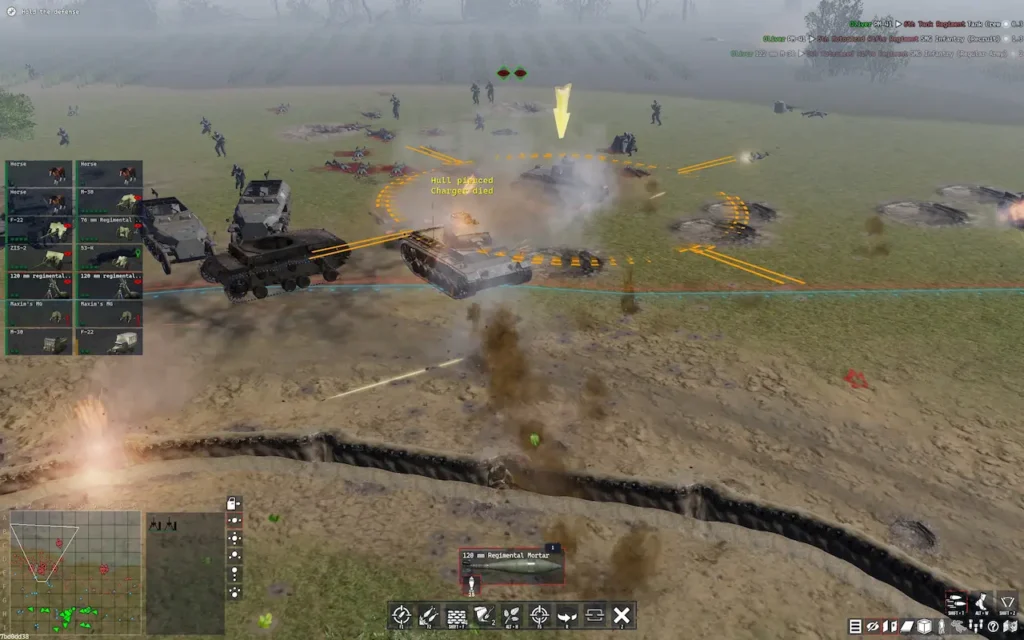
The gameplay itself is solid. The cover system is great and forces you to think tactically. The enemy AI is quite competent. I'm not the best player in strategy games, but the AI on "Normal" difficulty puts up a fair fight, causing me around an 80% win percentage. There are 2 difficulties above Normal, which I likely would have lost.
There's also some controversy over the amount of single-player content available, but in my opinion, Men of War II offers quite a lot. There are 18 story missions spread across 3 campaigns. The missions vary in length, but in my experience, depending on your skill, each should take around 30 minutes or so. Then there are 20 Historical Missions, which tend to be larger conflicts and will take a fair chunk of time each. Finally, there are Conquest and Raid matches, which feature random generation.
Conquest battles occur on a map, where you have to progress, capture land, research technology, and get the latest equipment for your soldiers. Raids are probably the closest thing to "Quick Battles," which throw you into a match when you pick the type of units you want to control.
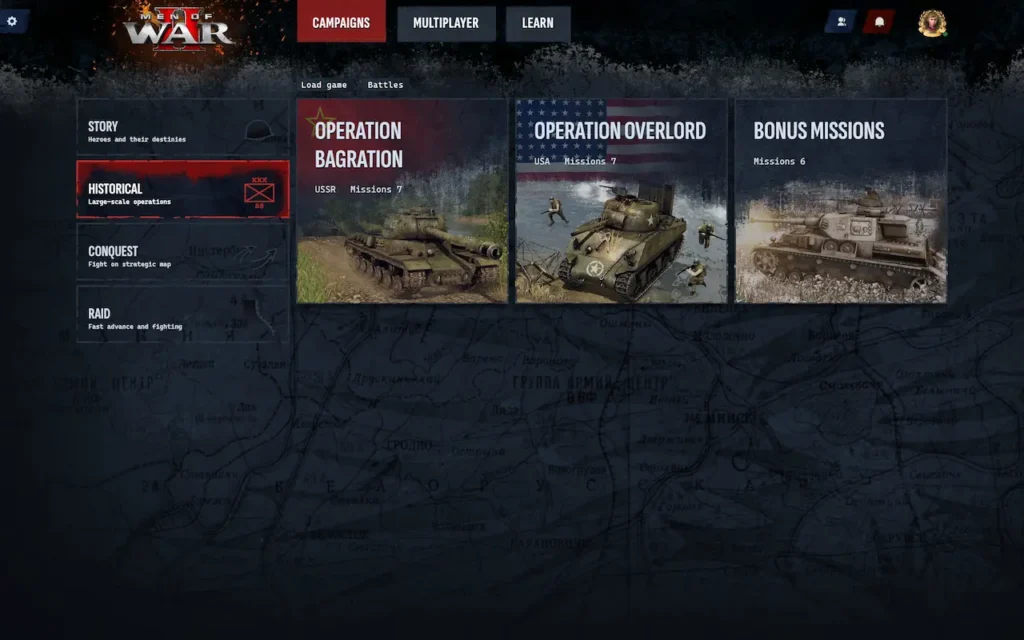
But you may have heard by now that Men of War II requires a constant internet connection, at least for now. Weirdly, despite the plethora of single-player modes that would work just fine offline, the game still needs to be connected to be playable. Due to the community backlash, the developers have stated that they will offer an offline mode.
As for multiplayer, we have Battalions, a PvP or PvE game mode, where, much like the Single-player Raids, you are put in charge of a battalion of troops and have to lead them to victory, either with other humans against a team of AI or against other humans with AI fighting on both sides. These tend to take place on larger maps, and if you want a more casual time, it can be fun to do some PvE with human allies.
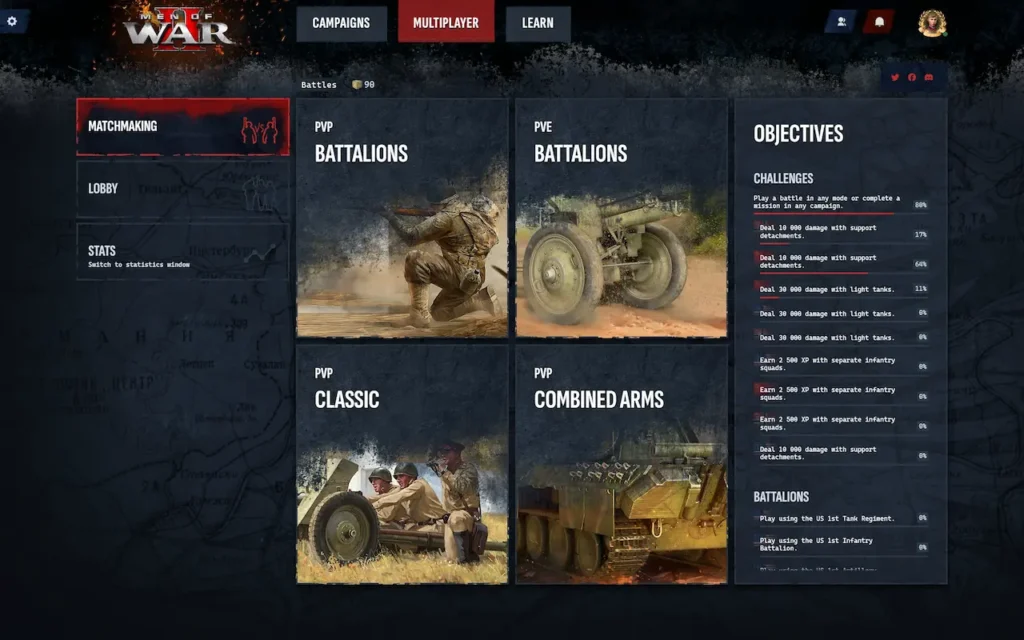
You also have "Classic." In this mode, you don't control a battalion; you simply control the entire army. You have a certain amount of points to spend, which you accrue as the game goes on, and you can spawn units from off the map by spending those points. This is probably my favorite mode to play and is more in tune with other games in the RTS genre, where you can decide the composition of your army.
There is a reasonably healthy player base right now, so you should be able to find matches without too much trouble. In my experience, there were around 8 games available to join at any point during peak time. I also played a match in off-peak hours, and the quick match option found me a match in about 30 seconds, so it's not terrible.
You can also access a "Mission" mode if you host your lobby. This mode lets up to 5 human players play the game's single-player missions in a cooperative mode, which is a nice touch and, if I remember correctly, one of the things that set the original Men of War games apart from other RTS games of the time.
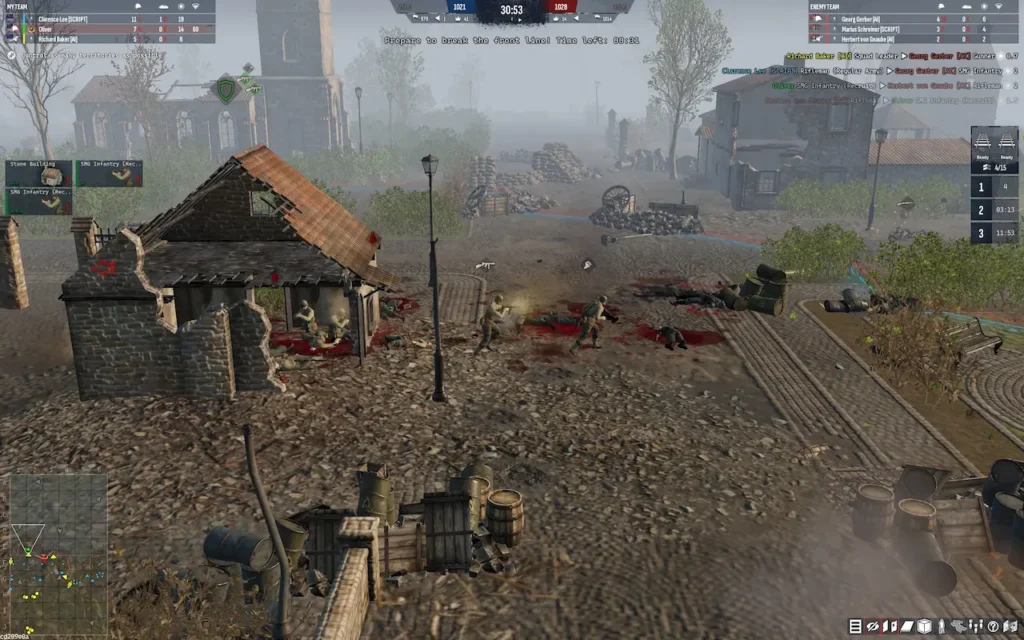
Visually, the game is fine. It's not ground-breaking, but it does the job. Regarding audio, some sounds got a little irritating in the game, like when bullets strike metal objects. The stories also have voice-acting, and I found most voice-acting to be pretty poor and distracting. I most noticed it in the Soviet missions, when 3 characters spoke back and forth, and all of them were quite difficult to listen to. The general battlefield ambiance is okay, though, and there's nothing egregious outside of the voice acting.
Sadly, the always-online nature of the game creeps into single-player. As mentioned before, the game needs a constant internet connection to play. Still, it must also connect to a server to play even single-player. If your internet connection or the game's servers are struggling, you may experience lag in single-player matches or get kicked from the game entirely if their servers or your internet goes down. This also means you cannot pause the game in certain single-player modes. It's quite bizarre.
Men of War II starts ok; it supports 16:10 resolutions, and although quite a bit of the text in the game is small, it is just about readable. The controls do the job once you get used to them. Some hotkeys are unavailable simply because you need a keyboard to manage everything properly. Still, the basics are here, such as moving troops, rotating them, and the essential camera movement.
Unfortunately, despite the developers' stating that they had tested the game on the Steam Deck and that it has a native Linux build, it just doesn't run well on the Steam Deck.
In your SteamOS settings, set an FPS Limit of 30 FPS / 60Hz, and you'll want no TDP limit here.
I played with everything on minimum, and I mean everything. CPU usage is set to low, and everything else is as low as possible. You can probably get away with Textures being in a higher setting. We just want to keep the GPU power draw low.


Men of War II eats the Steam Deck's CPU for breakfast. In-game, it pretty much always maxes out the CPU at 85-100%, and you'll constantly be drawing 10W+ from it; this means there's no room for the GPU to get any power, and therefore, it's best to run with low graphics so that the CPU can cope. Unfortunately, expect frequent stutters and poor frame times. The game often won't run at 30 FPS, and I experience lengthy stutters of close to a second.
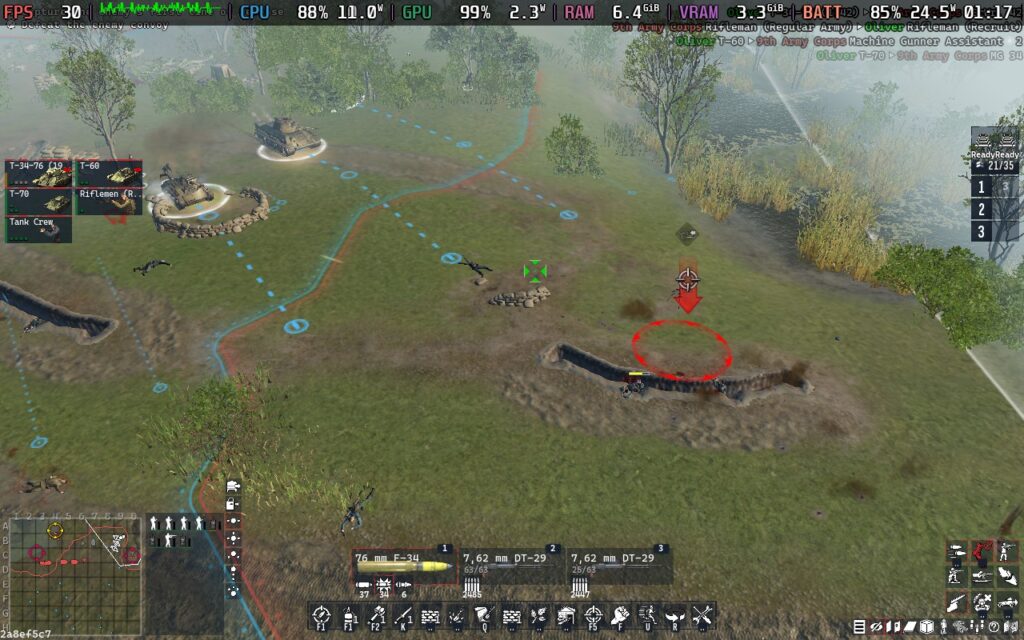

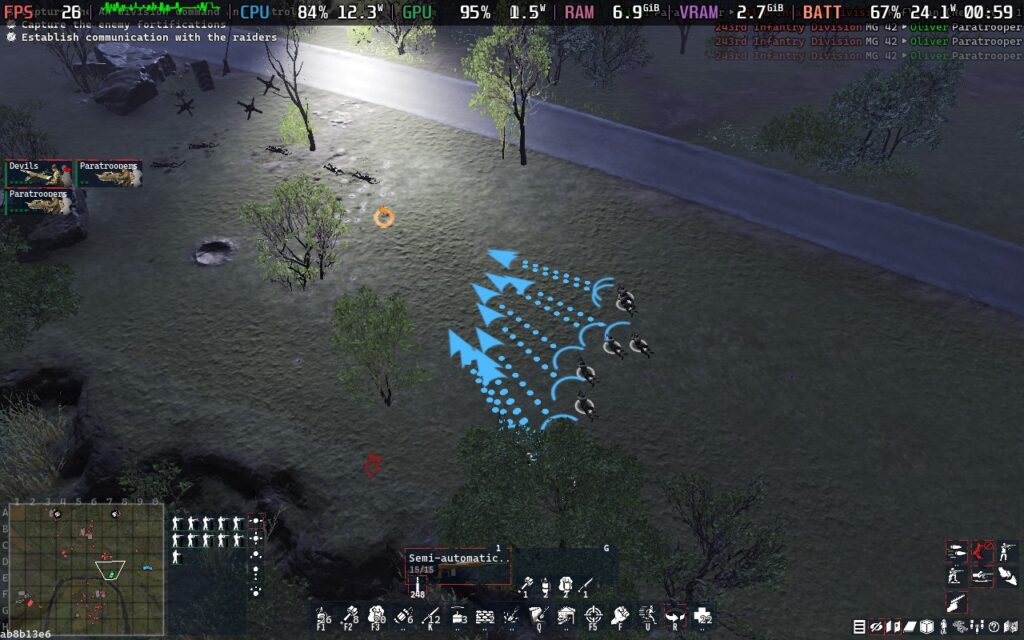
The Steam Deck LCD's power draw tends to be around 20-25W, so the battery life will probably be 1.5 Hours, and Steam Deck OLED users could expect around 2 hours.
GPU temperatures aren't too bad at around 75C, but the CPU always stays above 80C, holding around 84-85C most of the time for me.
Unfortunately, the biggest issue with Men of War II is that it seems to crash fairly consistently on the Steam Deck. I played single-player first, and when playing the USA Western Front raid missions, the game crashed 3 times in 10 minutes on the first mission. Then, I played in Soviet historical missions. It crashed 15 minutes into the first mission. I then tried multiplayer, but the game crashed twice before I could move any units in the match.
Because of all these crashes, the content of this review was written based on my experience playing on an actual PC. The game is pretty much unplayable on the Steam Deck, and I have no idea why. The RAM or VRAM usage never gets abnormally high. The game seems to run fine on Linux desktops, so it doesn't seem to be an issue with the Linux build.
These crashes were also confirmed to happen on the Steam Deck OLED model.
Despite having many options, Men of War II offers little accessibility. It has subtitles you can enable/disable, as well as changing things such as camera sensitivity and a couple of alternate control methods, but that's it.
There are no assists for colorblindness, which is a shame in a strategy game, as they often rely on colors to differentiate between friend and foe. No UI scaling is offered, which is a double shame as the UI is quite small on the Steam Deck.
Men of War II probably doesn't deserve all the hate it gets, it dropped below 50% positive reviews on Steam at launch and has now crept back up to 60%, it's close to where I would rate it now. The gameplay has some solid ideas, and the execution isn't bad. Some very odd design choices have been made about the always-online nature of the game, the complete instability of the game on Steam Deck, and the lack of accessibility that put me off the game.
The always-online issue has already been confirmed as being addressed. If fixes were brought in for the stutters, crashes on the Steam Deck, and some UI scaling, Men of War II could be a tidy strategy game to play on the go. Still, I can't recommend this game right now unless you plan on playing it purely on a desktop PC with a stable internet connection.
Our review is based on the PC version of this game.
If you enjoyed this review, be sure to check out the rest of the content on SteamDeckHQ! We have a wide variety of game reviews and news that are sure to help your gaming experience. Whether you're looking for news, tips and tutorials, game settings and reviews, or just want to stay up-to-date on the latest trends, we've got your back.
Final Factory was provided by Never Games Limited for review. Thank you!
This game was tested with a Steam Deck LCD. OLED testing is coming soon.
Final Factory is an interesting game. The closest thing I can relate it to is Factorio, but in space, with a fair few differences. The game aims to build up a factory to automate production processes, and just like Factorio, this can get incredibly complex and require lots of planning and reworking as you progress. There are parts I like about how the game handles certain aspects and parts that could be improved upon, so let's dive into the review of Final Factory!
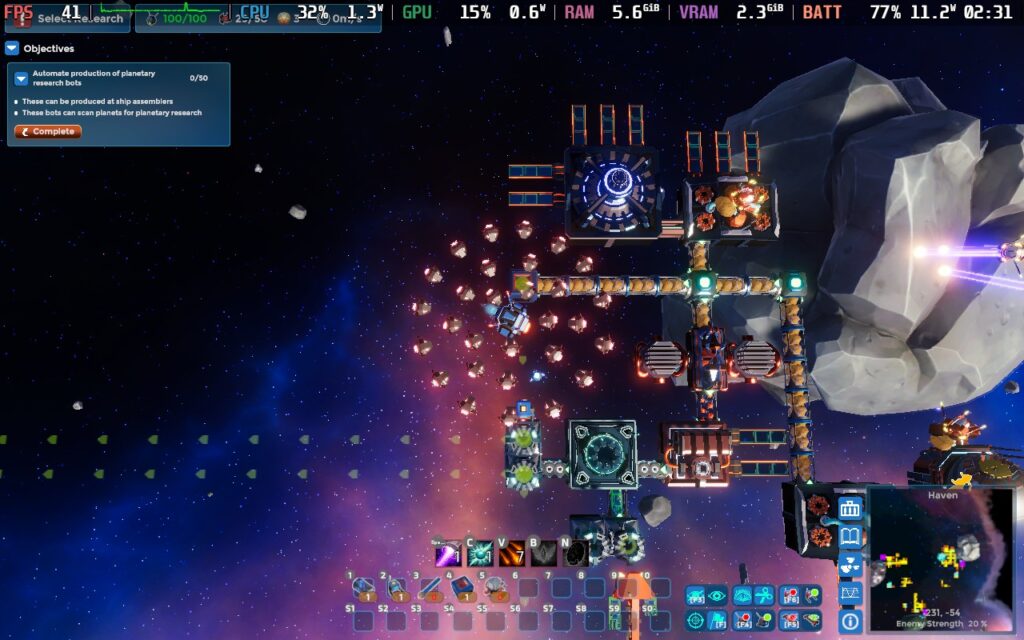
Much like Factorio, you start Final Factory with... well, basically nothing. You're just a lonesome ship floating in space with a couple of fighter drones for some basic protection.
Drones do most things in Final Factory, and you'll utilize them for fighting, logistics, mining, and research. Fighting drones will man defense platforms or can be pulled into your fleet and follow around the main ship, while logistics drones come in a few varieties. Still, they all perform the same duty: moving items from one station to another. Stations you build require stability, power, and heat venting. This makes it more difficult to make one large station to handle your needs, so setting up logistics drones to carry items between stations is necessary.
Mining drones are simple. They mine nearby asteroids for a time and then despawn, requiring you to build more. Research drones also work identically, using an asteroid or planet for some research before despawning. Because they only last a short time, automating the production of mining and research drones is a must.
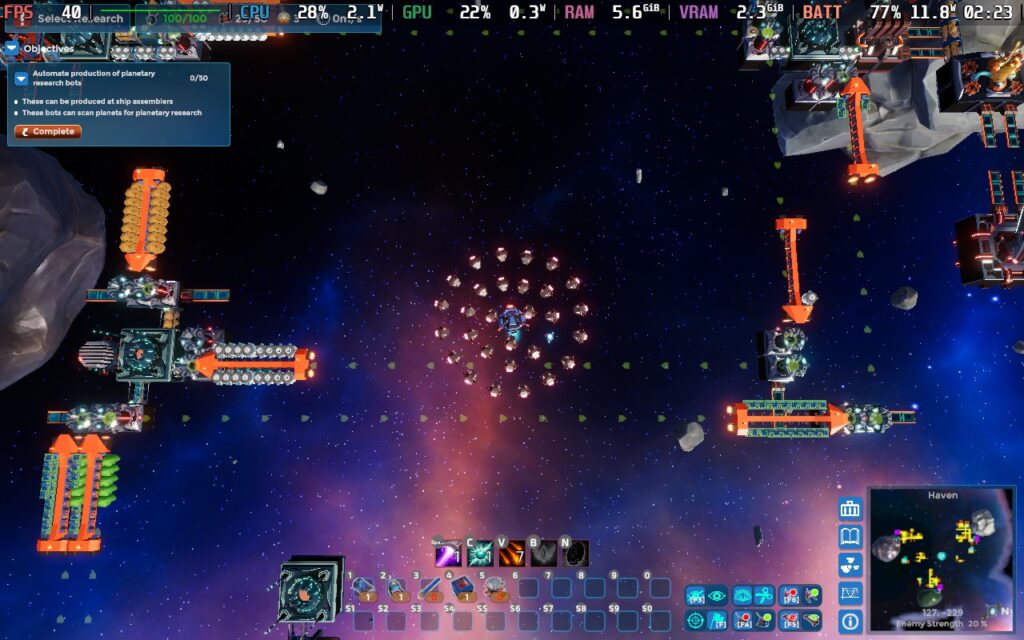
I do quite enjoy the way stations are handled. Like I said before, they have needs, meaning building a station is like a puzzle. You need to plan where every aspect of the station is situated, where the solar panels will be, where the cargo holds, and where the logistics hubs will be for logistics drones to take/deposit resources. Logistics drones are that they only move in a straight line, meaning you have to build your stations in a sort of "grid" of your own, making for it all to flow smoothly.
I'll admit that games like Final Factory can sometimes be a bit overwhelming for me once the tutorial ends after the first hour. The game gives you goals to aim for so you have some direction, but they can be lengthy and vague, such as "automate the production of planetary research bots." This was a several-step process requiring multiple production buildings and a bit of a logistics headache to ensure they all had the resources they needed.
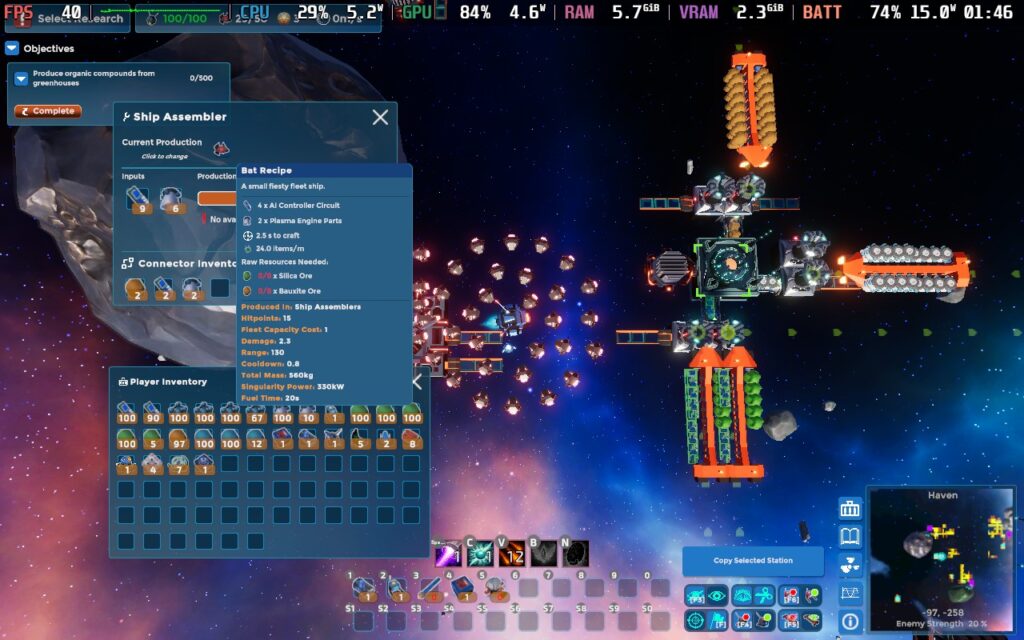
I feel the building and logistics side of things is pretty solid. It does get complicated, to the point where I feel like you need to dedicate some serious time to organizing your stations or at least read up on some third-party tutorials or guides before diving too far in, but whether that's a bad thing or not depends on what you want out of Final Factory, I guess.
If you aren't prepared to spend a decent chunk of time figuring out logic problems in your head about how to get resources between stations with the straight-line logistics drones and limited space you have to work with, Final Factory might not be for you. Eventually, you will have a headache and probably have to demolish parts of your stations and rework them to expand.
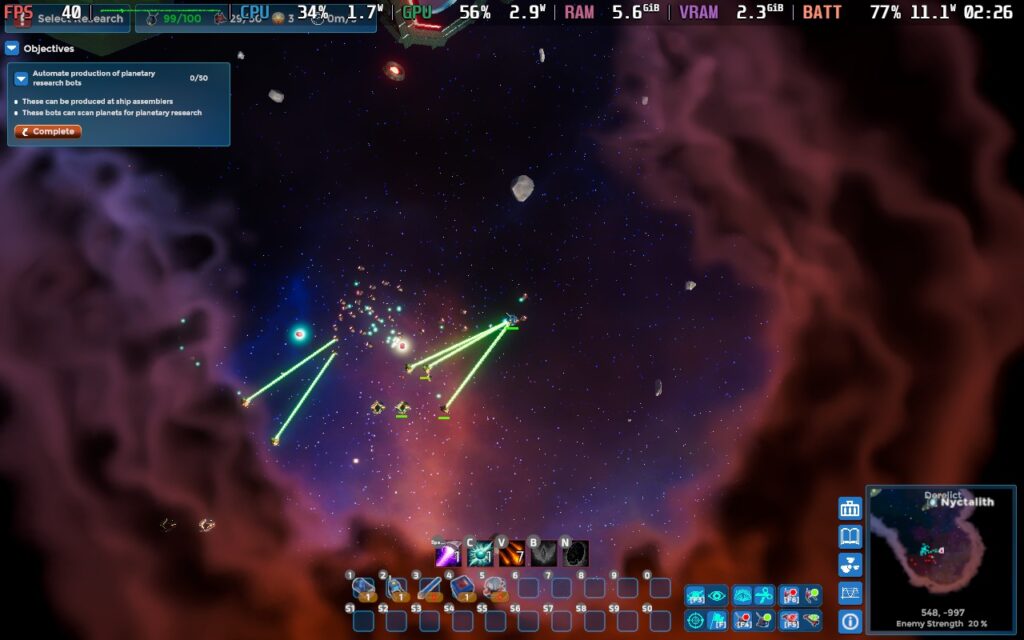
Combat-wise, I wasn't sure what to expect from the game. When first booting, I wasn't sure that the game had combat, but it doesn't take long for you to run into your first enemy. The combat is fairly basic. As you might expect from a game about automation, your fighter drones will do most of the fighting with you. You can research better drones and better fleet tech, allowing you to have more drones with you, but they will essentially follow the player's ship and attack anything that gets close to you.
Enemy bases are mostly made up of fleets of enemy ships alongside spawners, which periodically spawn ships that can be destroyed. You do have some abilities you can use in your command ship, such as a fairly weak weapon that pales in comparison to the large number of drones you'll soon have and the ability to order your drones about a bit if you want them to be more focused in a particular place.
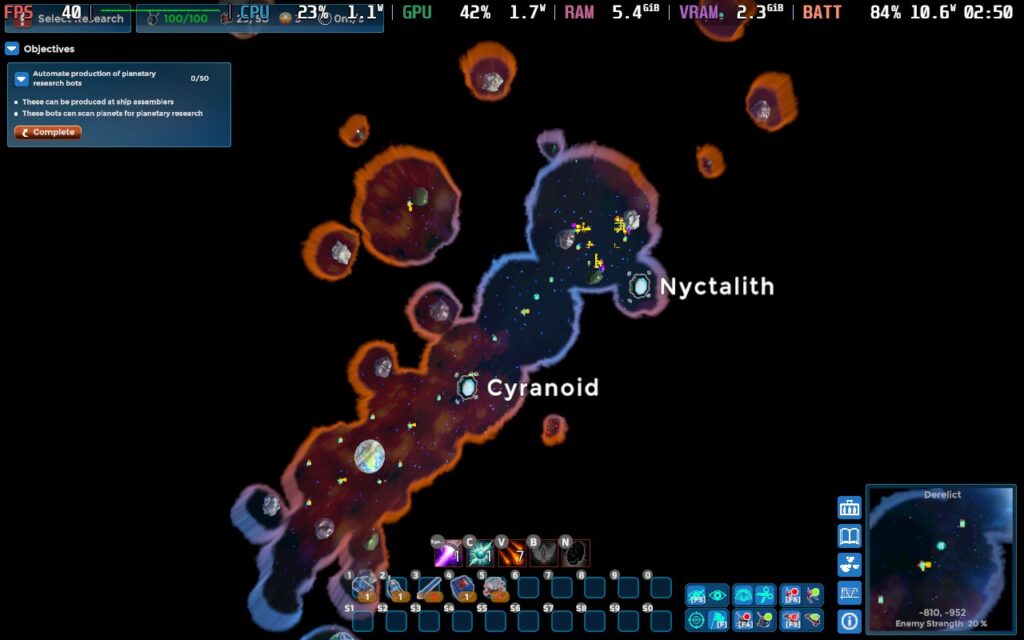
The world map has some interesting mechanics. Nearly all of the map is covered in the "fog of war." Interestingly, once you explore an area, if you don't maintain an active presence there with yourself or an exploration station, the fog will gradually reclaim the area, making you lose sight. This means you need to place defense platforms and exploration stations periodically so you can keep an eye on your empire. The enemies can also rebuild if you let the fog creep in.
Enemy strength also increases the further from the center of the map you get, going from 20% near the center to 300% at the edges of the map. They also seem to get more frequent. There's a little indicator at the bottom right that lets you know how strong the enemies are in your area.
Exploration is rewarded in the form of ancient alien structures, these can be star gates, which allow fast travel, or giant obelisks which can be activated in return for Lumin Orbs. These Orbs can be spent at another alien structure in return for upgrading the player's ship. I put all my orbs into increasing the player ship's speed, as I soon found traveling any long distance to be painfully slow, and as I said, upgrading health and weapons was a bit pointless, as I mostly let my drones fight for me.
Final Factory looks okay at first glance, with full support for 16:10 aspect ratio resolution, including the Deck's native 1280x800. Unfortunately, things do fall off a bit after that. There's no native controller support, so a community layout is needed to control the game. That does mean controlling things lacks some polish and is much slower than just using a keyboard and mouse.
The UI is also a bit of an issue. I don't often find this a problem, even on games where Valve's testing supposedly says it is, but Final Factory has a small UI, and while it does offer UI scaling, it just doesn't do the job very well. It only offers to scale up to 110%, and any scaling beyond 105% results in UI elements clipping inside each other. You can check out the comparison screenshot below to see 105% vs. 110% scaling and notice how the 110% causes UI elements to overlap, making it unpleasant to play with and look at.
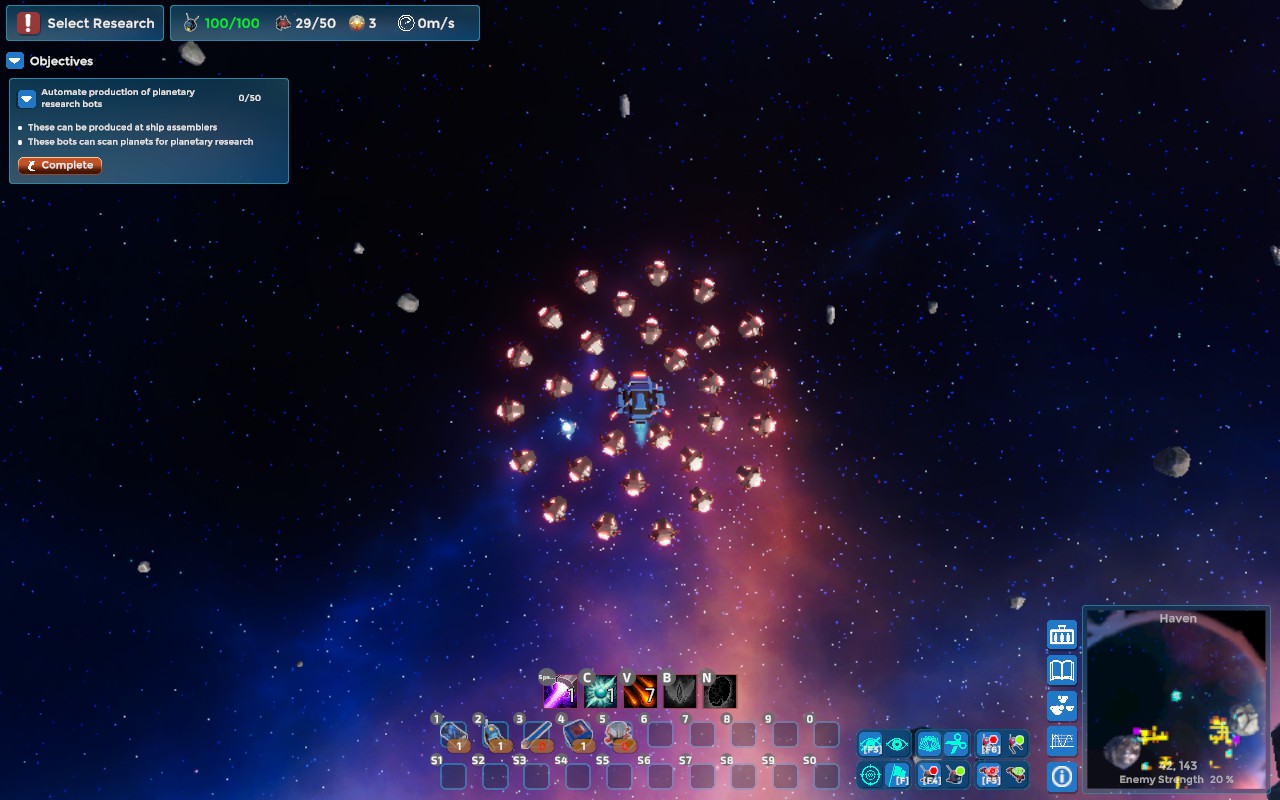
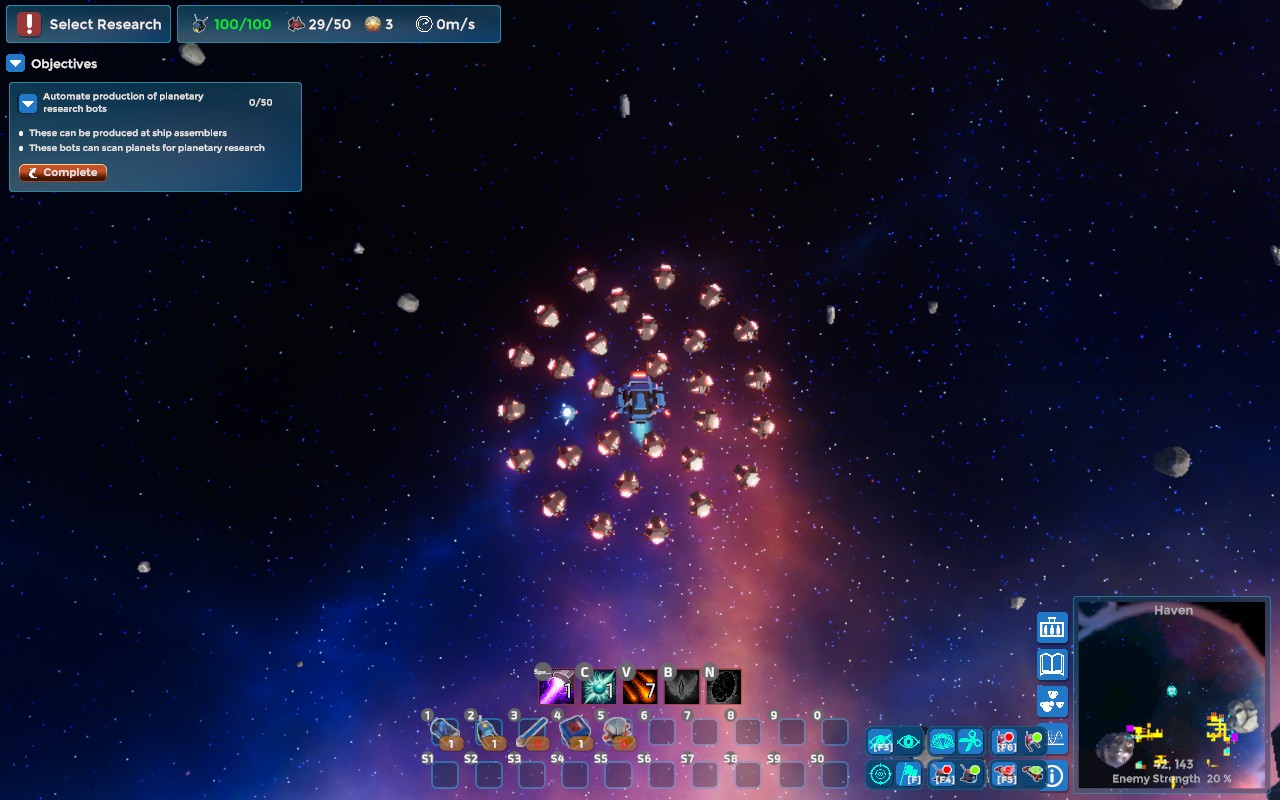
Ultimately, we'd need 120% or 125% scaling to make the text easy to read on the Deck and a fix for those UI elements merging. The recommended community controller layout does map a magnifier to L1 on the Steam Deck, so you can zoom in to text if need be, but it's far from ideal.
We also don't have many graphics settings for Final Factory; it is just a simple "Quality" option with Low, Medium, and High options. The main difference between the options seems to be shadow quality, and some Anti-Aliasing also comes into play. But I prefer the "Medium" option for my recommended settings. It clears up some of the aliasing on the edges of stations and offers some shadows, instead of Low, which has pretty bad aliasing and no shadows.
Final Factory is more CPU intensive than GPU, so we can afford some graphical quality without sacrificing much performance.
Note: Because of the sandbox nature of Final Factory, we can't account for every scenario in our testing. I didn't, for example, build a large factory covering the entire map, which would undoubtedly cause performance issues.
For Final Factory, we're locking our Framerate to 40 FPS/Hz in SteamOS and setting our TDP limit to 10W.
As I said before, we're just going to run the "Medium" quality setting, which helps ensure that the GPU doesn't take away any power that the CPU might need when things get more intensive. We're keeping the resolution at 1280x800, as it's difficult enough to see text as it is! We're also disabling Vertical Sync.
These settings are based on a factory made after a few hours of playtime. As you progress further into the game and get larger factories, your performance may well suffer. In that case, you can try increasing your TDP limit and lowering your framerate to 30 FPS.
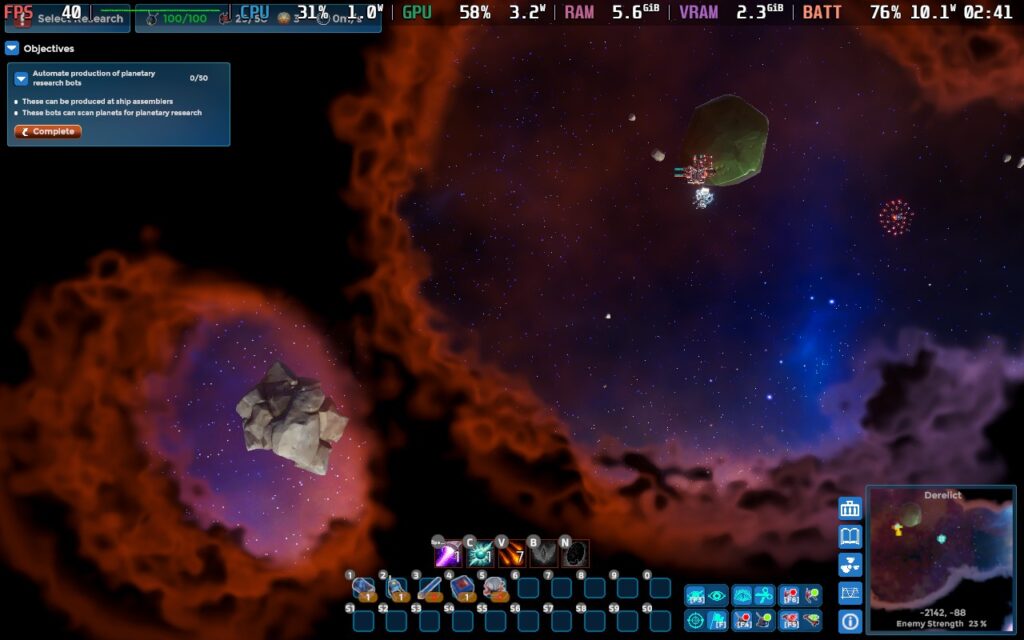
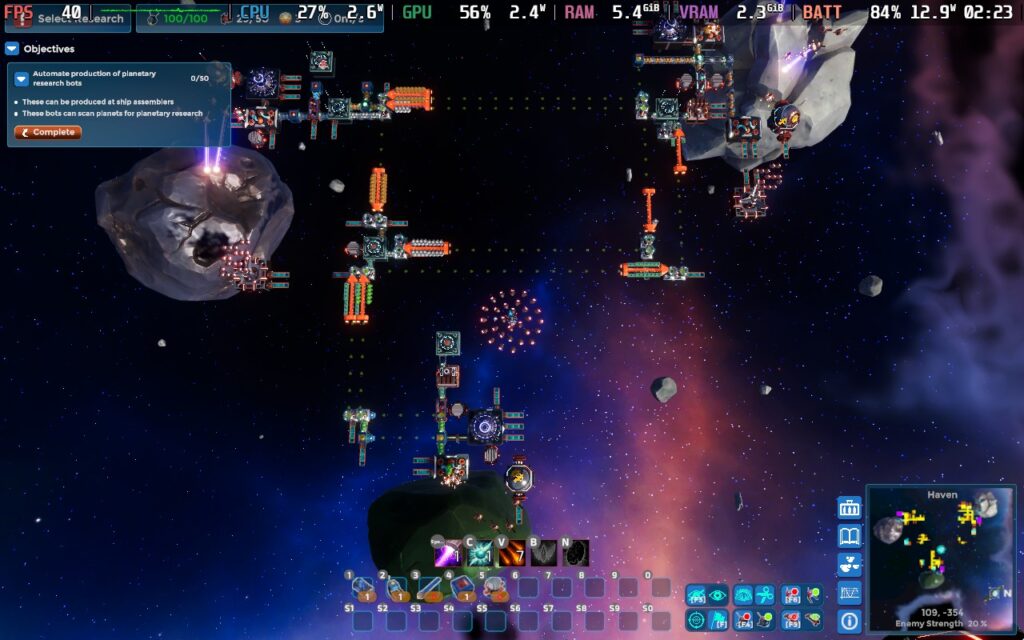
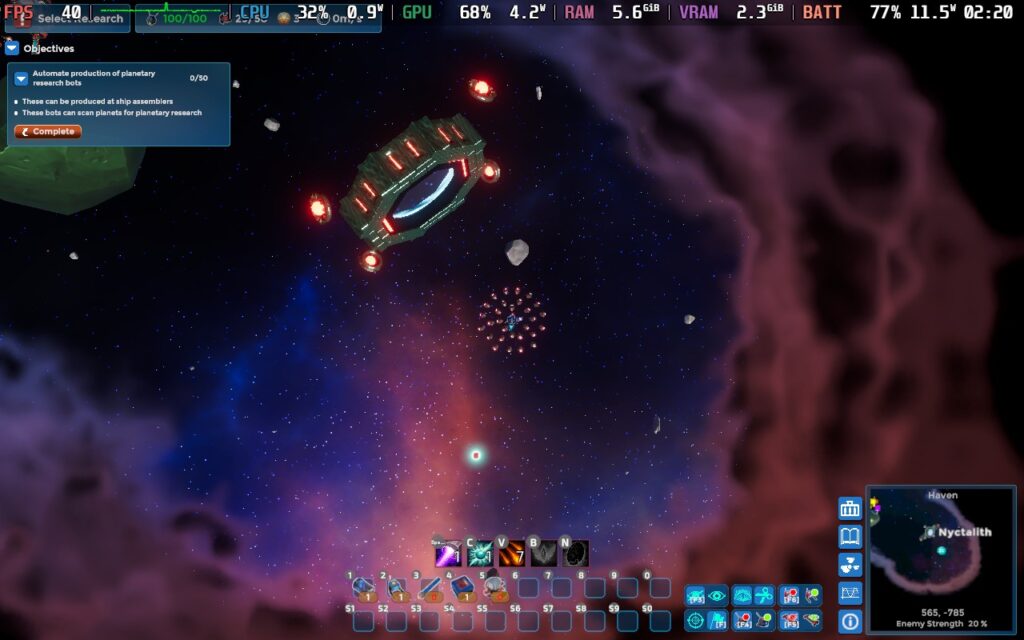
The game does suffer from stutters at times. This is unavoidable, regardless of the TDP limit, and I imagine it's probably to do with a sudden CPU spike. However, as Final Factory isn't very action-oriented, I feel like the game still feels playable as far as performance goes.
Battery drain can vary quite a bit, Final Factory seems to quite effectively cull objects that are out of view, even cutting down on how CPU-intensive factories are when they are off-screen, therefore I generally found the battery drain to be about 11W when in quiet areas, and going up to 15W in busy areas. So, on a Steam Deck LCD, you should expect around 2.5 hours of battery life, maybe 3 hours in a pinch. Steam Deck OLED players can expect at least 3 hours of battery life, likely 3.5 hours.
Final Factory offers subtitles, UI scaling, which we've already covered earlier in the article, and the ability to "disable skybox motion," which stops the background in the game from moving. The movement is very slow and almost imperceptible, but it must have bothered some for it to be an option. You can also remap the controls.
That's it as far as accessibility is concerned.
Final Factory is for a specific set of people. Those who enjoy painstakingly planning out their stations so that they can have a smooth-running logistical operation will probably love Final Factory. Planning and logic are an absolute necessity rather than a nice-to-have here.
The gameplay outside of the factory building does fall a little flat. Combat is mostly non-interactive, with your defense platforms and your fleet taking care of it. So, as long as your factory automates the production of combat craft, you probably don't have to fight yourself actively ever. As you would expect, all mining, research, and crafting will eventually be automated.
Story-wise, I'm not sure how much is going on here. It's vague, although I think we're the bad guys, much like Factorio. We aim to exploit the system of its resources while the native inhabitants fight back. The ancient aliens who left the artifacts in space seem to be on your side, but again, it is hard to say if they were good or evil.
Final Factory will be enjoyable to those who love Factorio, as it plays very similarly in its gameplay mechanics, so if you want to dive into another game in a similar vein but with a different atmosphere and a few alterations, Final Factory might be the game for you. If you disliked Factorio and how much it taxed your brain, Final Factory is no different, so you might want to steer clear! I wasn't a huge fan of Factorio, so that's reflected in me giving the game 3.5/5, but I think there's a solid game here if you're into that kind of thing.
Performance on the Steam Deck is acceptable. Even with a fairly large factory, maintaining 30 FPS is attainable despite occasional stutters. The main issue is the UI scaling, as some text is genuinely hard to read, and the controls are also a little confusing to get used to at first.
Our review is based on the PC version of this game.
If you enjoyed this review, be sure to check out the rest of the content on SteamDeckHQ! We have a wide variety of game reviews and news that are sure to help your gaming experience. Whether you're looking for news, tips and tutorials, game settings and reviews, or just want to stay up-to-date on the latest trends, we've got your back.
This game was tested with a Steam Deck LCD. OLED testing is coming soon.
Manor Lords was provided by Hooded Horse for review. Thank you!
I won't lie, I was very excited when I heard I'd be reviewing Manor Lords. It's been on my wishlist for months, which is probably the case for many of you, seeing as it was the #1 wishlisted game on Steam before its release. In case you're not familiar with the game, it's a medieval colony builder where you start with a small settlement and build it up into a large town while providing for its inhabitants' needs and desires.
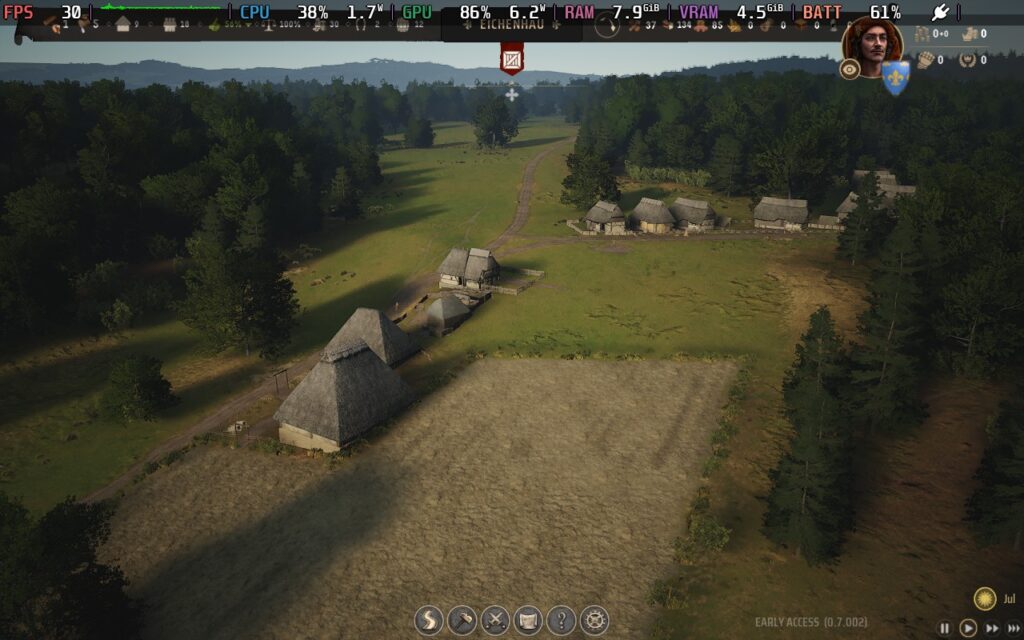
The main focus of Manor Lords is on your town's economy. Your citizens have needs, the most basic ones being food, shelter, and firewood. I didn't struggle with too much with firewood and shelter. As long as you have some woodcutters doing their job, you should be fine with both. Food, however, is a bit more in-depth, and I love that.
At the very start of the game, you'll likely use a forager to gather berries or a hunter to hunt wild animals. There are drawbacks to both. Berries only grow during the Spring and Summer, so while it may tide over a small population through Autumn and Winter, as you expand, it won't cut it anymore. Hunting is available year-round, but you have to be careful not to over-hunt and deplete the wild animal population, so it doesn't quite provide as much food as berry picking. This is where farming comes in.
Farming in Manor Lords has a fairly complex system. Not only do you have to pick a good spot to place your farm and fields, one with plenty of space, but you also need to make sure the soil is fertile for the type of crop you wish to grow. Not only that but as you grow crops, the soil fertility will fall, which means that for some years, you may have to forego growing crops and instead fallow your fields to restore fertility. This means you have to store food or at least run multiple fields on a rotation so you can keep a steady supply of food.
All of this just adds a bit of variety to the game's economy. You aren't just setting things up and then letting them run like in most colony builders; you have to actively manage your economy, shifting workers off berries in the cold months to other jobs and setting the crop rotation of your fields to ensure they stay healthy. This kind of depth and micromanagement is what I wanted from Manor Lords, and it delivers.
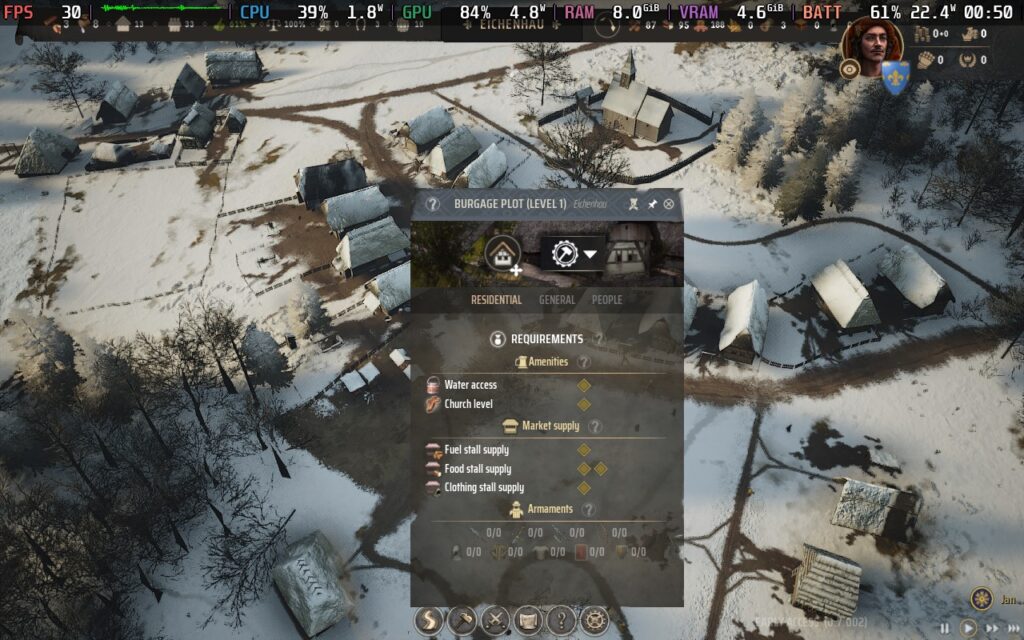
Beyond your citizens' immediate needs, they also have luxuries like clothing and access to a church and tavern. As you meet your citizens' needs and luxuries, you can level up their dwellings, which will, in turn, allow you to level up your settlement status, giving you access to perks and new unlocks. Be warned that higher-level citizens have more complicated demands, so make sure you can accommodate their demands before upgrading every dwelling you can. I made this mistake and almost starved my entire settlement due to the increased food demand.
This brings us to the "perks" of the game. Each time your settlement levels up, you gain a development point, which you can invest into a "perk." These are little advantages you can give yourself and your settlement. There's one that means your sheep can breed, which reduces the need to purchase them, or one that lets you place a food cart that constantly drains your gold but produces bread. All of this seems balanced fairly well.
There are also policies you can enact, such as fasting to reduce food consumption, but also drop your citizen's approval of you. These seem pretty work-in-progress, with many policies unavailable due to the game being in early access.
The economy in Manor Lords seems well-balanced. It balances between giving too much to your people or being unnecessarily brutal. If you struggle to provide for your citizens, you can probably pinpoint what you did wrong that caused it, not some anomaly in the game's simulation causing issues. Plus, there are plenty of options for the scenarios to adjust the difficulty to suit your preferred style of play.
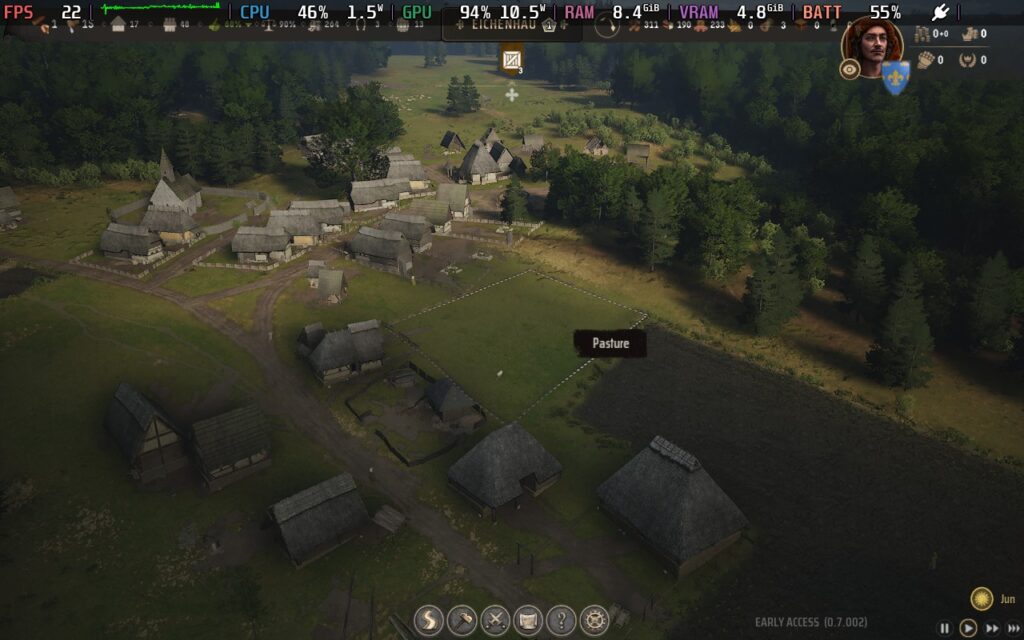
In early access, Manor Lords only has 1 map. However, it's made up of different regions, and each time you start, you'll be randomly placed in a region, so the game does have a slightly different feel with each playthrough. There are also 3 scenarios: one where the aim is to expand your settlement, with no combat, another that is pretty similar to the first, but there is now the threat of raiders and a rival AI that controls some regions, and finally one that has a more difficult economic situation and also the threat of raiders.
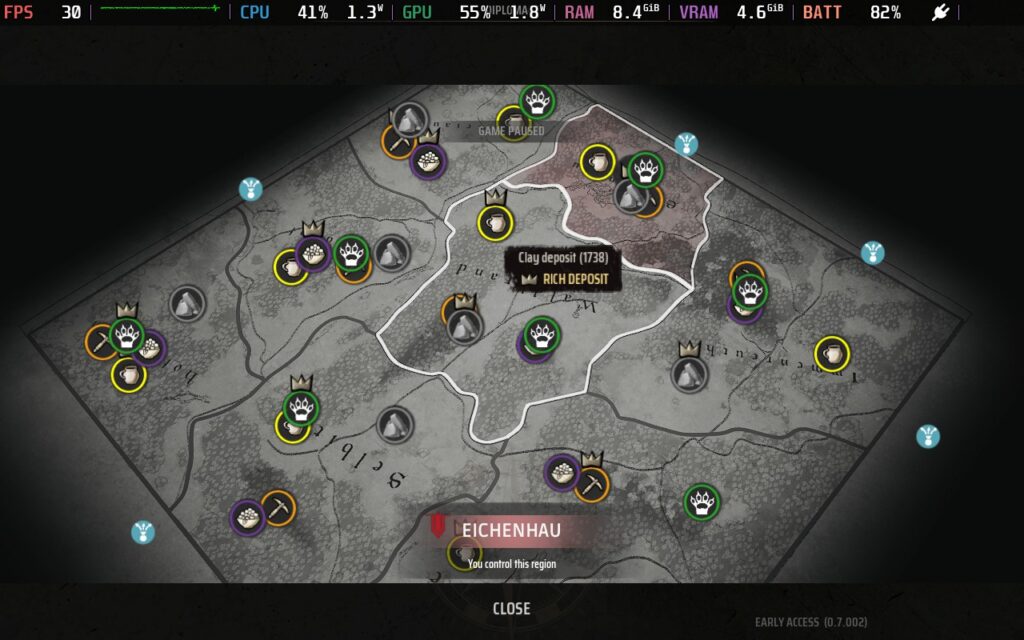
There are also no on-map AI lords. This is planned for the future, but right now, your opponents are random bandit camps and regions controlled by an AI lord that isn't present on the game map.
Combat isn't hugely interactive, but it does have its own complexities. When enemies approach your settlement, you can choose rally points for your different types of units. Once in position, you can tell them their orders, which range from aggressive and pushing back to holding their ground or slowly retreating to draw the enemy in. There also appears to be a sort of morale system in place, improving or degrading the performance of units.
I did not fare so well when I received my first raid. I lost all 20 of my spearmen militia, and subsequently, the raiders pillaged and set my village alight. It wasn't great, but it did make for a pretty screenshot!
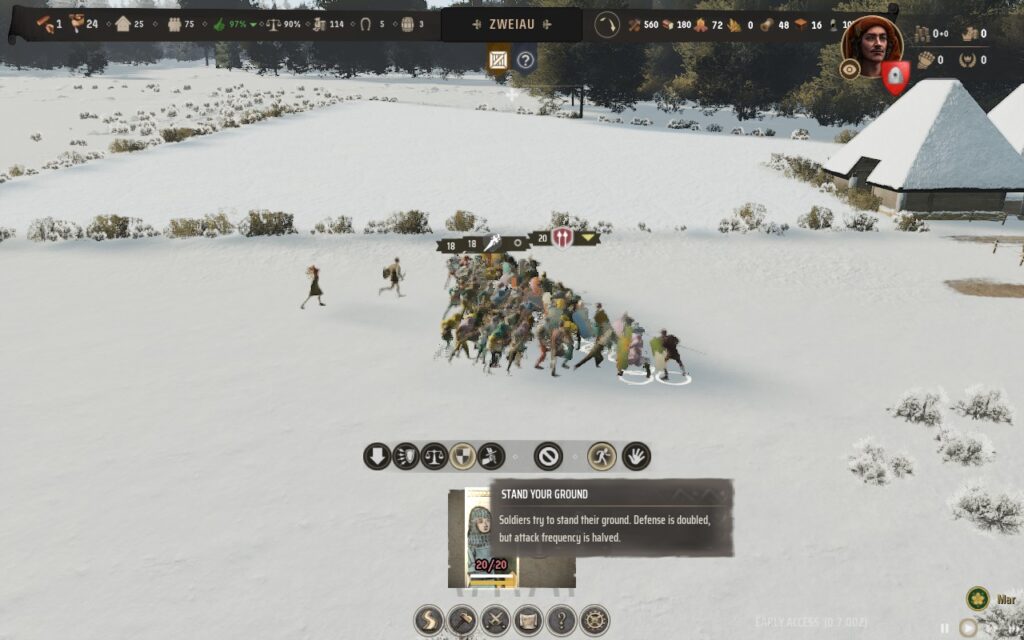
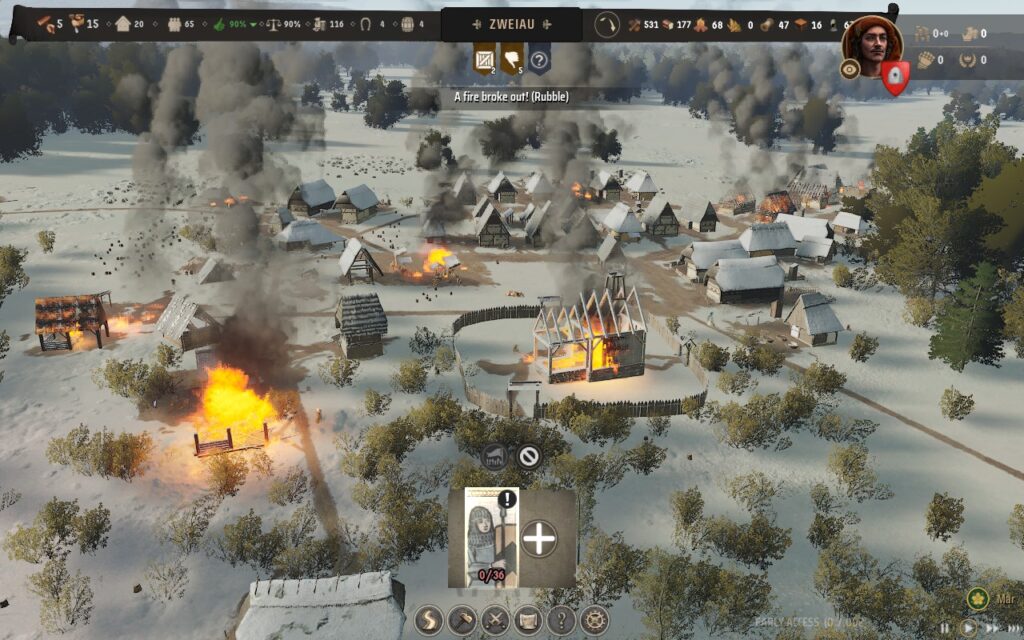
The building system of Manor Lords is also something to take note of. While some buildings are fairly standard in their construction and roads likewise, others use a different approach, with the closest comparison I can think of being the "zoning" method used in games like SimCity and Cities Skylines. Residential buildings, for example, allow you to draw a line along the road to denote the front of the "plot," then you can drag back from the road and place another point, deciding how far back from the road you want the plot to extend.
Depending on the size of the plot, there can be 1 or more houses present, and you can also get what I'd best describe as a "module" slot for each house if there's room around it. These slots allow you to modify a house to produce resources. For example, you can place a vegetable garden or a chicken coop in your house's backyard to provide a small amount of food, or you can turn a dwelling into a shoemaker if the plot is large enough. When struggling for food, I added vegetable gardens to many houses. It's a nifty system and is yet another thing that sets Manor Lords apart as a colony builder.
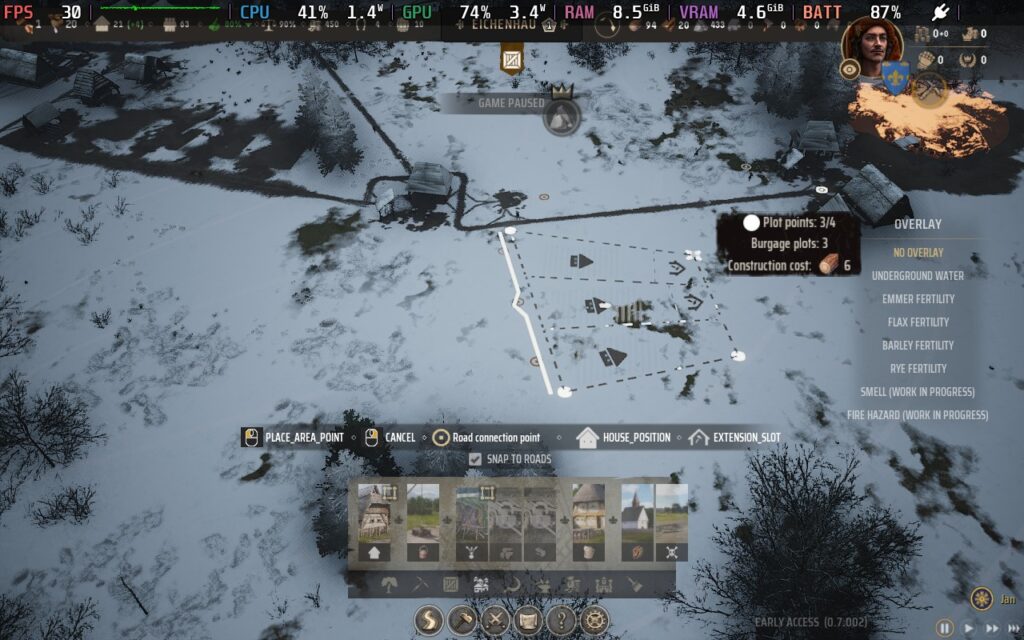
But I can't finish this review of Manor Lords without talking about its presentation. The graphics of this game are just, quite frankly, beautiful. Thankfully, the developer chose to stick with Unreal Engine 4 and not upgrade to 5, which saved us some performance here. Still, Manor Lords has a gorgeous visual presentation, regardless. The game features a day/night cycle, along with seasons, all of which affect how the game looks, with trees turning color in the Autumn, snow appearing on the ground in the Winter, and rain coming down in the Spring.
Even with the settings we have to run the game at to keep things smooth on the Steam Deck, the game still looks great. I really would like to see it run at higher settings on a more powerful device to see how nice it looks.
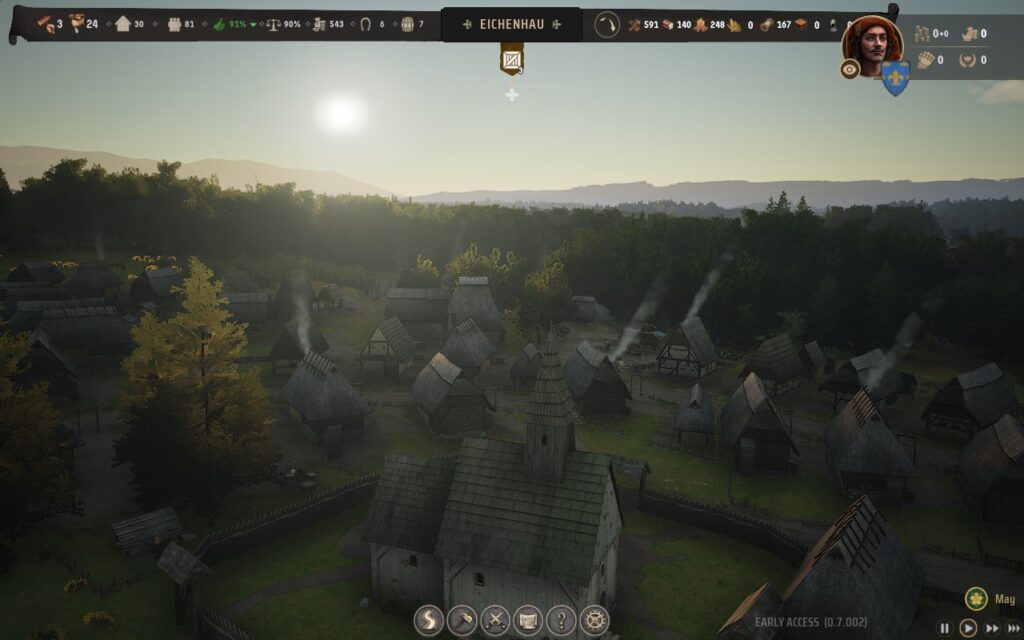
Manor Lords also boasts a "Visit" mode, an experimental mode that allows you to walk around your settlement in 3rd person with your Lord. While there's nothing you can do in this mode (yet) besides walk around, it's great to see your settlement from this perspective, and the graphics hold up even when this closes. I'd love to see what this mode eventually becomes, but even if it stays as-is, it's a great addition to add a little extra to the game.
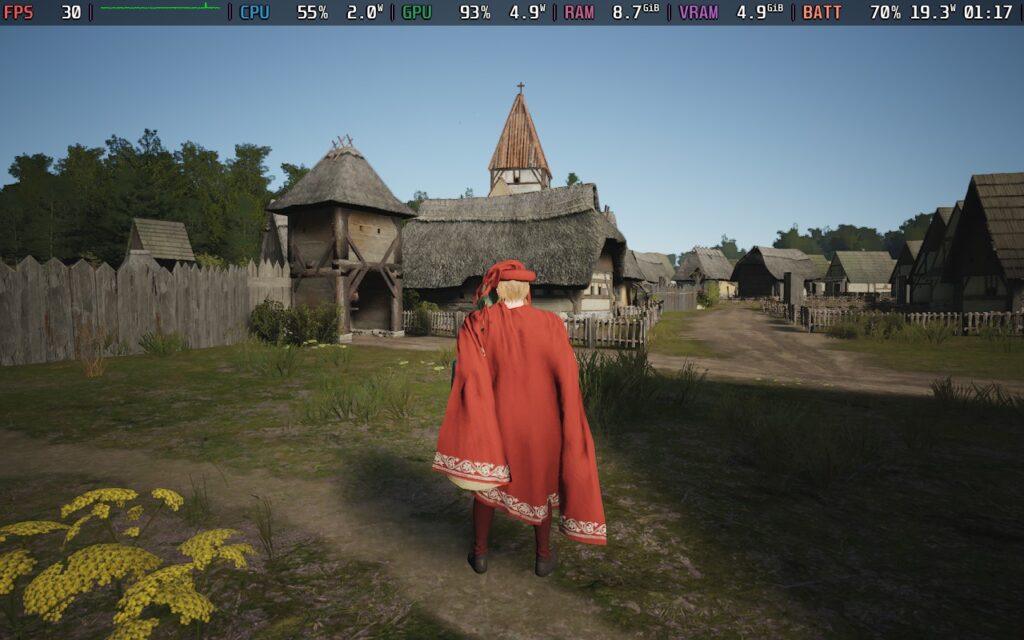
Manor Lords doesn't disappoint in the sound department, either. Ambient music occasionally plays in the background without being distracting, and sound effects aren't obnoxious but subtle. It really all adds to a relaxing gameplay experience.
So, I feel the economy of Manor Lords is spot on. It has a good progression system that allows you to progress at your own pace based on what you can manage, an interesting approach to building, and a beautiful presentation both visually and in terms of audio. The combat is on the simpler side, but it serves its purpose and adds some excitement to the game.
So that's some high praise, but does all of this work well on the Steam Deck? You might be surprised!
Manor Lords greets us by defaulting to the Steam Deck's native 1280x800 resolution, a fantastic start. The game also uses a custom controller layout, as it doesn't have controller support. The developers have created a layout for Steam Decks, and in my time with the game, it works pretty well. I'd change a couple of things, such as mapping the right analog to control camera rotation, but besides that, it works.
Note: To make the right analog control camera rotation, set it so touching the right analog is a middle mouse click, and set the right analog to function as a mouse. You'll need to use the right touchpad for mouse controls, but you can now control the camera with your right analog.
The game's UI scaling is almost perfect. The only issue that I noticed is that your military strength gets cut off behind your character portrait, but it's not a huge deal. I found pretty much all the text and UI elements in the game to be legible. There is also a UI scaling option if you need it.
Manor Lords also offers upscaling methods, including FSR and various graphical options, so let's dive into the recommended settings for the game on Steam Deck.
For this one, we're locking our framerate in SteamOS to 30 FPS / 60 Hz. We're also not setting a TDP limit, as Manor Lords does need quite a bit of power to run well.
For the most part, we'll be running Medium graphics settings, although we are lowering Shadows to Low, as they're just a bit too much for the Steam Deck on Medium, preventing us from reaching the 30 FPS target we're aiming for. Textures will stay on Ultra.
We're also taking advantage of FSR on Quality to give us a little performance boost.
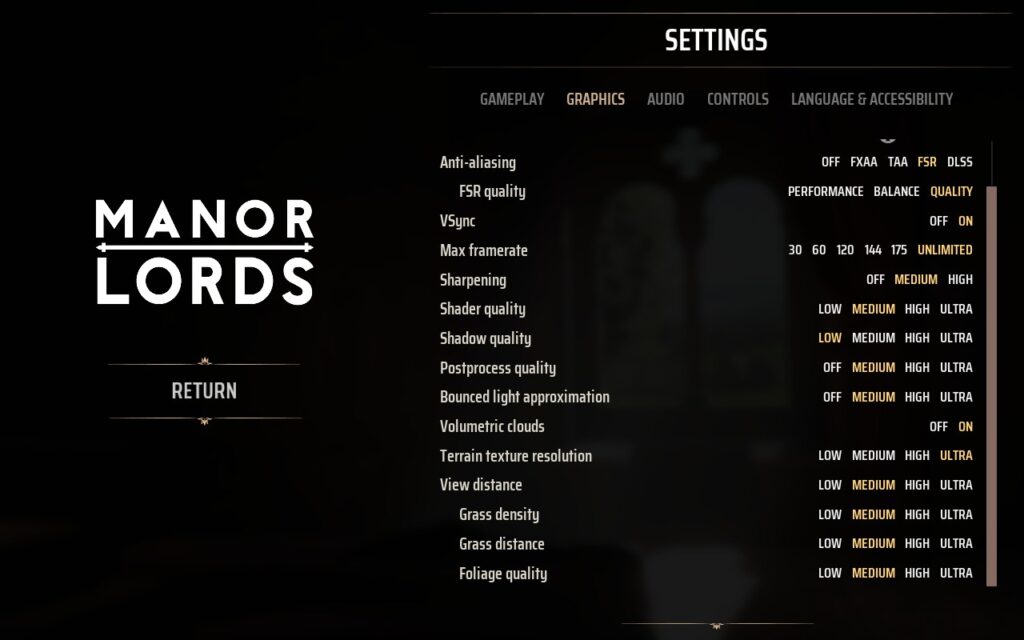
As you can see, most settings are on Medium. The in-game Framerate cap seems to be pretty poor at maintaining a stable framerate, so I opted to keep that on Unlimited. Volumetric clouds also didn't seem to affect FPS as much as you'd think, with them only costing me around 2 FPS in my testing, so I kept them on. With these settings, the game still has a beautiful presentation; you can check it out in the screenshots below.
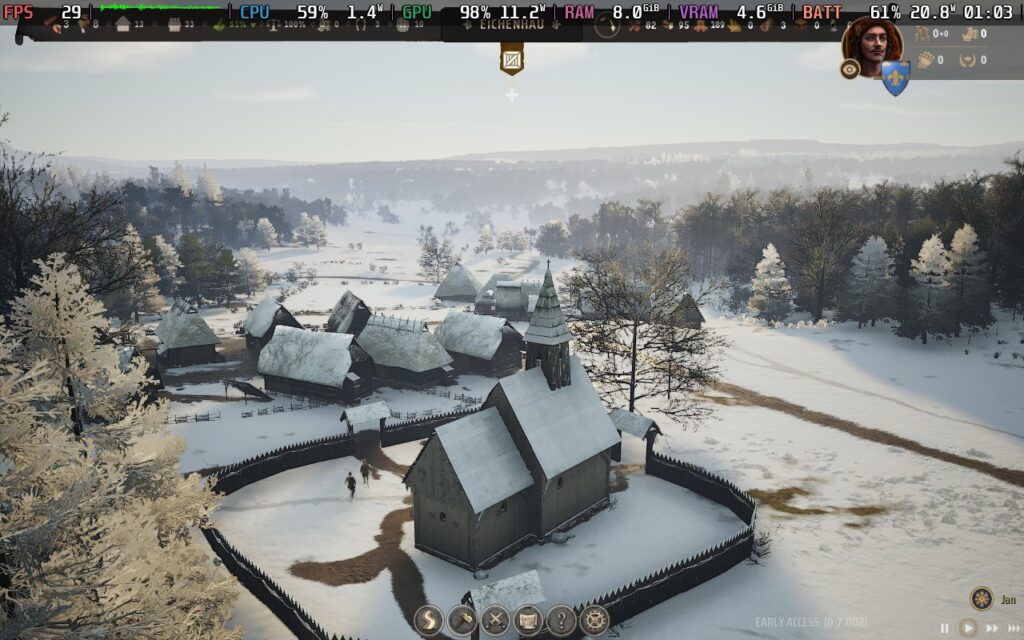
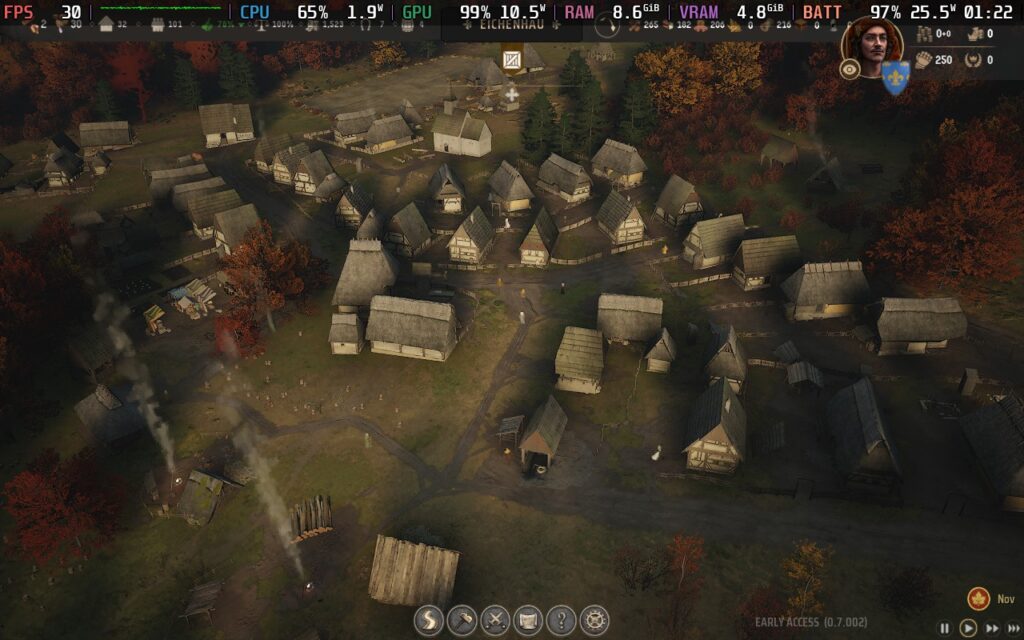
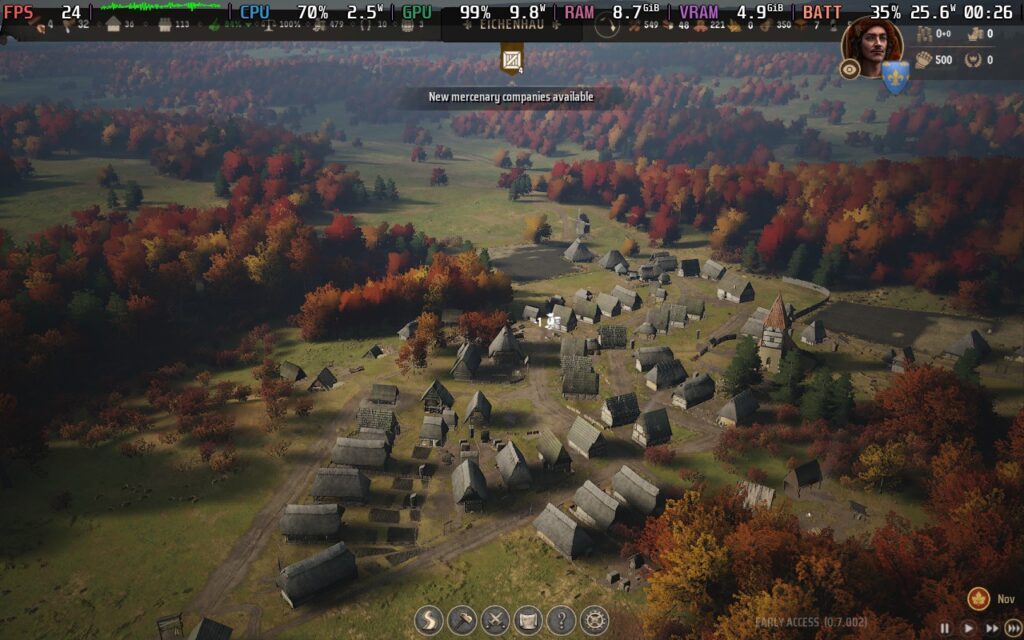
With these settings, you can expect a fairly stable 30 FPS when playing from a normal perspective. If you rotate the camera and look out over the map, as you can see in the third image, then the FPS will drop, as it has to display a lot more than it would in normal play. The "Visit" mode shown earlier runs pretty well, though. I'm guessing being that close to the ground causes a lot of distant objects to be culled from rendering.
Ultimately, I found Manor Lords perfectly playable with these settings. There's the occasional stutter and the FPS can drop from 30 to the high 20s during specific times of day when shadows are long, but generally, the game stays at a good framerate. That's fine for this type of game.
Battery drain is high, however, with a power draw of 20-25W. This means that on a Steam Deck LCD, you'll likely only get 1.5 hours from a full charge. Steam Deck OLED users should expect around 2 hours from a full charge.
Temperatures do get strained, though, generally falling between 75-85C, depending on what you're looking at.
I wasn't going to offer a battery life setting for Manor Lords, but given that we do have some graphical options we can reduce and that I think this game deserves the extra time spent on it, here's a preset to preserve your battery for as long as possible.
For this, set your frame limit to 30 FPS / 60 Hz in SteamOS and a TDP limit of just 8W.
We're running the lowest settings here, except textures. We're also only running FSR on Balanced, not Performance. We have some standards here! Also, under the "Gameplay" tab, we're setting the Cosmetic Day & Night Cycle to "Off." This keeps the game permanently daytime but can reduce situations where sunset/sunrise causes additional strain on the GPU.
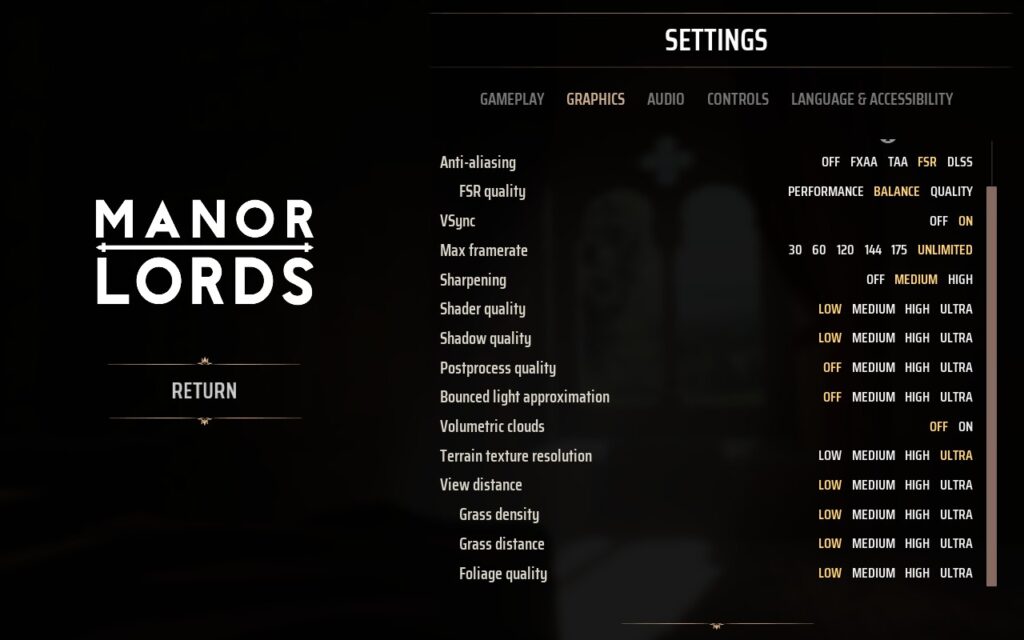
The game does lose some graphical fidelity here. Notably, the shading is worse, but we still keep some shadows, and I think the game still looks better than many colony sims out there, so I'd be fine running these settings, given the battery life boost we can get from them.
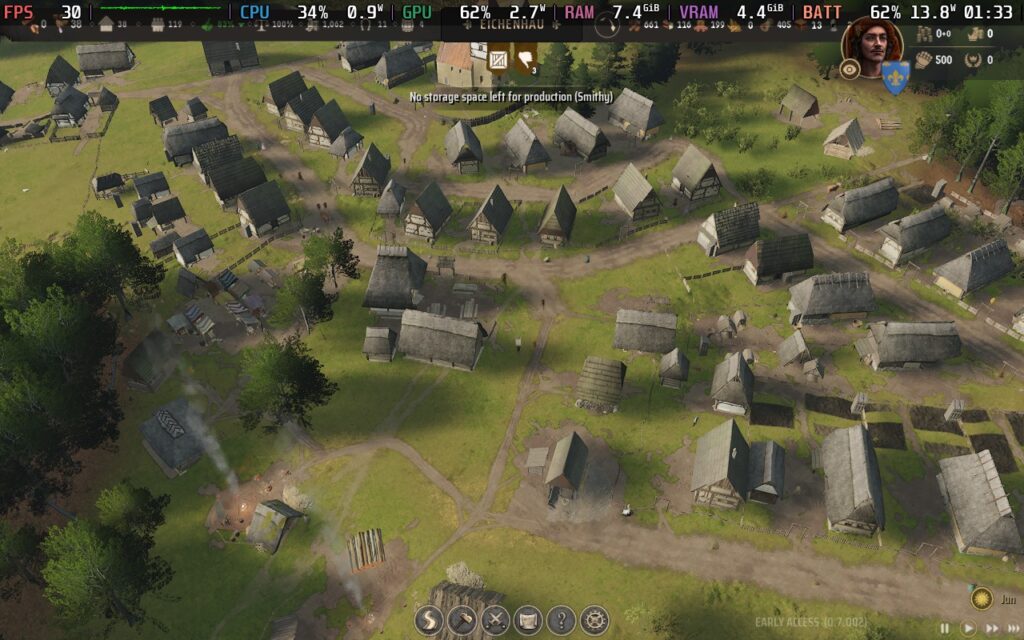
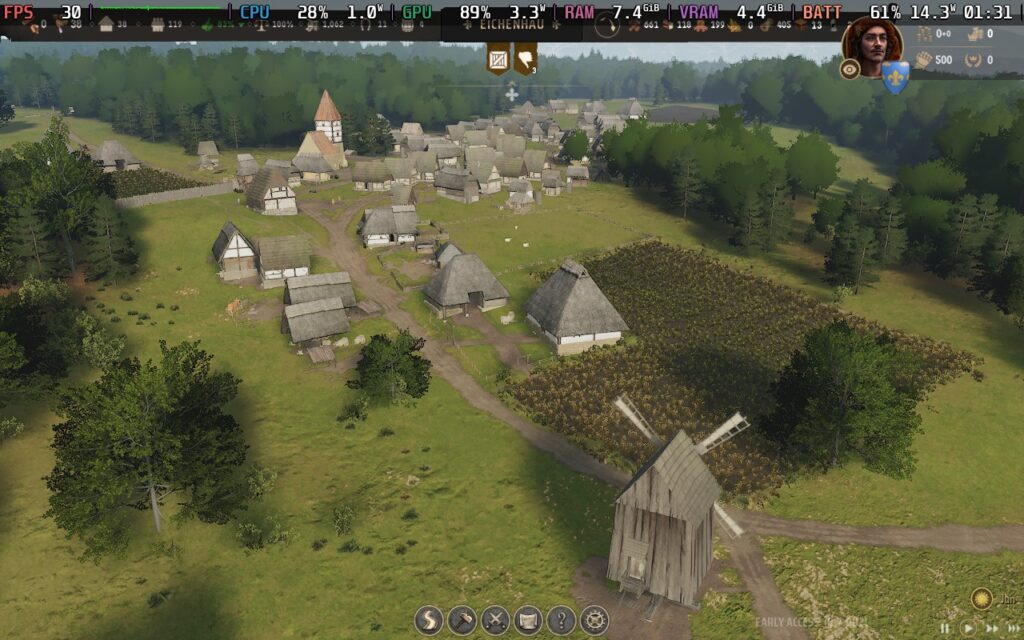
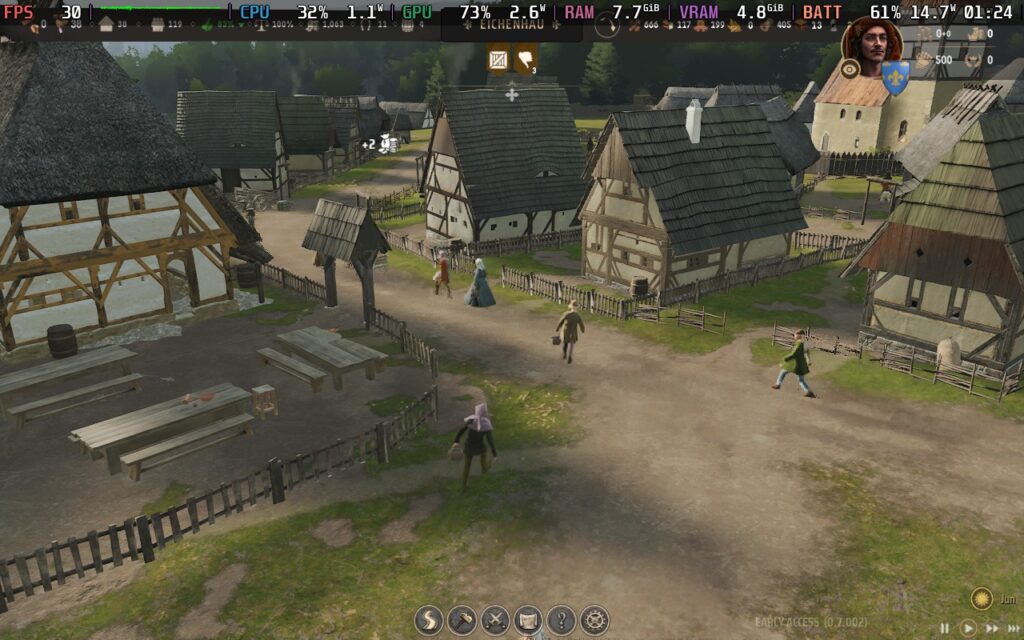
With these settings, battery drain is about 13-15W, so you should get about 2.5 Hours of battery life from a full charge on a Steam Deck LCD and at least 3 hours from a Steam Deck OLED charge. Whether that's worth the graphical compromises and the day/night cycle loss is up to you! Either way, I'm delighted that Manor Lords has such flexible graphics settings.
Temperatures with these settings tended to fall around 60-65C, a big drop from the other preset.
Manor Lords offers little accessibility, mainly UI scaling and rebindable controls. You can also make it pause automatically when an enemy is spotted and adjust things such as camera sensitivity.
Manor Lords was everything I'd hoped it'd be. The construction system allows for the design of natural and genuine-looking settlements. It has beautiful visuals and a fitting selection of audio to immerse you in the world. It's all backed up by a solid economic simulation that demands your attention and the threat of raiding forces to keep you on your toes. The additions of perks, policies, and the "visit" mode are nice and unexpected, they add variety to the game that other games in the genre aren't guaranteed to have, and they're very much welcome here.
Performance on the Steam Deck was better than expected, with a stable 30 FPS possible with the right settings. Although Manor Lords has no controller support, the controller layout made for the game still allows you to have an enjoyable experience while playing on the Steam Deck.
I wholeheartedly recommend Manor Lords to anyone interested in this type of game. It's possibly the best game in the genre that I've played recently.
Our review is based on the PC version of this game.
If you enjoyed this review, be sure to check out the rest of the content on SteamDeckHQ! We have a wide variety of game reviews and news that are sure to help your gaming experience. Whether you're looking for news, tips and tutorials, game settings and reviews, or just want to stay up-to-date on the latest trends, we've got your back.
Sons of Valhalla was provided by Hooded Horse for review. Thank you!
This game was tested with a Steam Deck LCD. OLED testing is coming soon.
I've seen games like Sons of Valhalla around over the years, all the way back in the Flash days, 2D side-scrolling action/strategy games where the aim is to build a base to produce resources and troops, create your troops, and then lead them against the enemy base that is doing exactly the same thing. Back in the Flash days, this was all automated, but Sons of Valhalla gives you more control over things than I expected.
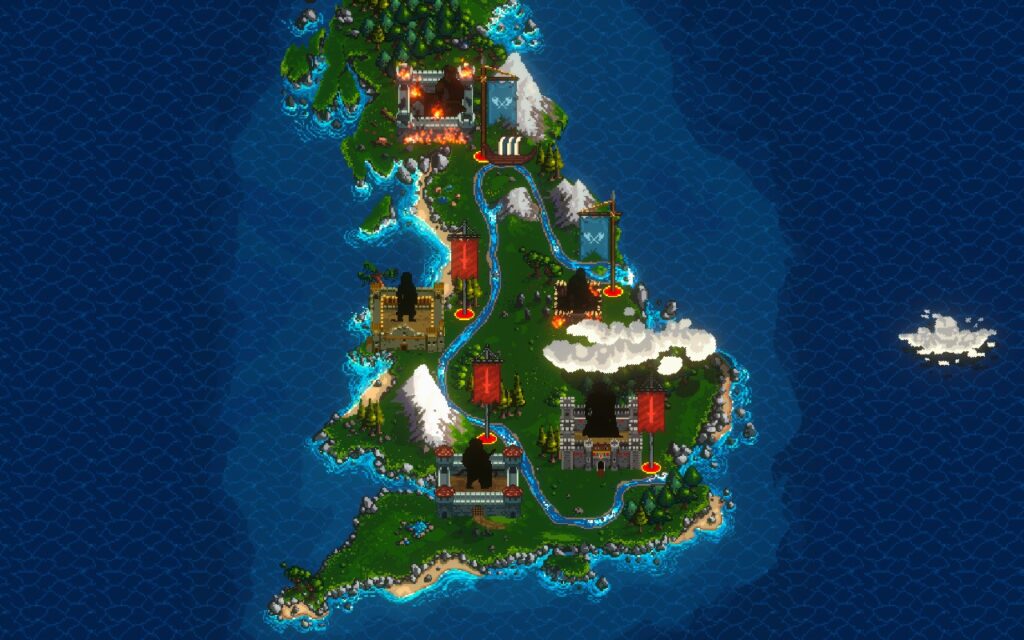
You control the protagonist, Thorald, on a quest through England to find his beloved, who has been kidnapped. The story is very generic, and I described the whole thing in that one sentence. It serves as a backstory to justify your character's invasion of England.
Setting the story aside, having control of your player character is something that Sons of Valhalla does reasonably well. You have a melee weapon and a ranged weapon equipped, which you can upgrade throughout the game, enhancing both their stats and adding new abilities to them. The combat isn't particularly fluid; you can't move when swinging your sword, for example, and setting up a ranged attack can take several seconds, so the action does feel rather "static" as you play, and that's a running theme, unfortunately.
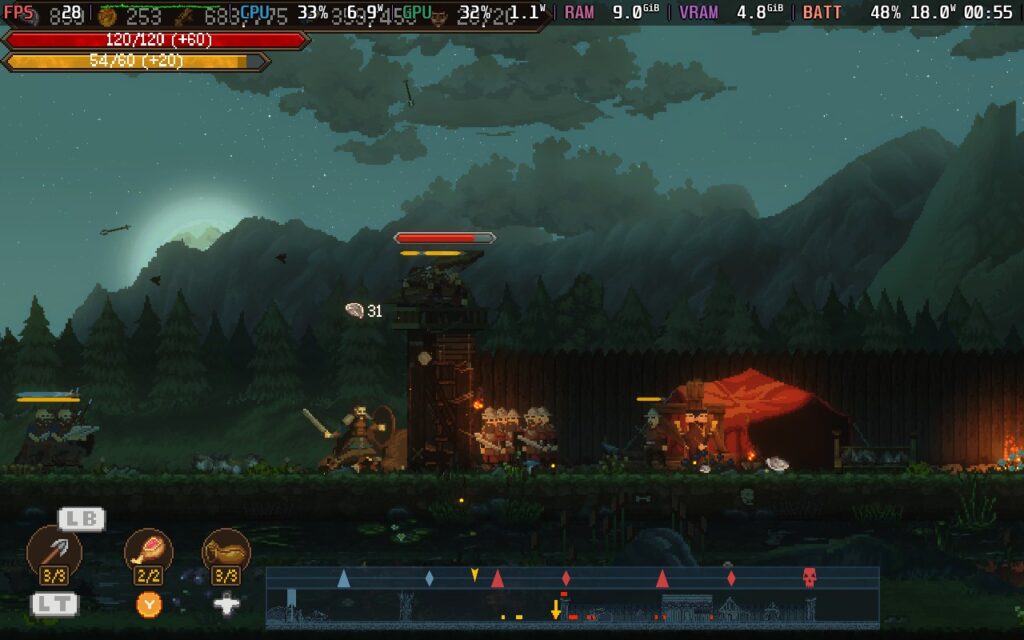
That "static" feeling brings us to the game's AI for both the enemies' troops and your own. In this regard, I'm afraid Sons of Valhalla does pretty much take a page straight out of the Flash games that came before it. If your or enemy troops are attacking a fortification, they'll all bunch up into one space and just merge into what looks like 1 unit, but in fact, there are about 20 swordsmen; they're just all standing in the same spot. Unfortunately, this makes it very difficult to work out what's going on.
However, I understand why this is being done. If troops can occupy the same space, then it would cause issues with them getting in the way of each other when attacking. But it reduces the sense of scale and makes it confusing. When an enemy is attacking you, it's difficult to determine how many are attacking. When you're attacking the enemy, it becomes incredibly difficult to work out how your troops are doing. The only way to tell if you're losing troops is to look at the "unit" resource at the top and see if it has changed.
It all ends up creating an uninteresting picture, with your units standing at the bottom of a watchtower, poking it, your archers and siege weapons half a screen back, firing, and the enemy melee units standing on the other side of the tower doing nothing because they don't want to die.
This may be the only way to ideally handle troops in a game like this, but that might be why games like this have died out since the Flash era. The only comparable game to this in recent memory is Kingdom Two Crowns, and that feels slightly different as the enemies are much less bullet-spongey, so it kind of reduces the chance of bunching up when they're constantly being killed and replenished, that isn't the case with Sons of Valhalla, and battles are mostly made up of about 20 units on each side and can last quite some time.
The AI for some units also seems questionable. Siege weapons, for example, will always target the nearest enemy, whether that's fortifications or a unit. So if enemy swordsmen leave the gate, your siege weapons will stop attacking the fortifications they are strong against and instead try to hit the swordsmen. It's infuriating and an inexplicable design choice that needlessly makes the game more difficult.
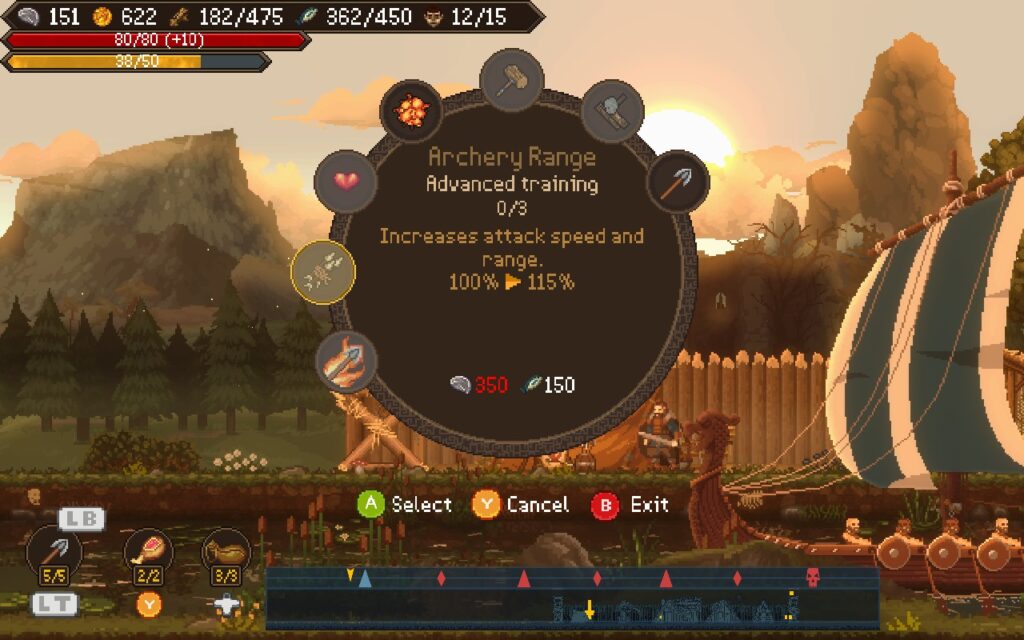
The economic aspect of the game is passable but very basic. It is all about three resources: food, wood, and silver. Food and Wood are passively generated from buildings, so they're very much fire and forget, while Silver is gained from looting chests and defeating enemies. The economy serves its purpose, namely to extend the game by making you wait and defend as you upgrade or recruit new troops instead of always being on the attack.
It's also worth noting that AI doesn't seem to follow the rules of the economy. It looks like they produce units on a cycle, so if you can't kill their units fast enough, they'll just constantly produce 1 soldier every 5 seconds. This gets pretty tedious when attacking, as you must constantly deal with a steady trickle of troops until you break down the fortifications.
Base-building is simple, but like the economy, it does its job. Your central building is the "Mead Hall", which can be upgraded to provide more manpower and additional building slots. These building slots can be used for economic purposes, such as to gain wood or food, or for production purposes, such as barracks, archery ranges, etc. Each building in the game can be upgraded in exchange for resources, allowing it to produce faster and potentially unlock more advanced upgrades for your units.
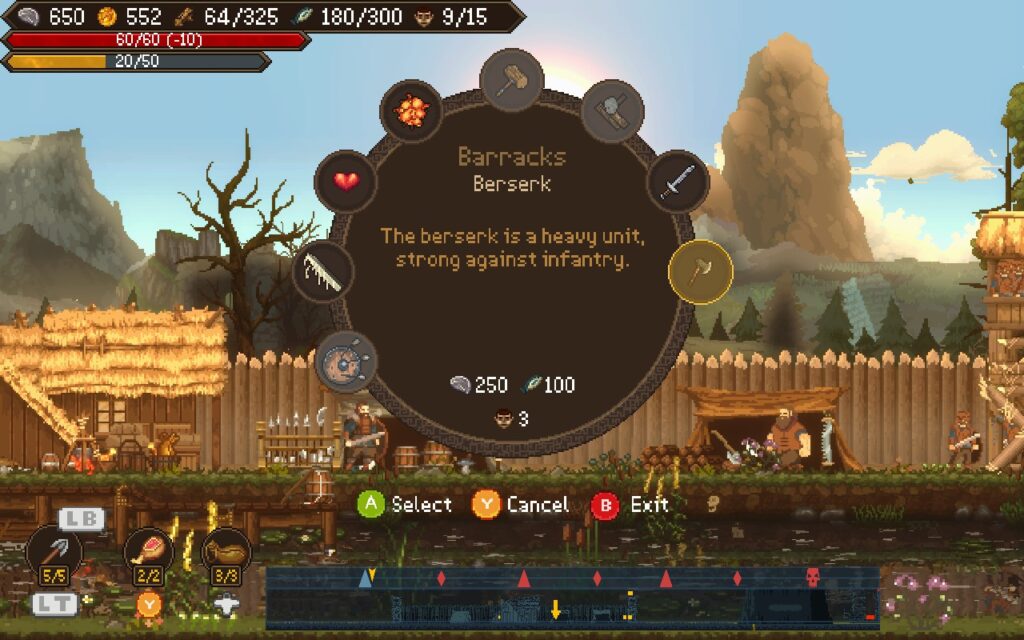
This mix of "action" and "strategy" puts Sons of Valhalla in an odd position. For a game where you are controlling the player character, capable of combat, it feels strange to sit in your town and wait for several minutes while your resources build up. It feels like there's something else you could be doing. It's not like this is a strategy game where you can look around the map and manage things while your economy whirrs away. You have a player character, and you can't do much but... sit there...
It would have been better if it was just a strategy game, eliminating the player character and action elements entirely. Scrolling along the map and quickly ordering troops, managing your economy, and keeping an eye out for enemy attacks would have eased many of my issues with the game. As it is, you have to be next to your troops to issue any orders to them, which can be finicky and pretty much means all your troops will always be in one cluster, as it's the only way to manage them effectively.
Also, you can't freely order troops because everything is centered on the player. Any orders you give have to be to troops nearby, which means that you'll likely keep your army in one big cluster just for simplicity's sake. Otherwise, you'll have to run all over the map, gathering your troops and ordering them—think of a 2D Pikmin-type affair.
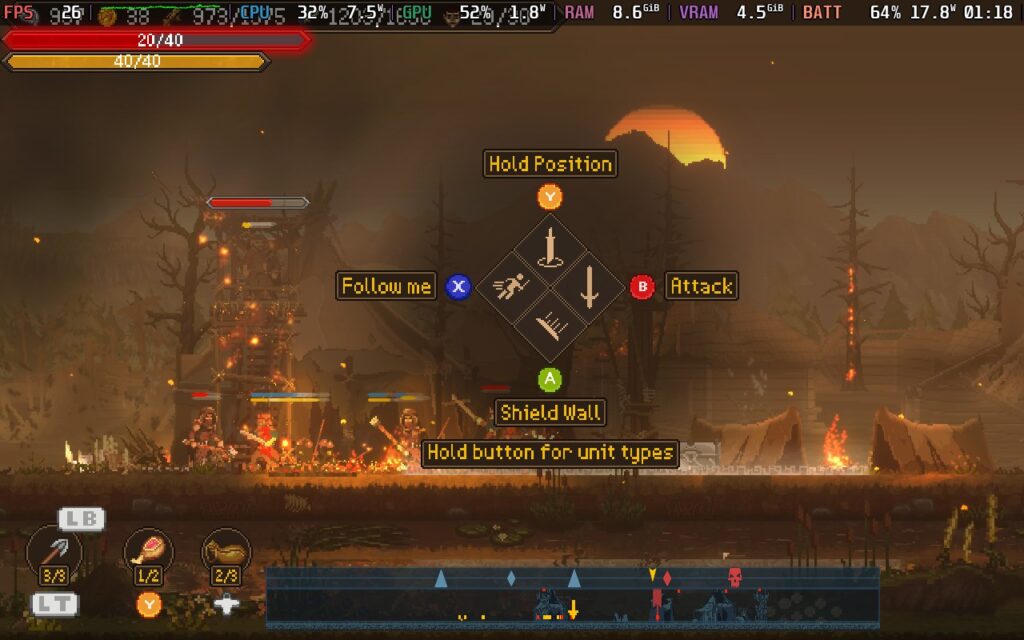
I've been on a bit of a downer so far, but there are two parts that I think the developers got right with Sons of Valhalla.
Firstly, the visuals. The game is portrayed by nice quality pixel art, boosted by some visual effects. You can't complain about how Sons of Valhalla looks. It has pleasing and varied environments, although I'm unsure how "English" this all is. It even incorporates weather and a day/night system, which changes how the world looks and creates a nice bloom effect from the sun in the background. Certain attacks also have nice visual effects and particles for them.
Secondly, the game's "rune" system. Runes are little "perks" you can acquire as you play the game, allowing you to place one in a "socket" and give you, or your troops, a buff. These can be anything from dealing more damage, having a chance to cause a bleeding effect, having more health at night but losing health during the day, and so on. This makes the game more interesting, and you can only have a limited amount, so you'll need to swap and change the runes to serve your playstyle.
Upon death, you'll also need to sacrifice one of your runes to continue unless you're on the easiest difficulty. After that, you can return to the battlefield pretty much as-was.
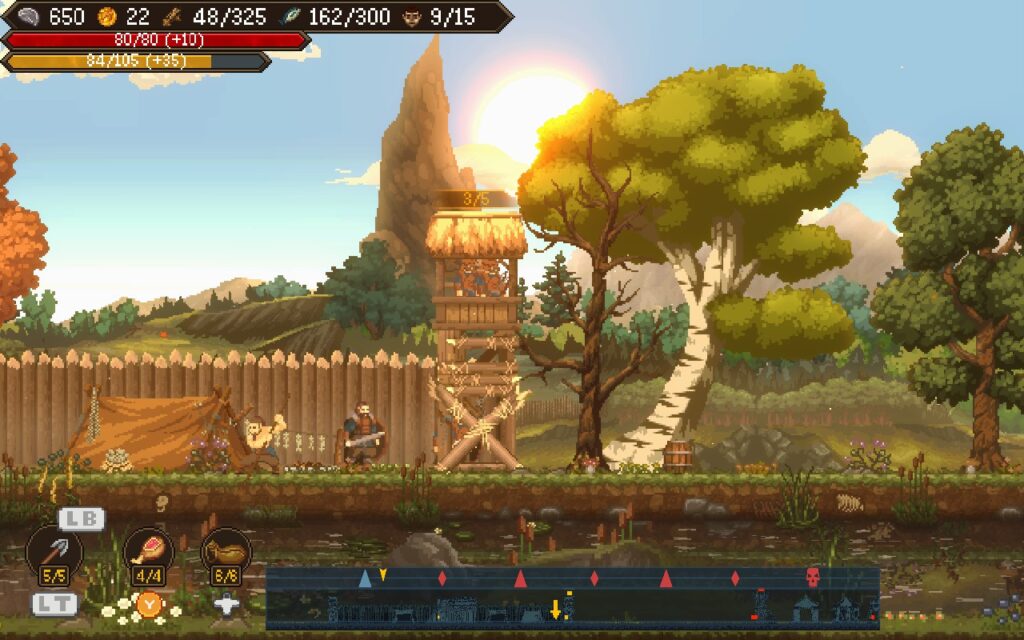
As for the difficulty, on easy, the game becomes mind-numbingly easy. There's no penalty for dying; troops on both sides are bullet spongey, and even though resource generation is quicker, you still have to wait for resources to come in. Higher difficulties present a challenge but also make the grind even longer, perhaps requiring you to build and make several attacks, whereas just 1 would have sufficed in easy mode.
Sons of Valhalla isn't a bad game, but some design choices are questionable. Too much time is spent waiting, and the game is quite short, with the campaign being less than 10 hours long, depending on difficulty and how often you die. On easy, the campaign is about 4-5 hours at most due to quicker resource gathering and easier enemies. The campaign comprises 5 levels, and they all play the same; even the boss battles at the end of each level are similar, and the same strategy can be employed on each. After the 1st level, the game quickly becomes repetitive.
Also, at the end of each level, all upgrades/bases are gone, so you start the next campaign level from scratch, aside from the runes and upgrades you gave your player character. It does feel weird upgrading all your units and then losing all those upgrades for the next level; it only adds to the game's repetitive nature, requiring you to research tech that you just researched 30 minutes ago at the previous level.
But let's move on to how Sons of Valhalla runs on the Steam Deck, and you might be in for a surprise...
Curiously, before you boot Sons of Valhalla, you must sit on a black screen for some time, probably 20-30 seconds, before anything happens. I thought it might be a one-time thing for the first boot, but it happens every time, so just give it some time to get through whatever it's doing.
Once the game has finally loaded, the initial impressions are decent. The game has full controller support for the menus and gameplay. It also supports the Steam Deck's native 1280x800 resolution. However, there are no graphical options besides resolution in the game, so I'm not offering any settings preset because there are no settings.
UI is scaled well, and I found all the text and UI elements in the game perfectly readable on the Steam Deck's display.
We are running a 30 FPS frame limit in SteamOS and a 15W TDP limit. I know, that's setting this up well, huh?
Amazingly, Sons of Valhalla decimates the Steam Deck's CPU. The GPU is almost untouched; in fact, I don't think I ever recorded the GPU using more than 2W while playing. But the CPU is often varying between 6 and 9W of usage, which is pretty much its limit.
All I can imagine is that the entire game is single-threaded, or at least that one CPU thread must be heavily relied upon, which is not good for a Steam Deck.
While the game initially runs at 60 FPS, once you build a few troops, say 10, for the starting level, the FPS drops to around 50 FPS. Going into battle against 10 enemy troops, the FPS regularly dropped into the 40s. By the time I reached level 3/5 in the campaign, I had around 30 troops going up against a similar number of enemy troops. By this point, Sons of Valhalla was regularly running in the 20s, a shocking disappointment.
I had similar issues with other games when running Proton 8.0-5, so I tried Proton Experimental, the Proton 9 beta, and Proton GE, but alas, the issue persists regardless, meaning that it's almost certainly how the game is coded that's the issue.
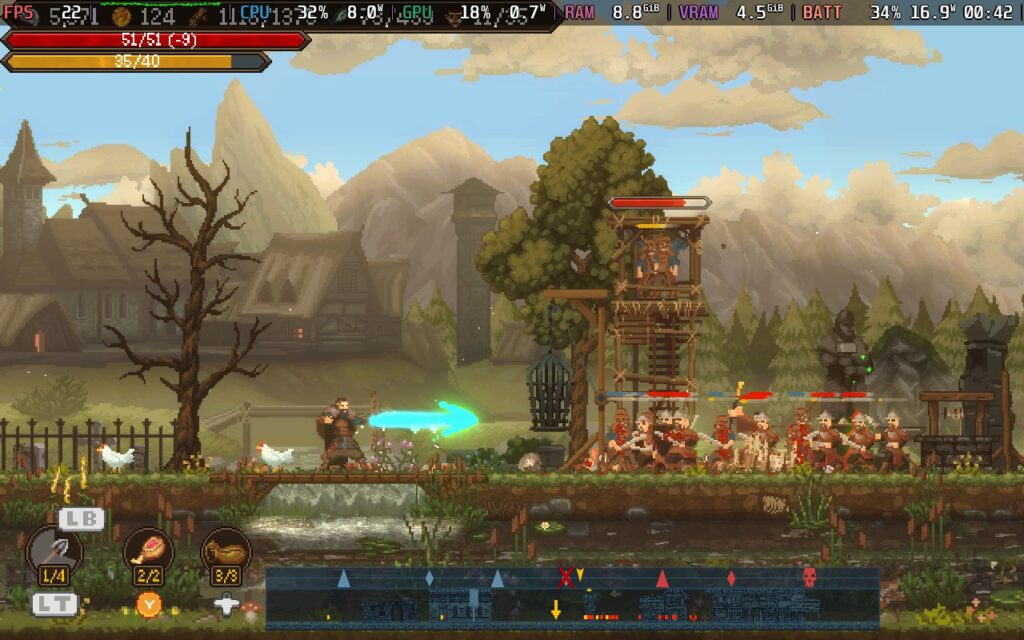
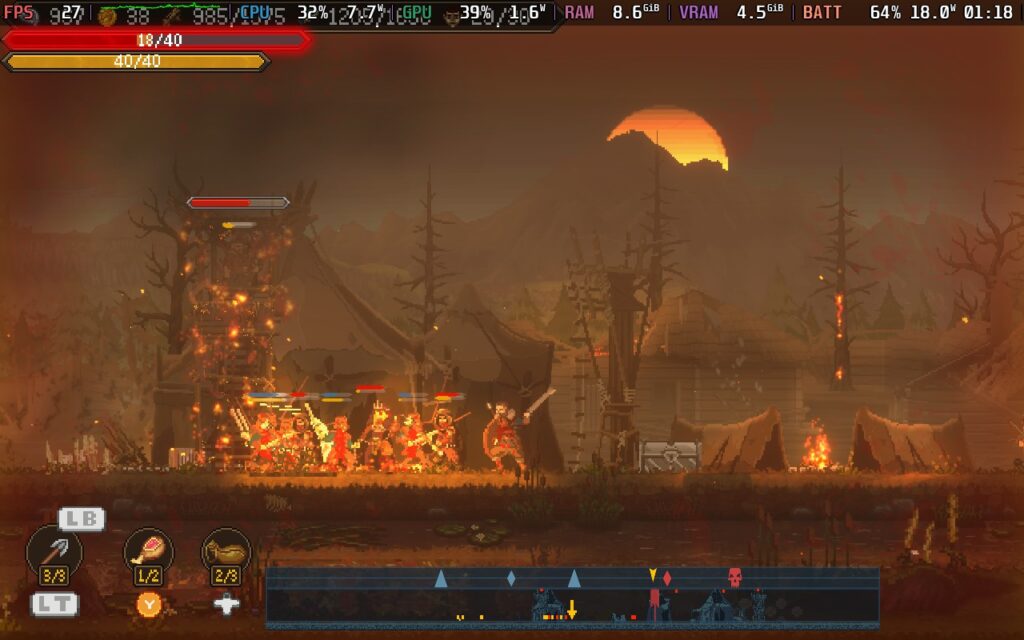
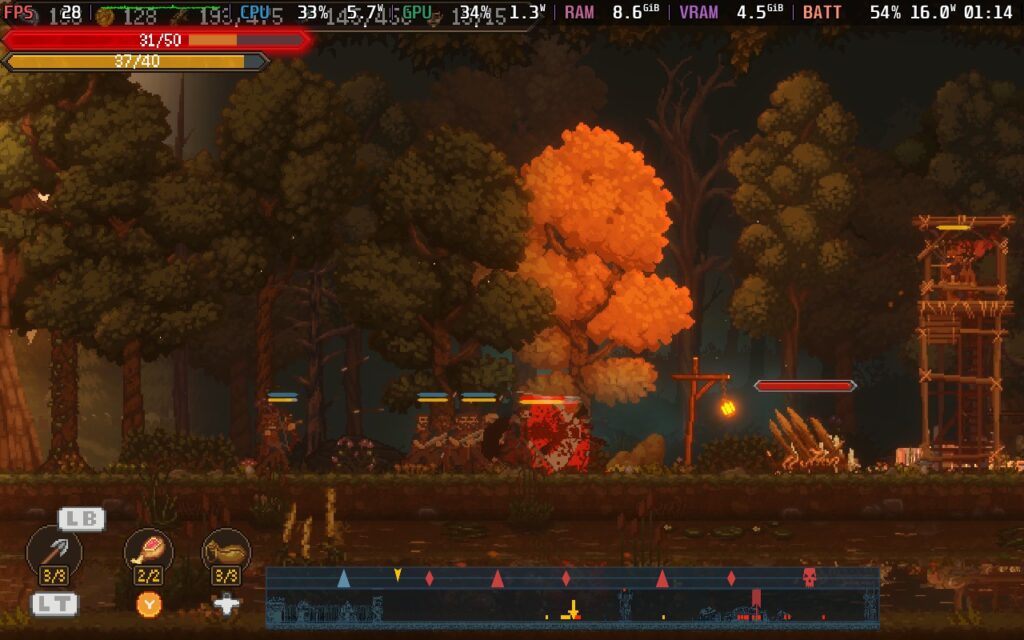
Power draw from the battery varies wildly depending on what's happening in the game and how many troops are on the field. When things are quiet, expect about a 10W power drain, but this goes up to around 19W in combat with many troops. So expect around 2-2.5 hours of battery life from a Steam Deck LCD and about 3 Hours from a Steam Deck OLED. Temperatures also varied greatly, from about 55C up to 75C, depending on the action on screen.
There are rebindable controls; the only option that could be considered "accessibility."
Sons of Valhalla has some decent ideas up its sleeve. Merging strategy and action genres doesn't happen too often. Still, it feels like the developers took their idea and ran without considering whether it worked well. It's almost like there are 2 decent games here have been merged into 1 not-so-decent game.
I could definitely see myself enjoying Sons of Valhalla more if it were a straight-up strategy game or a straight-up action game with the elements of management toned down, but just mushing the two together creates an awkward mix of an uninteresting action game and a difficult-to-manage strategy game, the worst things these two genres can be.
The performance on the Steam Deck is just unacceptably poor. I can only presume the game runs on a single thread, which explains why the situation is so dire. Because of that, I can't really recommend that anyone play this game on the Steam Deck. Once you get to level 3 onwards, you'll regularly be playing at 20-25 FPS at the most pivotal moments of the game, and it makes the experience quite unpleasant.
Hopefully, the performance can be improved with patches, but even then, the game is average at best, so I would still be in two minds as to whether or not to recommend this one to you.
Our review is based on the PC version of this game.
If you enjoyed this review, be sure to check out the rest of the content on SteamDeckHQ! We have a wide variety of game reviews and news that are sure to help your gaming experience. Whether you're looking for news, tips and tutorials, game settings and reviews, or just want to stay up-to-date on the latest trends, we've got your back.
Classified: France '44 was provided by Team17 for review. Thank you!
This game was tested with a Steam Deck LCD. OLED testing is coming soon.
Classified: France '44 is an XCOM-like strategy game set during World War 2. You command a group of allied soldiers from various countries to aid the French Resistance and try to cause as much disruption as possible so the D-Day landings are a success. The game will end in different ways depending on how successful you are with the limited time you have.
You can also do side missions, known as "Special Ops," which are one-off scenarios crafted to give you a specific experience. You can even create your own Special Ops missions or download community-made ones, so that's a bit of fun for those so inclined.
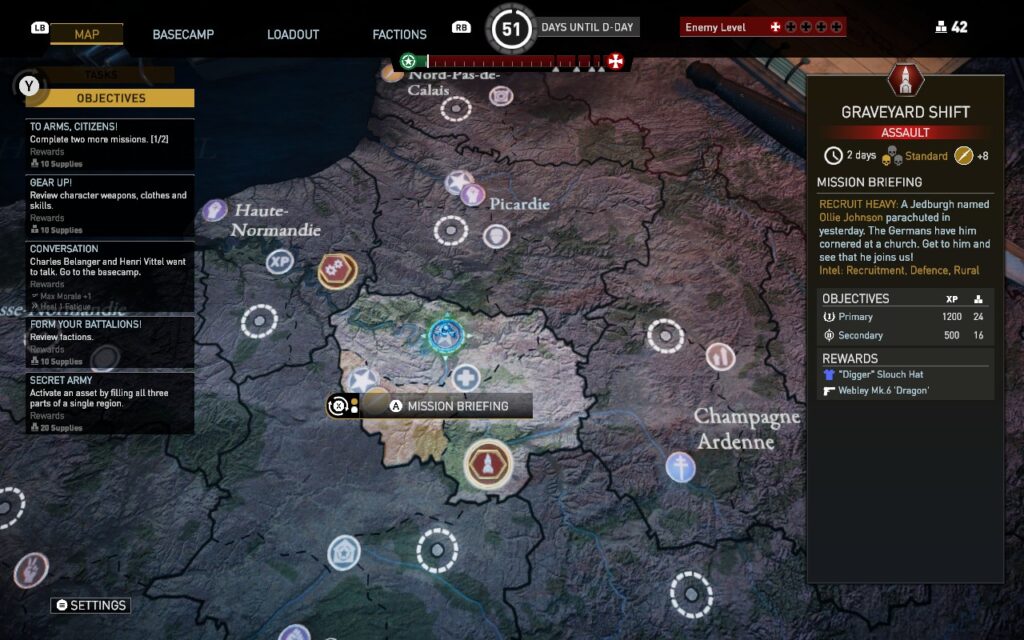
It's an interesting concept, encouraging players to try multiple playthroughs to achieve better outcomes each time. I didn't opt for the higher difficulty option as I'm not great at these tactical strategy games, but even the middle difficulty caused me to fail missions when I made an egregious mistake.
Stealth is a huge factor in Classified: France '44. You are almost always outnumbered in missions, so going in all guns blazing is a surefire way to lose your team. Instead, you are encouraged to remove as many enemies as possible through stealth-like melee kills without alerting other soldiers nearby in most missions.
In addition to health, each character, including enemies, has a "morale" meter. Every time a soldier is shot at, their morale decreases. If it's below 50%, they will become "suppressed" and receive a 50% penalty for their action points. If their morale is depleted, they become "broken" and can't take any action at all next turn. There are actions that you can take to improve morale, however.
This ties back to being as stealthy as possible. If you are a squad of four and suddenly 10 enemies are alerted to you, the sheer amount of fire heading your way will likely deplete your squad's morale in a single turn, quickly leading into a death spiral with the constant enemy fire keeping your squad's morale low. It's frustrating but accurate to how the situation would go.
Your troops aren't magically better than the enemies, and you must use strategy and tactics to keep the upper hand. If you lose the element of surprise early on, it's very easy to lose your squad unless you are positioned well to take cover from enemy fire.
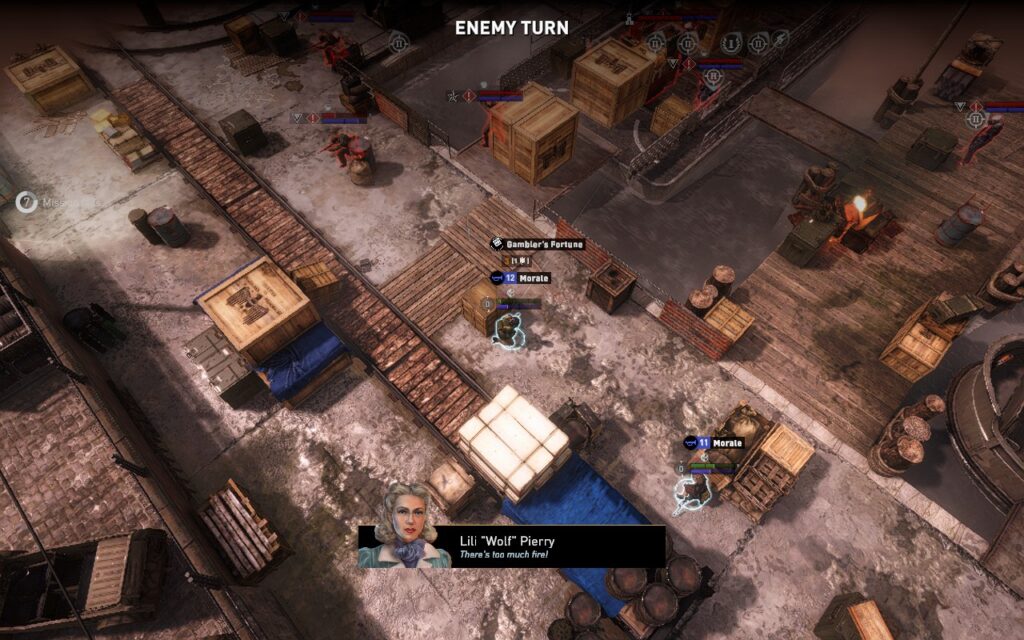
Aside from that, combat is very similar to XCOM. You have a list of abilities along the bottom of the screen, such as firing your weapon, a melee attack, a grenade, and often some kind of support ability to heal or improve an ally's morale. Choosing to attack an enemy will give you a percentage chance to hit, a chance to critical hit, and the respective damage you might do.
The game even adopts a different "cinematic" camera angle when you attack on occasion, just like XCOM. You still get that satisfying moment when your shot hits or you manage to pull off that critical hit you needed to kill an enemy in one blow.
Several different types of enemies are introduced as you play throughout the game. Some resist stealth takedowns, forcing you to alert the enemy if you wish to kill them, adding additional strategy components to each mission. Some enemies behave like the player's troops, where they can be "downed" rather than immediately killed and revived after a few turns. You'll need to keep an eye on all the different enemy types and remember their strengths so you can play tactically.
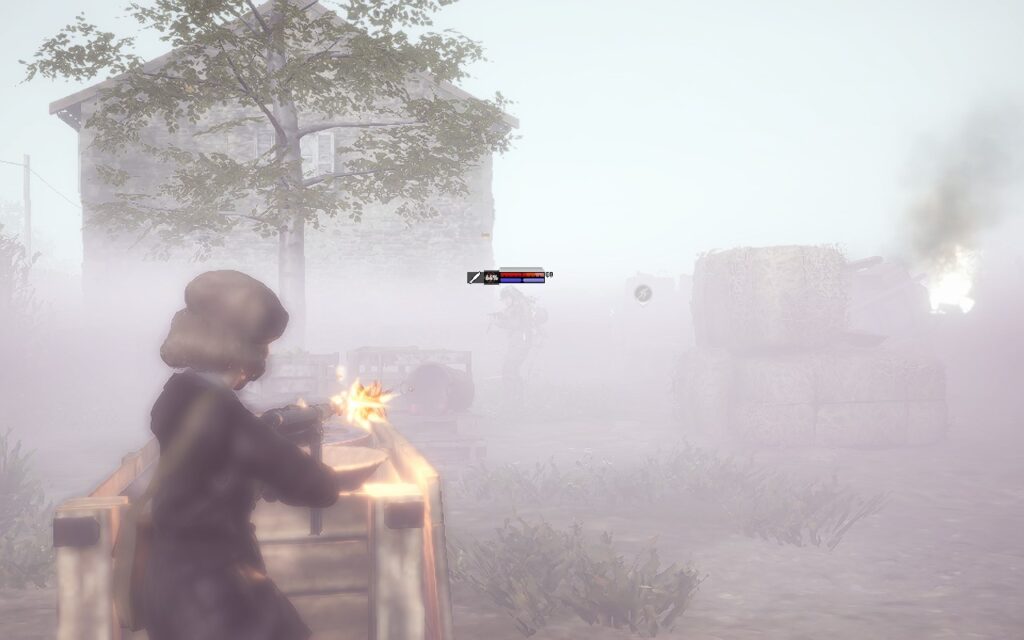
Story-wise, I was a little conflicted. The game tries to portray a realistic depiction of the French Resistance forces during the end of World War 2, even using ethnic slurs for the Germans commonly used by the Allies. But at the same time, the game does like to use witty one-liners. I have no idea how soldiers would have spoken back then, but it does seem strange to let out a "humorous" one-liner as you stealthily cut someone's neck.
It tries to tackle a heavy subject matter, and the gameplay and art style of the game are serious and tactical. Still, the voice-acting can be a little stilted, and every time a character speaks in a scripted way, and not just battle chatter, they just seem so nonchalant about the whole thing, like the war is a bit of fun with "About time I got to blow something up" and "I think I'm going to like it here." The latter, I feel like no one said in France during World War 2. It makes the game feel a bit "Hollywood."
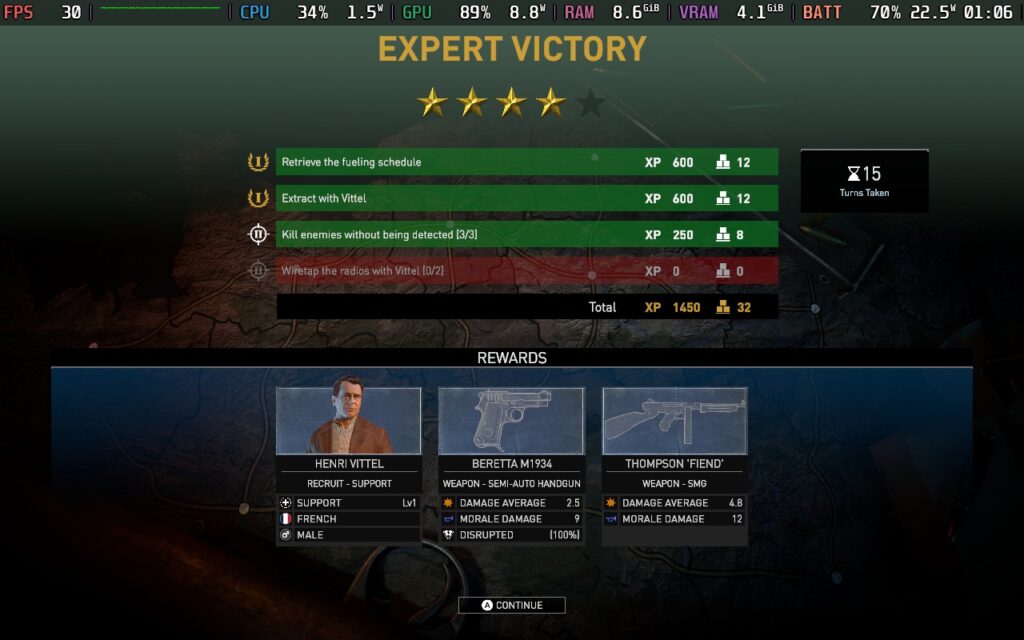
Ultimately, I do quite enjoy Classified: France '44. The missions have a decent variety and design, giving you a chance to shine but punished if you make mistakes. The decisions extend beyond combat, too. When presented with gaining a new squad member, you often have to choose which squad member you take, with the other being lost. Likewise, when your soldiers level up, or you gain new equipment, you will have to pick the right skills and equipment for them that best suit your style of play.
Translating a game like XCOM into a World War 2 scenario, Classified: France '44 does a pretty good job of capturing the sense of being outnumbered and outgunned, which would indeed be the case. Emphasis is put on outplaying the enemy, and you are rewarded for doing so.
Note: You need to use Proton Experimental to play the game. Using the default Proton causes severe performance issues when the camera is moved.
I had some issues with the default controller layout that Steam selected for me, so I would make sure you double-check that you have the "Gamepad with Joystick Trackpad" template selected and applied as your controller layout.
Aside from that, the game gets things right. The controls work fine with the right layout selected, the game supports 16:10 aspect ratio resolution, including the Deck's native 1280x800, and most of the text is readable. However, I did find the text for accuracy, and the text for AP remaining on the character portraits at the bottom left difficult to read on the Steam Deck, and there are no scaling options.
The game does have some flexibility performance-wise. Therefore, I can offer two presets for today: one focused on graphical quality and the other, my recommended preset, which sacrifices graphical quality for extra battery life.
For my recommended settings, you should set SteamOS's FPS lock to 30 FPS / 60 Hz and set a TDP Limit of 7W.
We will sacrifice graphical quality for battery life, so in the in-game settings, we will set the quality to "Very Low," disable V-Sync, disable Anti-Aliasing, and disable Motion Blur. We will also enable FSR and set the Render Scale to 75%. Blood and Gore and FSR Sharpness can be adjusted to your preference.
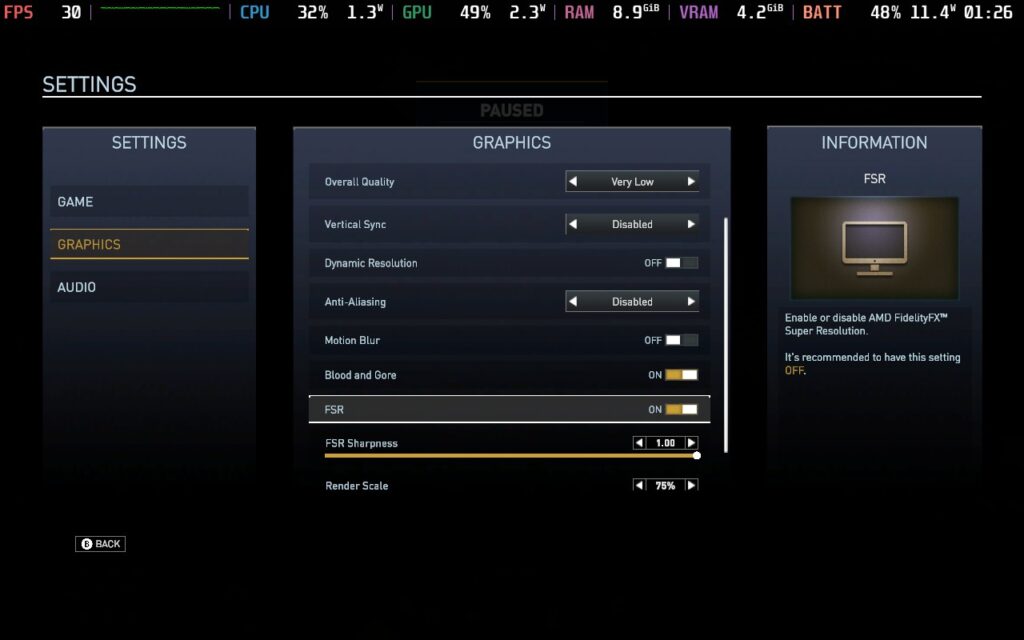
With these settings, the game generally runs at 30 FPS. We do drop frames when the AI is taking turns or when we initiate an action, but the frame drops are fairly momentary, and given the fact that the game is turn-based, it doesn't affect playability whatsoever. It's fairly difficult to eliminate the frame drops, as there are times when the game is CPU-hungry, so in the end, I decided it was best to just accept the frame drops and have a low TDP limit rather than increase the TDP limit just to make the drops slightly less noticeable.
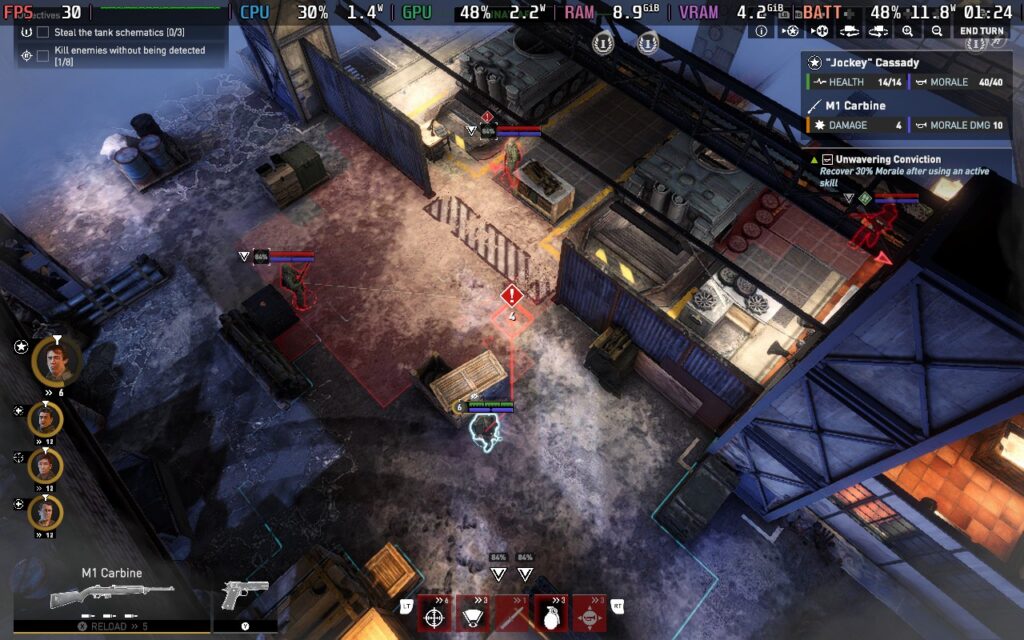
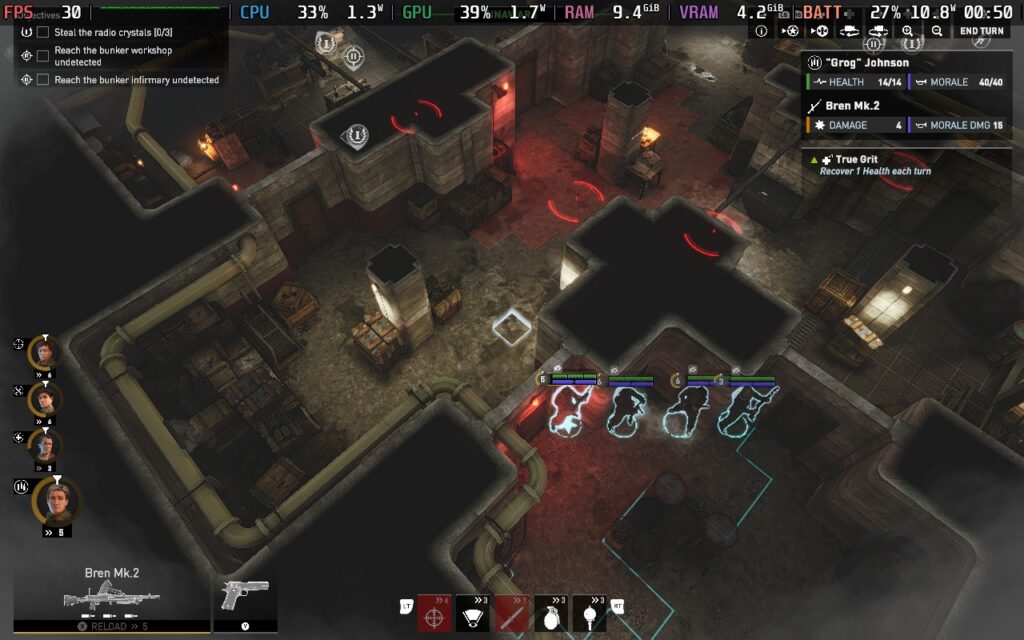
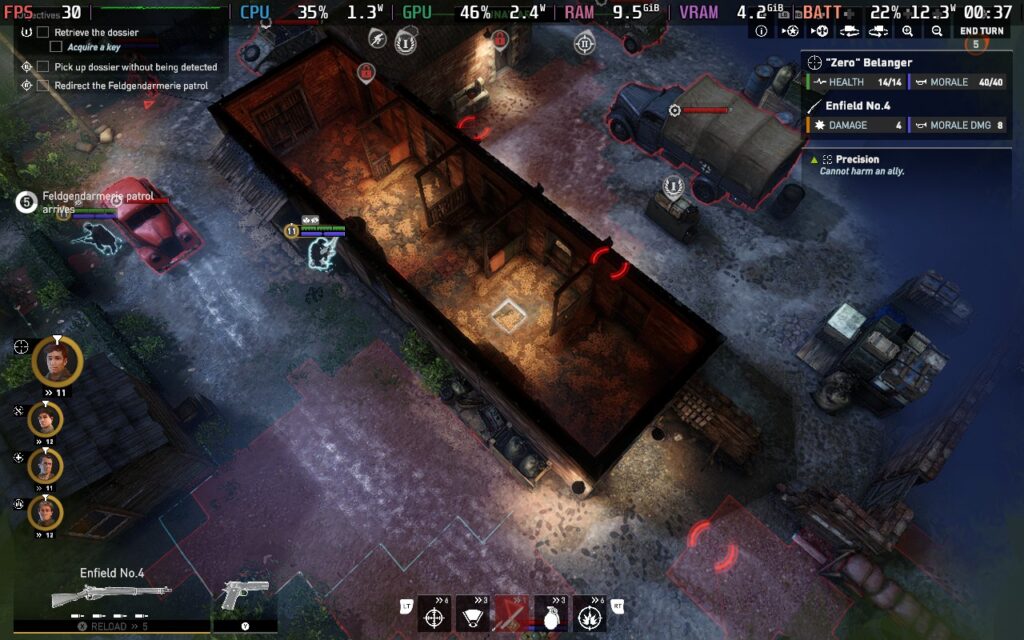
The low TDP limit means we see a power draw that ranges from 11W to around 14W. The game becomes surprisingly easy on the battery, so it wouldn't be unusual to get 3 hours of battery life with these settings, perhaps up to 4 hours on the Steam Deck OLED.
Honestly, the lower graphics settings are barely noticeable to me. The main time I notice the lower graphical quality is if the game uses a cinematic camera for action. Then, it becomes apparent that the textures are quite degraded compared to higher-quality settings.
Temperatures tended to stay in the 65-70C range, so not too hot at all.
If you need that extra visual fidelity, you can push things further and increase your graphics settings, but this will cost you some battery life.
Here, you should set your FPS lock in SteamOS to 30 FPS / 60 Hz again, but this time set a TDP Limit of 11W.
Then, in the in-game settings, we'll set the quality to "Very High," disable V-Sync, set Anti-Aliasing to FXAA, disable Motion Blur, keep FSR off, and set the Render Scale to 100%. Blood and Gore can be adjusted to your preference.
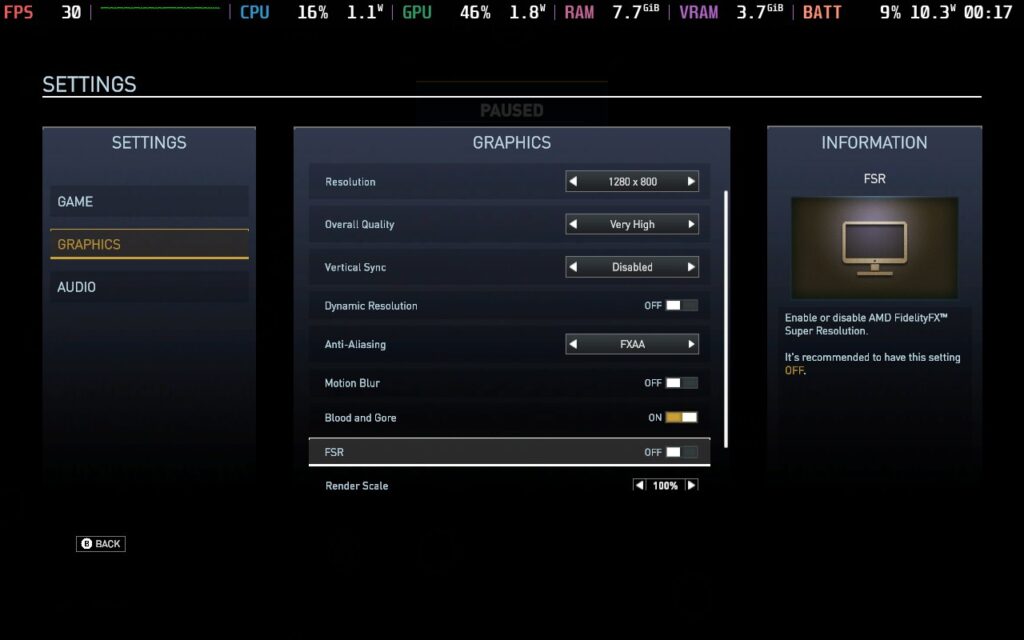
Performance with these settings is very similar to the recommended settings above. We will still experience some frame drops during AI turns when we give our troops actions, but the experience is perfectly playable and smooth when observing the map and making decisions.
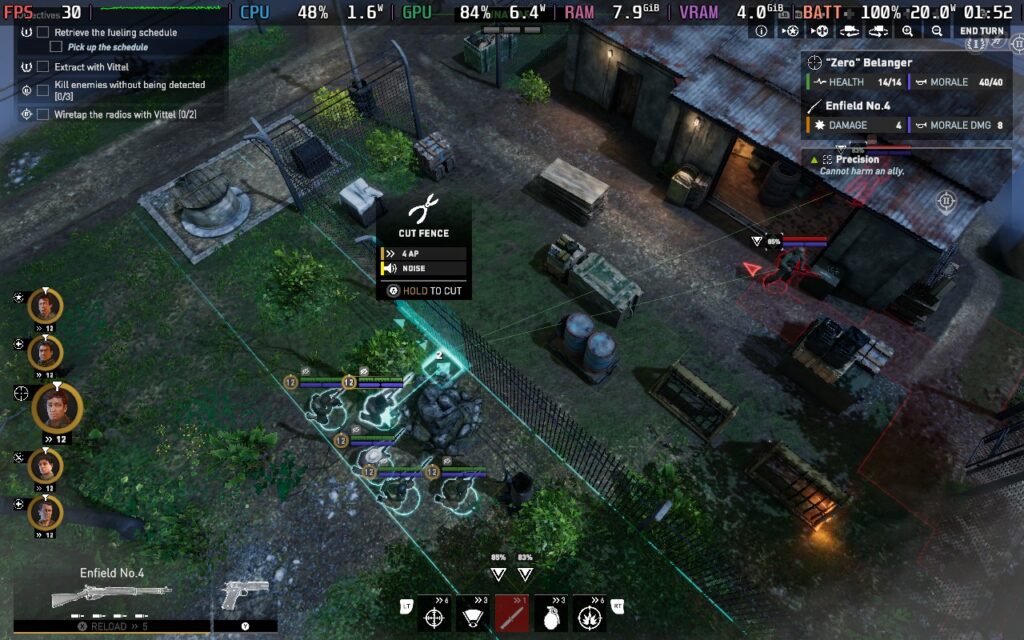
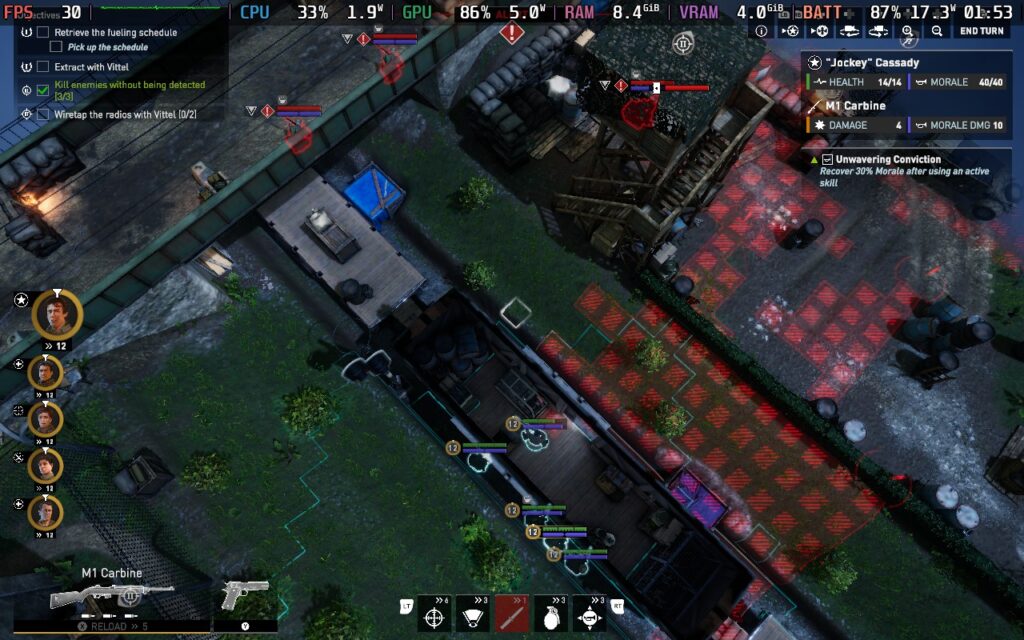
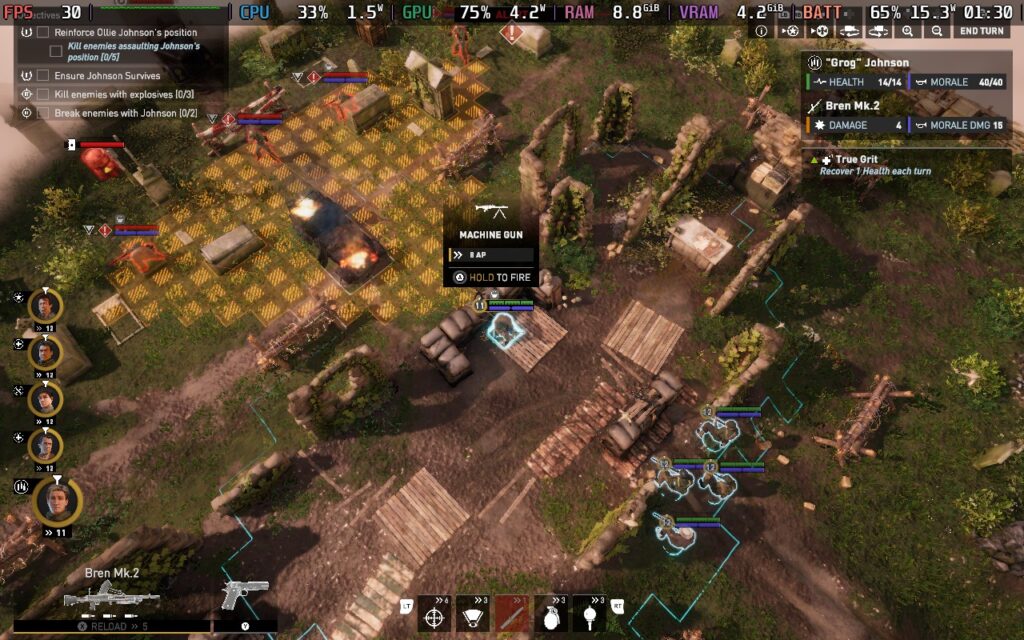
The power draw is quite a bit higher, generally around 16-18W, but it can go up to 20W in intensive areas. I expect around 2 hours of battery life on a Steam Deck LCD and about 2.5 hours on the Steam Deck OLED.
Temperatures increase slightly, mostly within the 70-75C range, so the Steam Deck doesn't get overly hot again. This is likely because the game tends to have bursts of intensity and then calms down when players are making decisions, giving the Deck time to cool.
There aren't any accessibility options in Classified: France '44 besides enabling "Extra Subtitles," which shows subtitles for all dialogue in the game. Most of the game's voiced lines have subtitles always enabled. Sadly, there's no option for UI Scaling as the game could use a 10-20% boost in UI scale to make certain elements more visible on the Steam Deck.
Classified: France '44 achieves what it sets out to do. It aims to bring a story to life of the French Resistance fighting against Nazi occupiers, I'm not entirely sure it portrays things quite how they were, but the basics are there. The gameplay that accompanies the story is solid.
I believe there are plans to expand the game with DLC, so it will be interesting to see if periods earlier in World War 2 are covered, such as the beginning of the French Resistance. The developers confirmed they would never do DLC to allow you to play on the Axis side.
If you're after a game that follows the premise of XCOM but with a few little twists of its own and is set in a slightly more grounded setting, then Classified: France '44 could be the game for you. The game requires genuine planning and tactics and should keep any tactical strategy buff entertained for hours.
Our review is based on the PC version of this game.
If you enjoyed this review, check out the rest of the content on SteamDeckHQ! We have a wide variety of game reviews and news that will help your gaming experience. Whether you're looking for news, tips and tutorials, game settings and reviews, or just want to stay up-to-date on the latest trends, we've got your back.
SteamWorld Build was provided by Thunderful Publishing for review. Thank you!
This game was tested with a Steam Deck LCD. OLED testing is coming soon.
I hadn't had much experience with the SteamWorld franchise before reviewing this game besides playing SteamWorld Dig on the PlayStation Vita many years ago. As it turns out, playing SteamWorld Dig did not prepare me in any way for SteamWorld Build, because whereas "Dig" is a 2D platforming adventure, "Build" is a 3D city builder. And I love city builders!
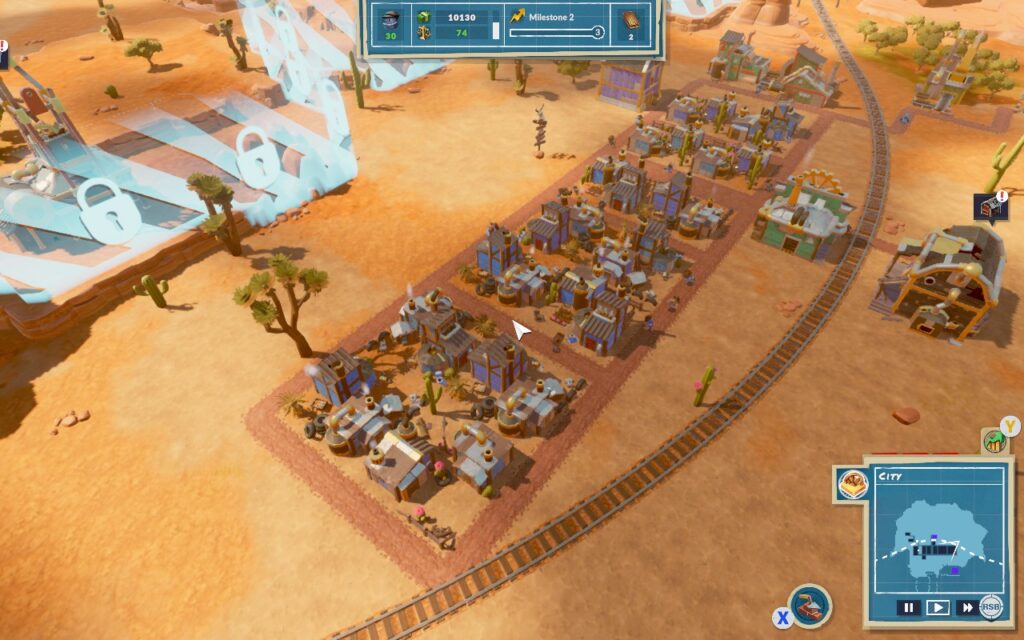
SteamWorld Build takes many cues from other games in the city-building genre, namely the Anno series. It has the same citizen "class" mechanic as Anno, where you start with Workers with fairly basic needs. Once those basic needs are fulfilled, you can upgrade them to Engineers, with more complex needs requiring more production lines and economical management, and you can keep upgrading them further. It also uses an identical "warehouse and road" system as Anno, where your warehouses will store all your economic goods, and production buildings need access to one to work.
As you upgrade your citizens, new buildings and production lines will unlock, creating a satisfying loop with rewards of new opportunities and the ability to progress further to create more complex production lines.
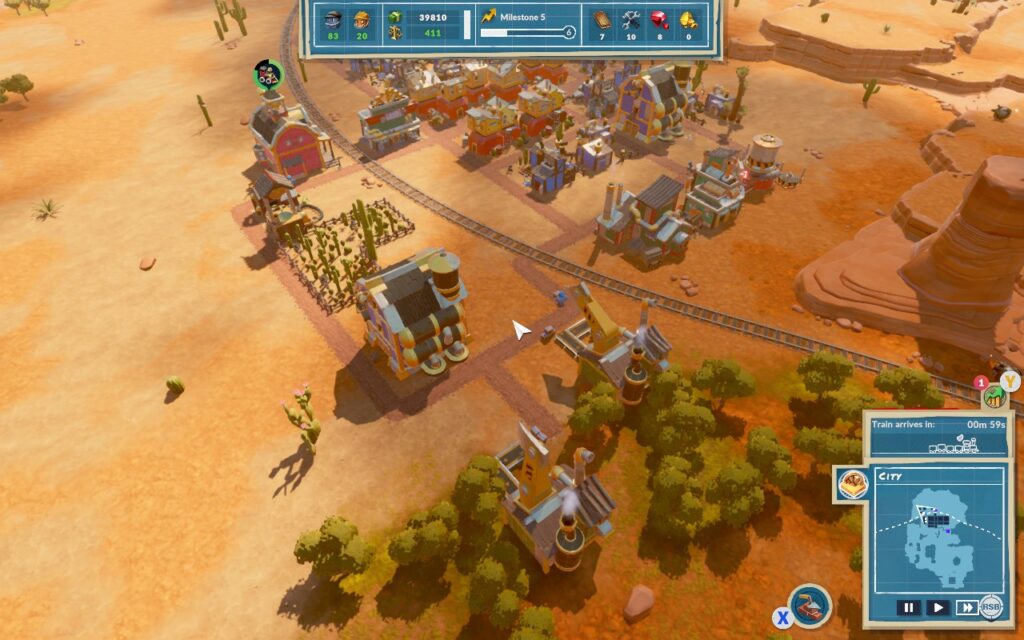
It's not just the surface you need to worry about in SteamWorld Build, as you must watch out for the underground. As you might expect with a SteamWorld game, mining plays a large part in the economy. This means you will have a complete underground section of the game, utilizing miners, prospectors, and mechanics to excavate and harvest any resources your town may need.
The transition between the surface and the mines is seamless, and it's a cool addition to the game. Creating your mine network is both satisfying and rewarding.
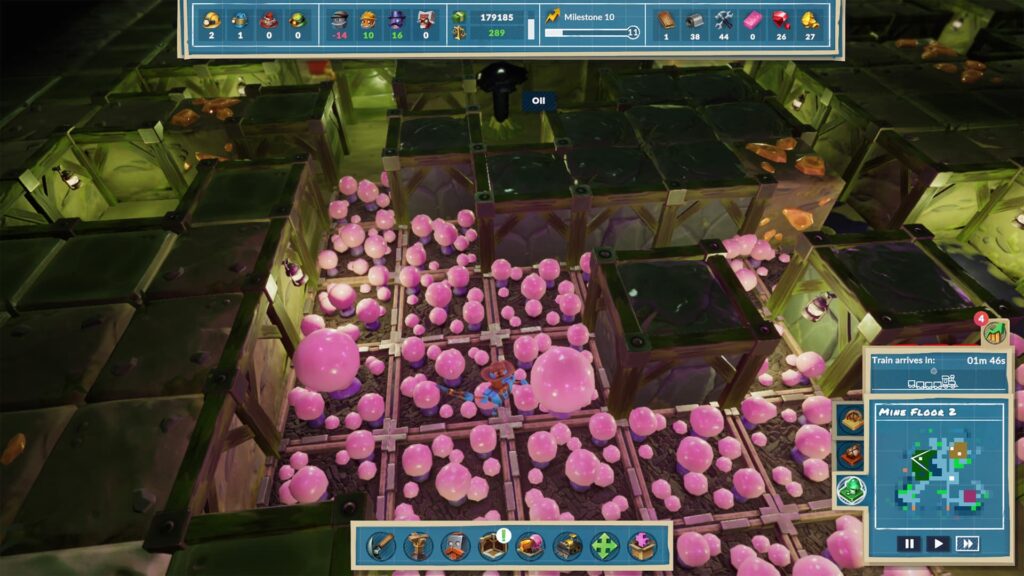
Speaking of "satisfying" and "rewarding," those two words sum up my time with SteamWorld Build. It's a game that rewards the effort you put into it, and the rewards you receive are suitably satisfying. The constant unlocking of new production lines and economic requirements keeps you trying out new things and forces you to push the limits of your logistical network. The visuals are both pleasing and charming despite the world being in a desert that could often be seen as a bland environment.
My first impressions of SteamWorld Build are good. The game boots with a 16:10 resolution, 1280x800 to be precise, and you can fully navigate the menus with a controller.
In the game itself, the controls are just as good. Rather than making you use a touchpad to move a cursor around the screen, you instead use the "X" button to switch between managing UI elements and "cursor" mode, where the cursor is locked to the middle of the screen, and you can move the camera with the analog stick to select buildings. This works well and is much more preferable than using a touchpad to move a cursor around the screen.
There are also a few UI scaling options for tooltips and more. I recommend sliding all of the "scale" options to the max, as that makes them perfectly readable on the Deck's display, and they still don't take up an obnoxious amount of space on the max either.
We don't have too many graphical options to choose from, but there are a few, and they do offer some scalability, so I have two different preset settings that you can choose from, depending on your preference.
First, we'll set a 30 FPS / 60Hz lock in our SteamOS settings, then put a 7W TDP limit on. This 7W Limit holds a pretty constant 30 FPS for us, and we get to set some pretty nice visuals because of the lower framerate.
For these settings, we keep our resolution at 1280x800, turn off V-Sync, and set our Shadow Quality, Texture Quality, Bloom Effect, and Ambient Occlusion all to "High." I'm disabling Motion Blur and Depth of Field out of personal preference, and it also saves some performance. Enable Soft Particles and keep Lod Quality at 50%.
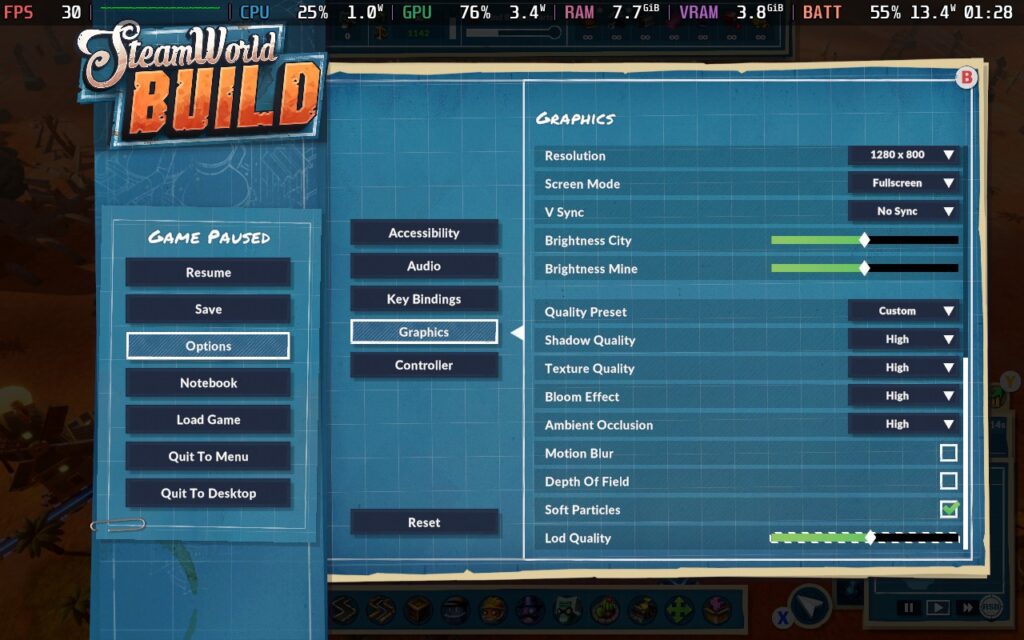
This creates a nice-looking game, with the bloom effect looking especially nice when all the lights on the buildings are lit up. Plus, with our low TDP limit, we still get a decent battery life of just over 3 hours. I can't complain about that!
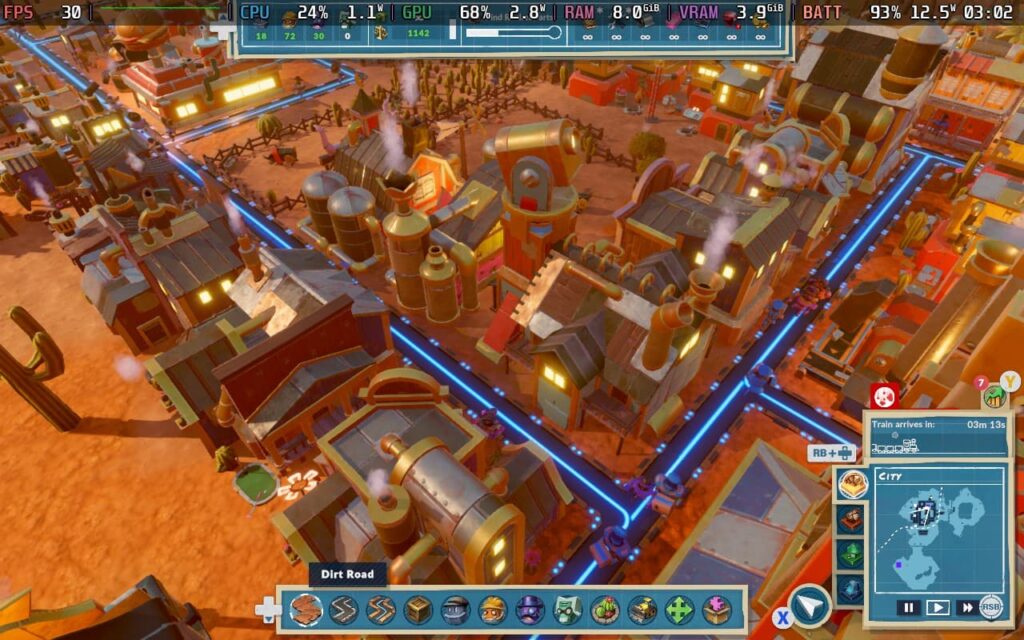
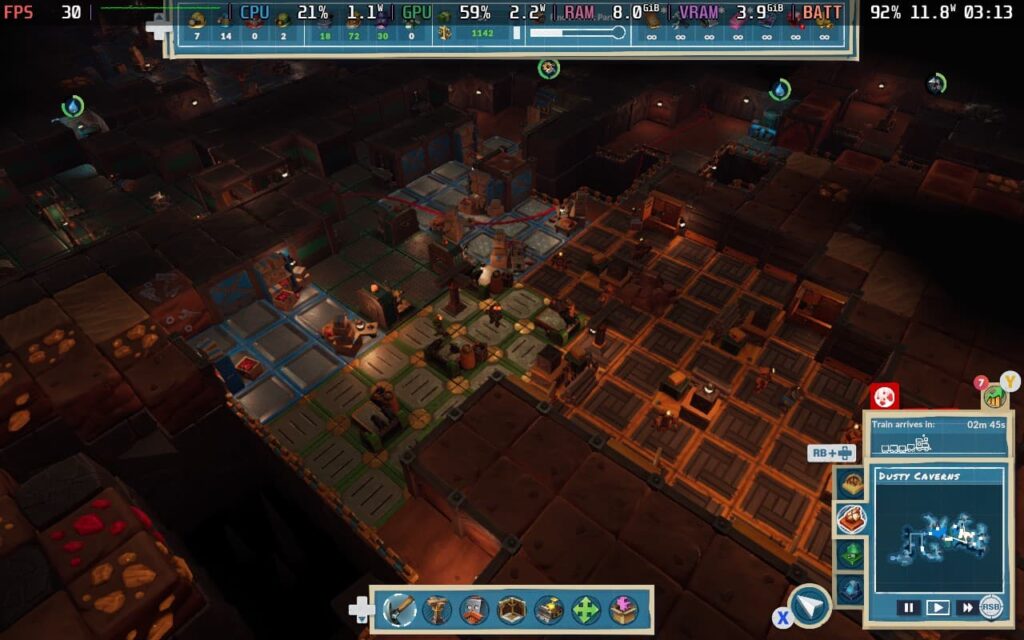
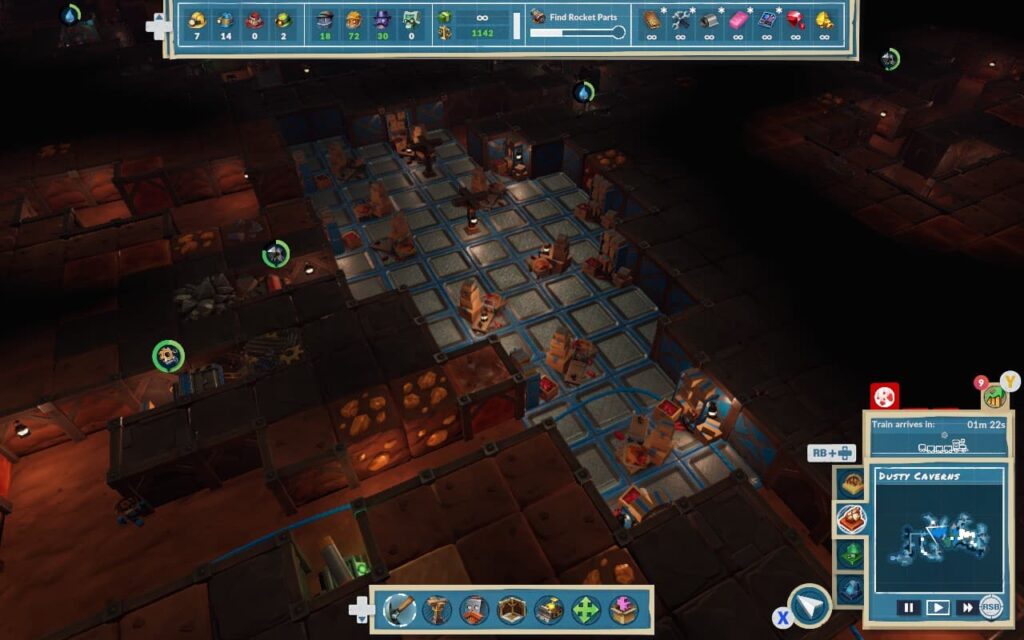
Given the slower-paced nature of this game, I'm recommending the 30 FPS settings that save battery life and allow higher visual quality, but if you're all about that smooth life, here's how you can achieve it.
First set a 60 FPS/Hz lock in SteamOS, and set a TDP Limit of 10W.
We're keeping our resolution at 1280x800, disabling V-Sync, setting Shadow Quality to "Off", Texture Quality to "High", Bloom Effect and Ambient Occlusion to "Off". We're then disabling Motion Blur, Depth of Field, and Soft Particles, and we're keeping Lod Quality at 50%.
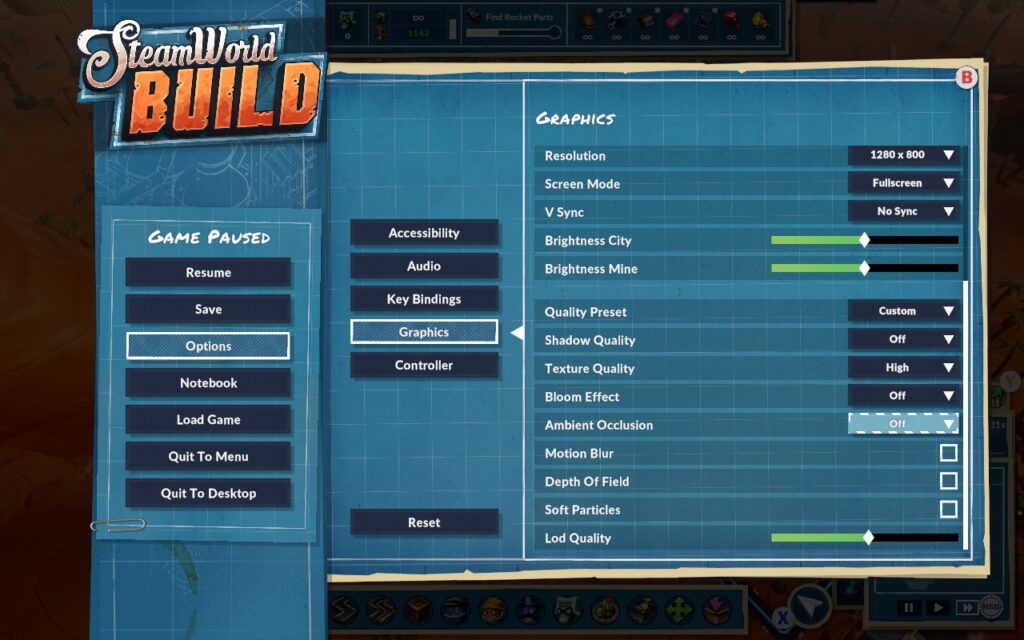
We can just about hold 60 FPS in a fairly large city using these settings. In my experience, FPS increases when underground, so if your city runs well, your underground areas should be fine. Our battery life does take a hit for trying to hold 60 FPS, though, and you shouldn't expect much more than 2 hours out of a full charge.
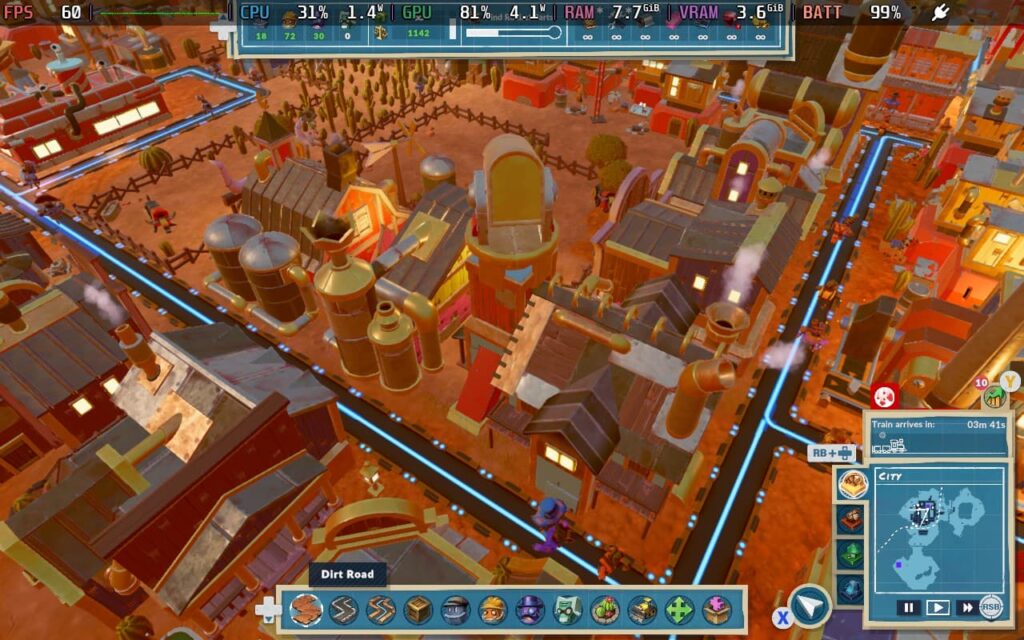
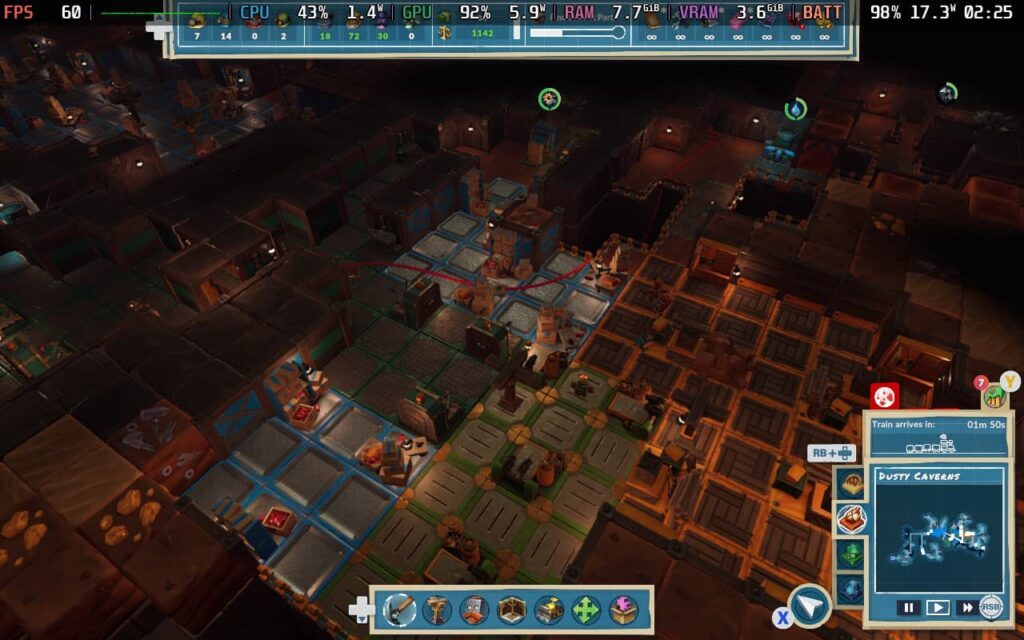
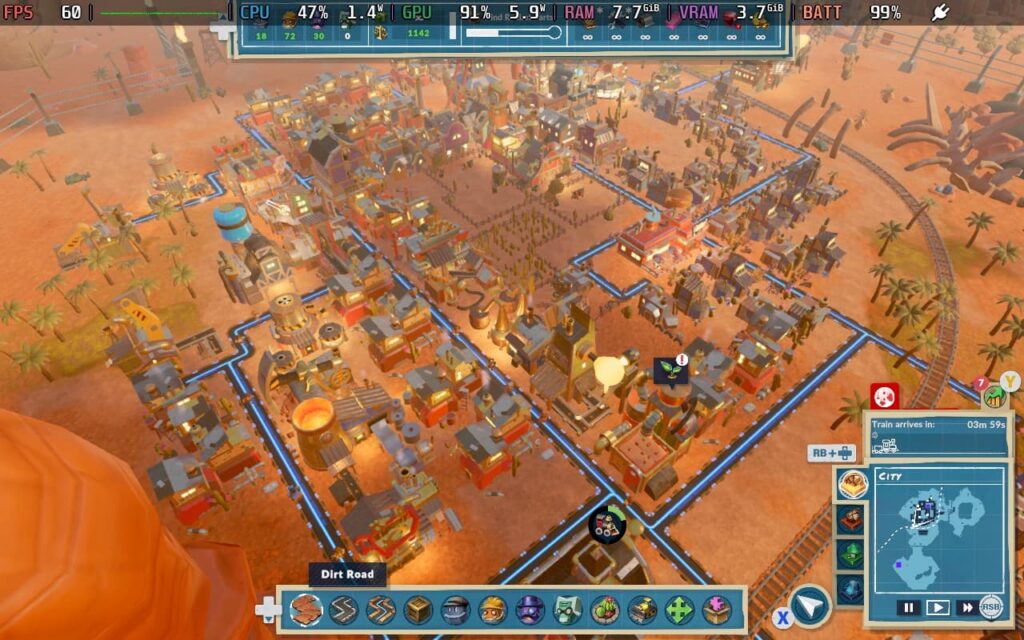
SteamWorld Build has an accessibility menu that has a few options for you. It allows the disabling of screen shaking, changing between Xbox and PlayStation buttons, camera movement speed, and the UI scaling settings that we recommend you set to 100% for Steam Deck. You can see how I had my settings set below.
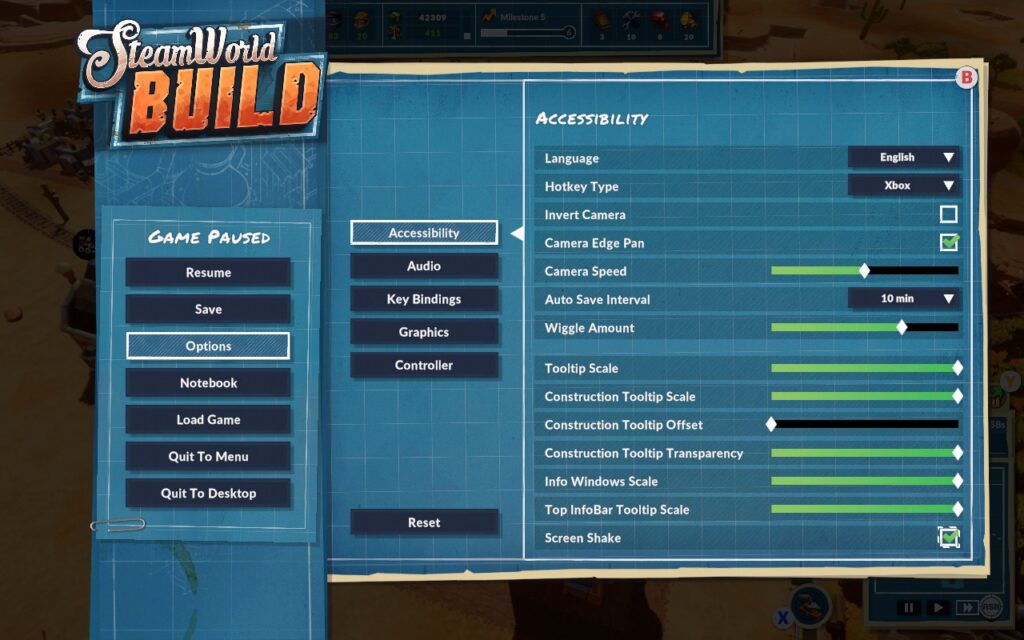
SteamWorld Build doesn't revolutionize the City-Builder genre, but it does put another feather in its cap. This isn't the best game in the genre, but it's worth checking out if you want a city builder that's perhaps not as complex as Anno or as performance-intensive as Cities Skylines. This game is a treat to play on the Deck. The controls work well, the graphics look good, and the gameplay loop is satisfying.
As of writing this review, it holds "Mostly Positive" user reviews on Steam and has a Steam Deck compatibility rating of "Playable". The only reason it isn't "Verified" is because of small in-game text. However, I think the text is pretty readable with the UI scaling set to 100%.
So, if you're looking for a city builder to sit back and relax with on the Deck, give SteamWorld Build a spot on your list!
Our review is based on the PC version of this game.
If you enjoyed this review, be sure to check out the rest of the content on SteamDeckHQ! We have a wide variety of game reviews and news that are sure to help your gaming experience. Whether you're looking for news, tips and tutorials, game settings and reviews, or just want to stay up-to-date on the latest trends, we've got your back.
RAILGRADE was provided by the publisher for review. Thank you!
I haven't played many Logistics management games recently, but I fondly remember Transport Tycoon in the 90s. Sadly, the genre seems to have slipped into a bit of a lull since the early 00s. Fortunately, RAILGRADE is here to bring back some of that logistical goodness, and I couldn't be happier.
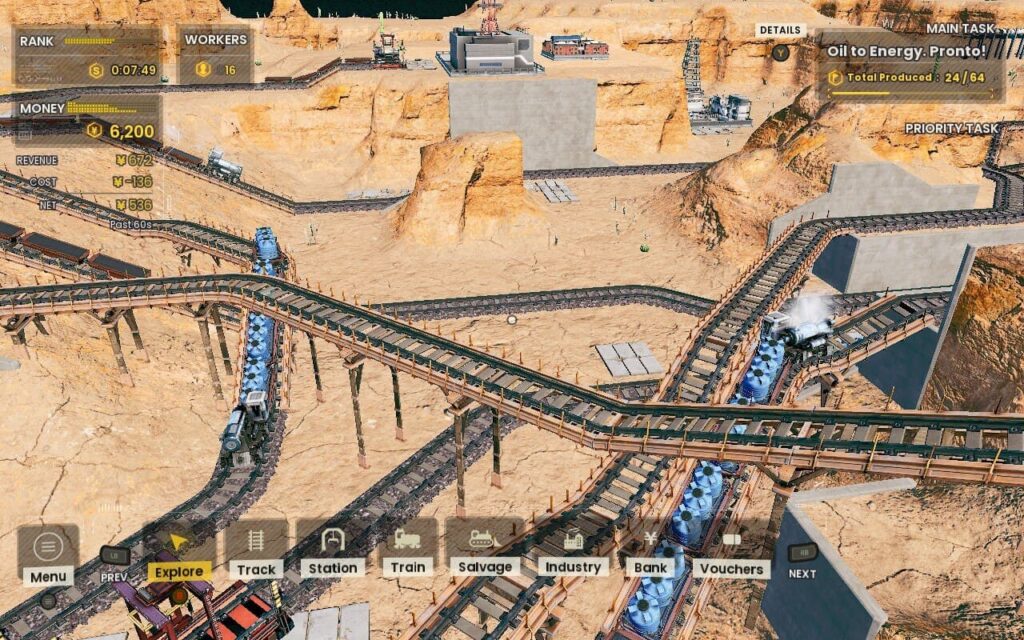
You're greeted with a rather surprising electronic soundtrack when first booting the game. It fits the theme of greasy/oily trains working hard, and although I was surprised, I quite enjoyed the energetic music encouraging me to build the best rail network the land has ever seen.
RAILGRADE runs on tried-and-true gameplay mechanics, conforming to a simple supply and demand system, with a few changes here and there. A basic example of this is the Oil production chain. Oil Wells produce Oil, which should then be taken to an Oil Power Plant. The Power Plant will then produce Energy, which can be taken to the "Zeppelin" and exported for money. While this is a standard loop for this type of game, RAILGRADE switches it up with Catalysts and Upgrades.
Catalysts are secondary goods that industries can provide to boost their performance. For example, Oil Wells and Oil Power Plants can deliver Water to them. This isn't necessary for them to run, but if you supply them with water, they'll work faster and produce more resources. Upgrades can be obtained by paying in-game money to improve an industry's production and storage capacity, meaning it can supply more or larger trains. These spiced up the experience and made it feel much more unique with my playthroughs.
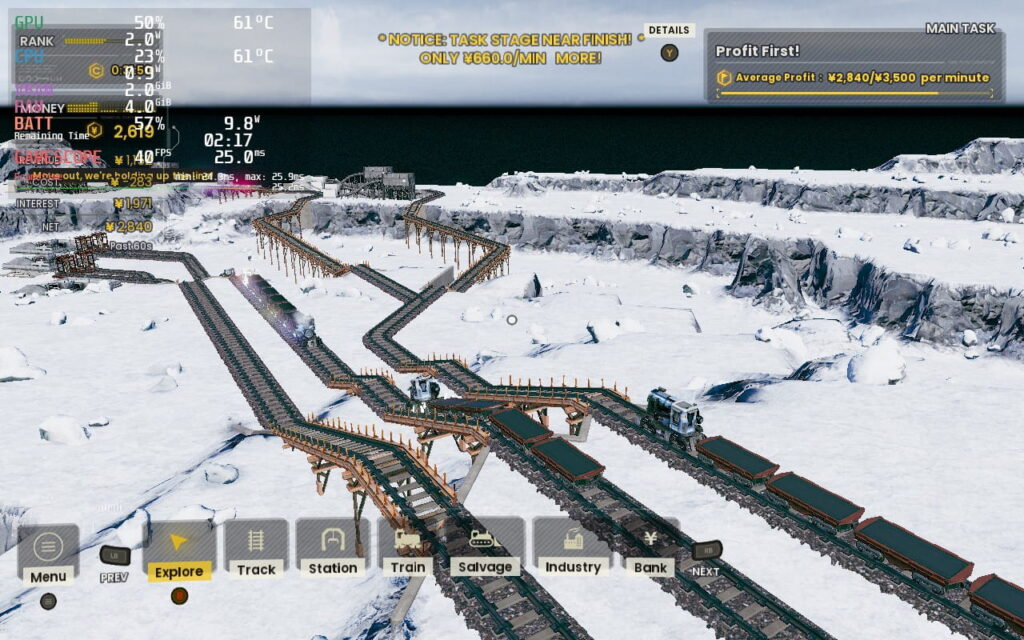
The game also features a "voucher" system. Vouchers are rewards for doing well in the game's missions. Each mission has a ranking system from C to S. Getting a good rank means you get rewarded with vouchers, which can be exchanged for new train engines, new industry upgrades, new songs, and more! The exciting progression offers new ways to create a better rail network. You can also replay missions, giving you another chance to craft a better track and a higher score.
I had a great time playing RAILGRADE, and it's a competent management experience. And with more updates promised by the developer, the game will keep giving in the future!
RAILGRADE runs and looks excellent on the Steam Deck. Even on low settings, the game looks appealing and returns fantastic battery life results. We can reach 60 FPS on higher settings if we run at a higher TDP and sacrifice some battery life.
The menu layout is simple and practically designed for a gamepad, and the controls work beautifully with the Deck; you shouldn't have any trouble controlling the game with the default controls.
16:10 resolutions are also supported, so there are no black bars for you to worry about above and below the screen. We can change many graphics settings and scale the UI, although I found the default UI scale to be just fine for the Deck's display.
RAILGRADE is a strategy game where 60 FPS isn't strictly necessary to have a good time. 40 FPS is a perfect target to aim for, and in my experience, I barely noticed the lower framerate when playing.
This means we can save some battery life, but first, we'll need to drop settings down to compensate. We'll want everything on the low setting except Texture Quality, which we'll keep at Supreme.
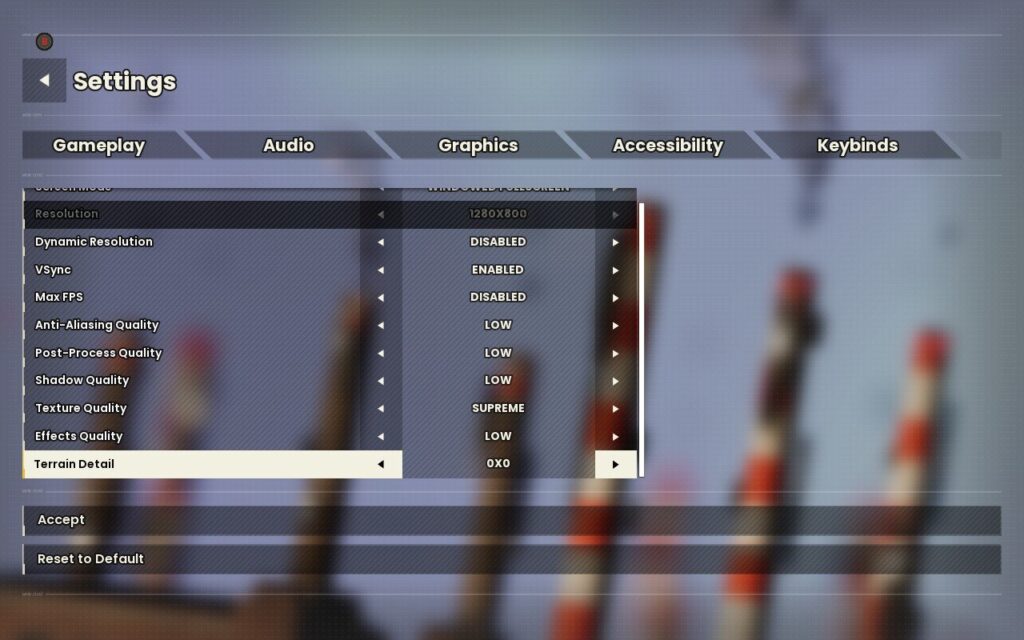
In SteamOS, you'll want to set a refresh rate and Frame Lock of 40FPS/Hz. We can lower our TDP down to 5W now, which gives us a significant saving on battery life for not much visual sacrifice, in my opinion.
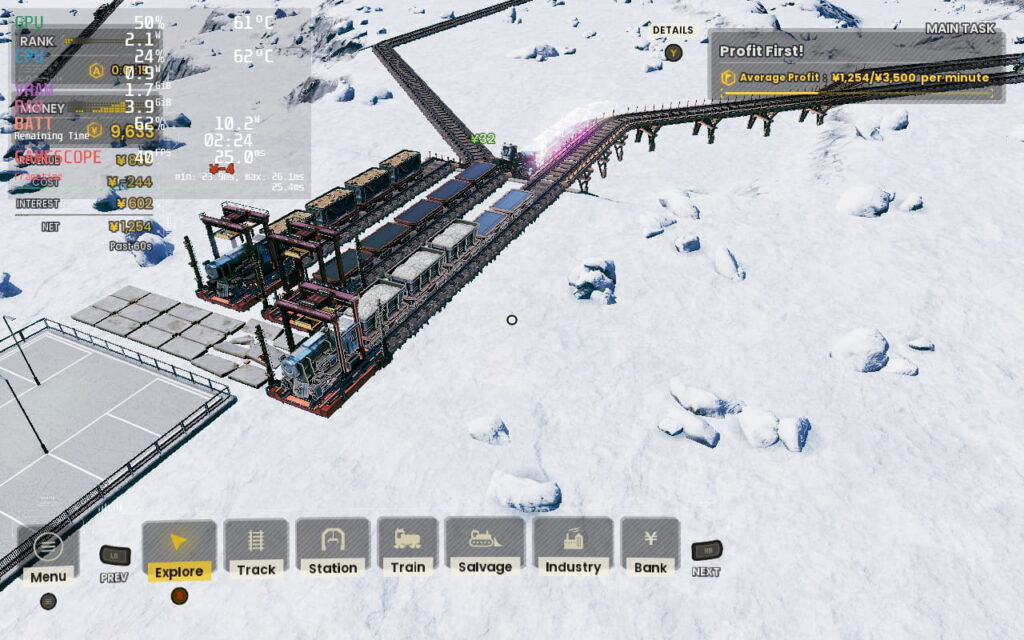
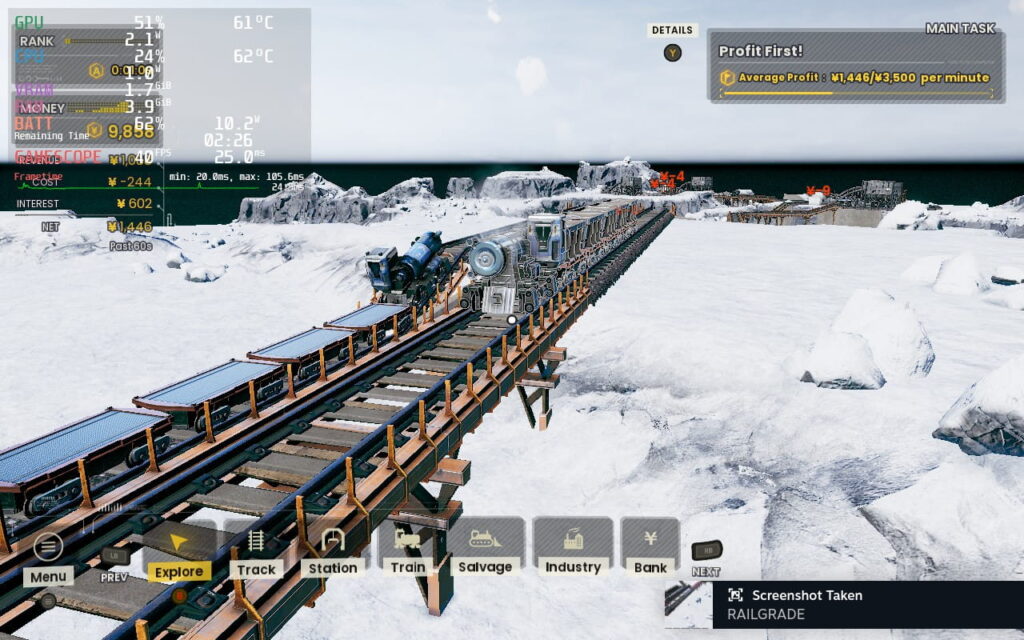
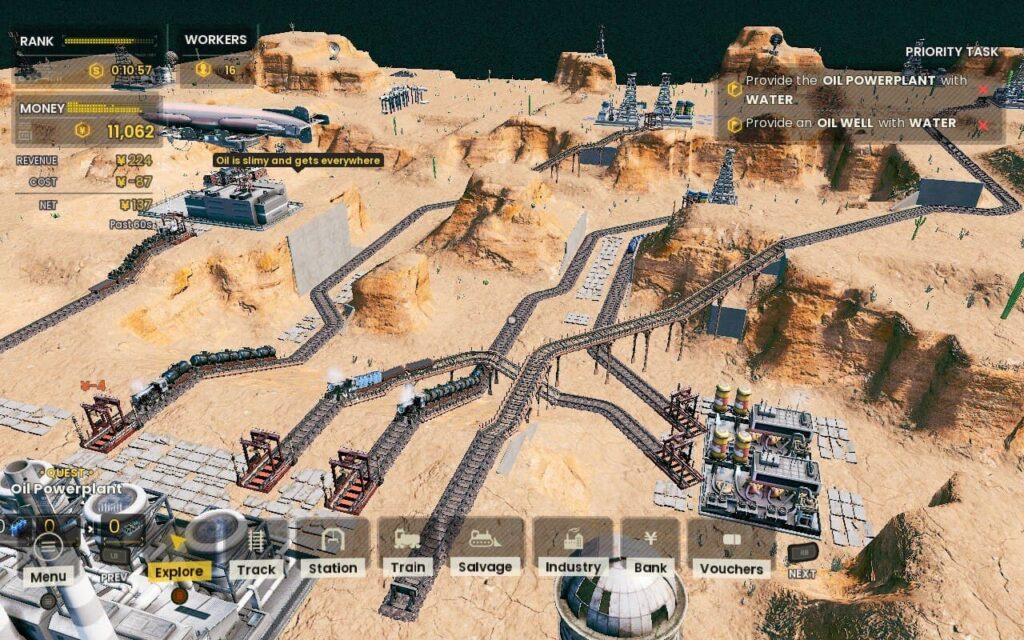
I much prefer to lose the graphical niceties and drop to 40 FPS to gain close to 2 extra hours of battery life. With these settings, you can run the game for around 4 hours.
Since the game isn't too demanding of a title, we can avoid having pretty high settings while maintaining 60 FPS. We don't even need to hammer the battery that hard. Here, we're disabling Dynamic Resolution, Enabling VSync, Disabling the in-game FPS cap, and setting AA to Low and Terrain Detail to 0x0. Everything else should be set to Supreme quality. Here's an image for you to copy the settings if you wish.
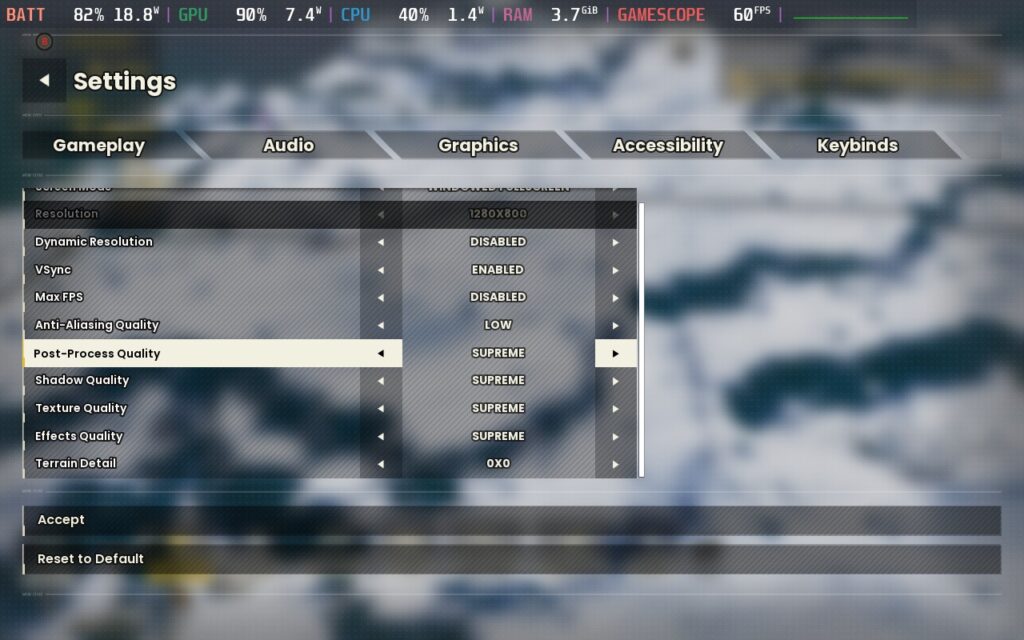
You'll also want to put a Frame Rate limit of 60 in SteamOS and a TDP Limit of 10W.
With these settings, we get a good-looking game, and we can still hit 60 FPS most of the time, with occasional dips to 57 or 58 FPS if we zoom out and spin the map. I expect around 2 and a half hours of battery life at these settings, which is pretty good.
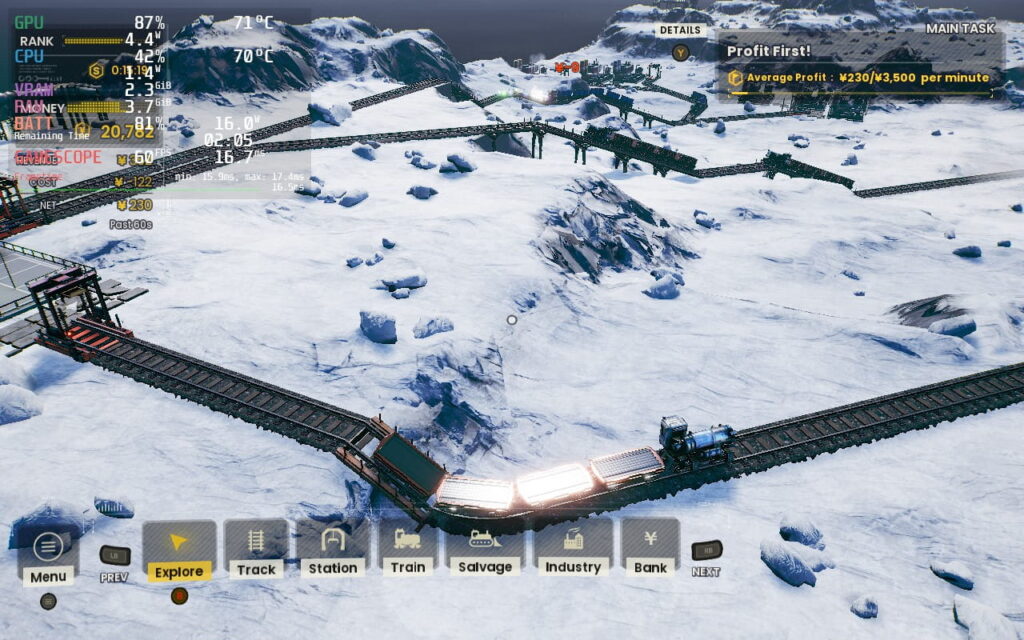
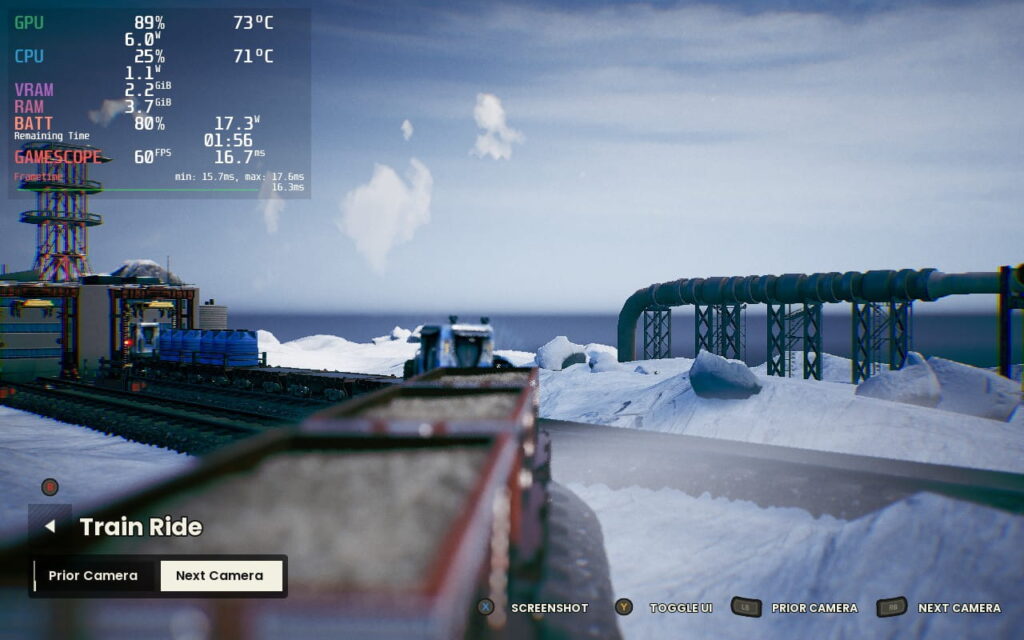
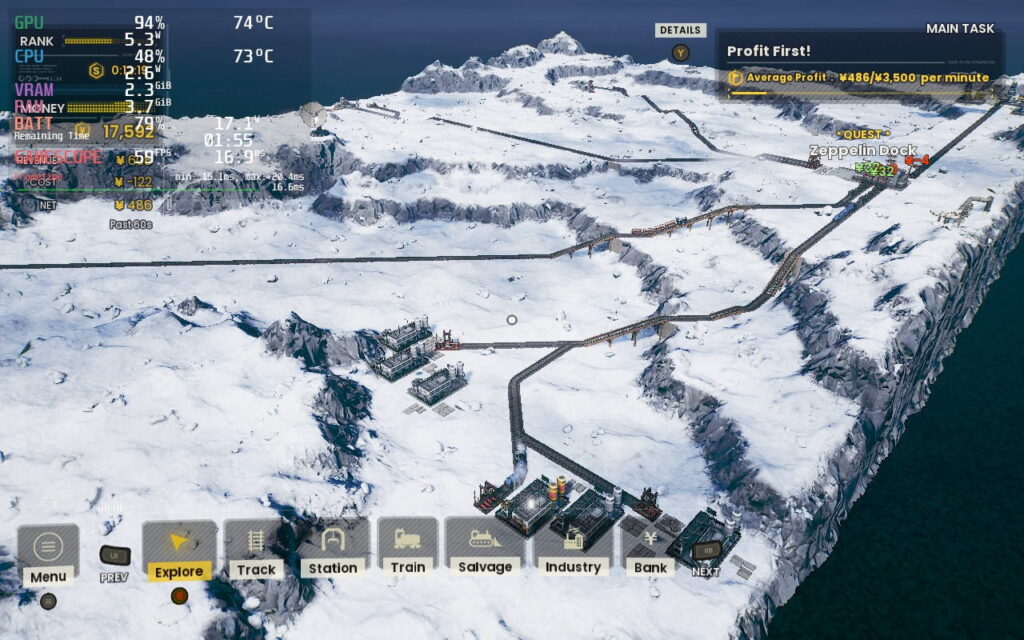
There are a couple of excellent accessibility features included in the game. You can adjust the UI Scale between 70-150%. However, I found 100% to be just fine on the Steam Deck, with the UI already being a pretty generous size. You can also disable the Day/Night effect, which may help some people with impaired vision. We also have a streamer mode for disabling copyrighted music and remappable controls, although the preset controls worked well for me.
RAILGRADE is a fantastic little strategy game. The story mode is enjoyable, with a great progression system. I would have loved to select an environment type and generate a random map with a few customizable settings, and a free-play mode would be great. Still, the developer has stated they plan to add a sandbox mode to the game with procedurally generated maps. There are no details on when this will be.
The gameplay loop in RAILGRADE is satisfying, allowing you to gradually unlock better and more capable trains, improve your facilities/industries, and keep aiming for that best rank on each mission. It's all about creating efficient rail networks; if you have the mind for it, it will be a blast. The missions feel designed so that achieving the best rank on the first try will be difficult, encouraging you to go back with better trains and aim for that high score... or maybe I'm just not very good at it? Who's to say? Regardless, sitting back and seeing your complicated rail network just work is a great feeling.
Ultimately, this is a solid game and one well worth checking out if you like logistics management games, and it runs great on the Deck!
Our review is based on the PC version of this game.
If you enjoyed this review, be sure to check out the rest of the content on SteamDeckHQ! We have a wide variety of game reviews and news that are sure to help your gaming experience. Whether you're looking for news, tips and tutorials, game settings and reviews, or just want to stay up-to-date on the latest trends, we've got your back.